
From a Sketch by W. L. Wyllie, A.R.A. For The Sportswoman's Library.
PUNTS RACING.
(THE START.)
The cover image was created by the transcriber and is placed in the public domain.
The Sportswoman's Library.
Vol. II.

From a Sketch by W. L. Wyllie, A.R.A. For The Sportswoman's Library.
PUNTS RACING.
(THE START.)
EDITED BY
FRANCES E. SLAUGHTER.
VOLUME II.

WITH ILLUSTRATIONS BY
W. L. WYLLIE, A.R.A., CUTHBERT BRADLEY,
AND FROM PHOTOGRAPHS.
WESTMINSTER:
ARCHIBALD CONSTABLE & CO.,
NEW YORK:
LONGMANS, GREEN, & CO.,
1898.
DEDICATED
BY PERMISSION TO THE
MARCHIONESS OF WORCESTER
A KEEN SPORTSWOMAN AND WIFE
OF ONE OF THE FOREMOST
SPORTSMEN OF THE AGE.
BIRMINGHAM:
PRINTED AT THE GUILD PRESS. 45, GREAT CHARLES STREET.
THE SPORTSWOMAN'S LIBRARY.
Vol. II.
| Preface. | ||
| 1. | Cruising and Small Yacht Racing on the Solent. | Miss Barbara Hughes. |
| 2. | Punt Racing. | Mrs. W. L. Wyllie. |
| 3. | In Red Deer Land. | Mrs. Penn-Curzon. |
| 4. | Chase of the Carted Deer. | The Editor. |
| 5. | Women's Hunters. | The Editor. |
| 6. | Otter Hunting. | Mrs. Wardell. |
| 7. | Salmon Fishing, with Notes on Trout and Coarse Fishing. | Susan, Countess of Malmesbury. |
| 8. | Fly Fishing. | The Editor. |
| 9. | Driving. | Miss Massey-Mainwaring. |
| 10. | Cycling. | Mrs. A. C. Hills. |
| 11. | Fancy Figures and Musical Rides. | Miss Van Wart. |
| 12. | Tennis. | Miss Maud Marshall. |
| Appendix A. | Glossary of Nautical Terms. | |
| Appendix B. | Rules of Lawn Tennis. |

When I look at the completed MSS. of the first volumes of the Sportswoman's Library, I feel deeply grateful to the many good sportswomen who have aided me in my work, not only for the great stores of practical knowledge they have brought to bear on the several subjects of which we have treated, but for the way in which they have collaborated with me. For this my warmest thanks are due to them one and all.
The object we have placed before us, is to give women the information and help they are not likely to find in those books, which are written chiefly from a man's point of view, and we have therefore avoided, as far as possible, trenching on ground that has been already adequately covered by those who, to sportsmen and sportswomen alike, are the best authorities on the various subjects. If, therefore, our writings sometimes seem to be wanting in completeness, it[Pg xii] is, I venture to think, to be attributed to this cause.
When I first gathered round me the body of contributors, some of whom were personally unknown to me, I could but feel that the many threads I held in my hand might prove to be a very "tangled skein," before the work was brought to completion. This foreboding, however, I am glad to say, was entirely without foundation, for each writer threw herself into her part with such genuine determination to do the best she could for the matter of her work, that the minor details as to the manner in which it should be given to the world, did not assume undue proportions, and there has been nothing to throw the slightest shadow over the harmony in which we have worked. That the effort we have thus jointly made to give some help to our sister-sportswomen may be successful, is to wish the writers the best reward they can have, for the labour they have bestowed.
Besides my fellow workers, I have a debt of gratitude to discharge to all who have so kindly assisted me. Foremost among these I must acknowledge the valuable help given by Lady Gifford, Mrs. Pryse-Rice, Mrs. Cheape, and[Pg xiii] Miss Lloyd, of Bronwydd, without whose assistance I could not have ventured to write on the subject of Hare-Hunting: by Mr. T. F. Dale, author of The Game of Polo, whose great practical knowledge of sport has made him an invaluable referee on many important questions: by another good sportsman, Captain the Hon. R. C. Drummond, who generously gave me the benefit of his advice on matters which have been a lifelong study to him: by Elizabeth, Lady Wilton; Lady Theodora Guest, Lady Gerard, Lady Dorothy Coventry, Mrs. Wrangham, Mrs. T. E. Harrison, Miss Serrell, Mr. C. H. Bassett, late Master of the Devon and Somerset Staghounds; Mr. Ian Heathcoat-Amory, Master of the Tiverton Staghounds; Mr. W. L. Wyllie, A.R.A.; Miss Maud Earl, Miss Walrond, Mr. Cuthbert Bradley, Dr. Lewis Mackenzie, Miss Florence Ritson, and Mrs. Dudley Smith.
I must also acknowledge the help so readily given by Mr. Charles Lancaster, and Messrs. Holland and Holland, on the sport with which their names are so closely connected, and I must thank those photographers who have exercised their skill on our behalf, viz.: Messrs. Lombardi and Co., who, from the first, have helped us[Pg xiv] largely; Messrs. Lambert Weston, J. Weston and Son, Stuart, Becken, and A. Debenham.
My thanks are also due to the Proprietors of Baily's Magazine, The Field, The Gentlewoman, and The Lady's Pictorial.
Lastly, I must discharge the debt of gratitude I owe Messrs. A. Constable and Co., for the unfailing courtesy I have met with at their hands, and for the hearty way in which they have thrown themselves into the interests of the book.
Whether we have all succeeded in our object, viz., to give clear, practical directions to women in the several outdoor recreations of which we have written, it is for our readers to determine, and on their verdict will depend the extension of our plan to other branches of sports and pastimes.
To the great body of sportsmen, who so far have held almost undisputed sway in the realm of sporting literature, I would plead:
The Editor.
Beeding,
March 31st, 1898.
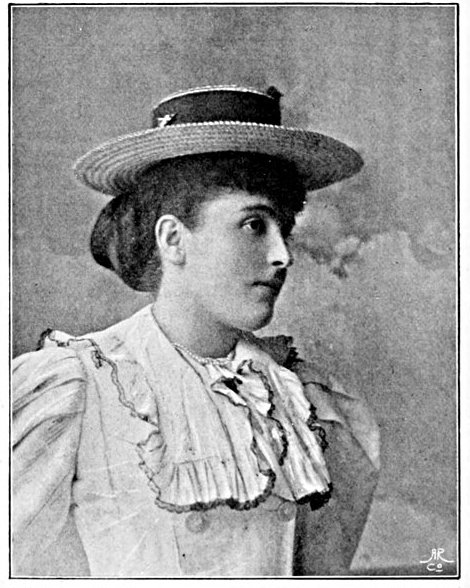
MISS BARBARA HUGHES.
Debenham and Smith. Southampton.

How can I with my poor pen do justice to all the delights of yachting as practised on the Solent? We need a nautical Whyte Melville to describe the joys of yacht-racing, and the real good sport which is its chief characteristic.
What an exciting game it is, how enthralling, how interesting, and more important still, how wholesome. What a benefit for city men to get right away to the sea, and enjoy such a complete change and relaxation as this racing affords. And how much they do appreciate it is shown by the number of little boats owned by stockbrokers and others who can only get down occasionally, but, nevertheless, keep their boats out the whole season through, so as not to lose the chance of a[Pg 2] sail when their opportunity comes. Not on the principle that race-horses are kept, either, as every one knows there is no chance of a racing boat doing more than pay her own way at best, for the prizes are barely adequate to meet the expenses.
Yacht-racing makes quite a new interest in life. The clever mathematician can find a large field for his energies in the designing line, and the keen sailor a never-wearying delight in developing to the utmost the powers of the boat confided to him.
How much better than the London drawing-room's close atmosphere is the fresh sea air, and the delightful freedom of bounding over the waves in a well-equipped craft, with the additional pinch of excitement afforded by racing. Let me assure you no fear of sea-sickness need deter any. Many of us would not be proof against a long Channel swell in a large steamer, but the motion of our little boats over the diminished waves inside the Wight, is not likely to upset any but the most pronounced bad sailor.
Besides, the excitement of racing drives away all qualms of that sort, sea-sickness being, I believe, in most cases the result of boredom and[Pg 3] nervous anticipation as much as anything else. No one could hate "yachting" as generally accepted more than I do. Anything so boring as a long sea voyage in a great lumbering schooner, I cannot imagine. The fact of "being taken," in nine cases out of ten, "where one would not," without having a hand in the matter, with a large crew of slow men to do all the work and take all the fun off one's hands, is to me nothing but an aggravation. The deliberate "cut and dried" way in which everything is done, the foresail being lowered and the peak eased when about two miles from the moorings, and such cautious measures, fidget me to death. There is this about racing, that one can never enjoy cruising in the same way after one has experienced its far superior joys. I must say, however, it is rather nice after the scrimmage of a long day's racing, to get on board a solid old cruiser and bundle peacefully home. But woe betide you if the wind is ahead, for you won't get home that night. No, you must be of a very leisurely disposition, and a great lover of Nature, for you to appreciate stereotyped cruising. This kind of thing is about as different from our Solent yachting, as the Derby is from a Margate donkey ride.
Of course I can understand the pleasure of cruising if the owner is also master of his vessel, but such a state of things is the exception, the owners mostly passing their time in standing about deck, or having large meals below, utterly oblivious of their course, their compass, or anything else. This must be a very stagnant amusement at the best, impossible to an energetic disposition, and only suited to an invalid, or man in his declining years. To people who lack any sporting instincts, racing, I suppose, seems ridiculous, but if they love the sea let them learn all about it, and navigate their own vessels like men, instead of being mere passengers on board their own craft, while their skipper is getting all the fun. Some women have taken their own line in this matter, and having mastered the science of navigation, are most enthusiastic on the subject, realising how it enhances a hundred-fold the pleasures of a sea voyage.
The news of a large schooner being on the stocks now-a-days comes as a surprise, as this type of vessel has almost entirely gone out of fashion in this country. That is to say, though there are still several to be seen about, the old ones being used because they are too good to throw away,[Pg 5] so to speak, no new ones have been built for years. The advantages of steam are so great for cruising and travel, that they outweigh the more pleasant sensation of sailing, which is the schooner's only claim to superiority. The difference in the expense is not very great after all, as you require double the crew in a sailing craft, and at least double the time to accomplish your distance. So if you want to get—say to Gibraltar—the chances are, that the extra time for which you are paying your crew, would easily cover your coal bill on the steamer. The auxiliary in nine cases out of ten proves a simple farce. Many, I know, have never once set their sails. It requires all the crew of an "out-and-out" sailing boat, and also the great unwieldly spars, which make it a bad sea boat when not under canvas. I would only recommend an auxiliary to a real wanderer, a born "man of the sea" like Lord Brassey, for whom of course there is nothing like it. The variety afforded in sailing and steaming on a lengthened sea trip, must be attractive and resting, and when both courses are open, you would not need to carry so much coal as in a steamer, or endure the wearisome hours becalmed in a heavy swell, which are such a drawback to sailing.
The discomfort people will endure in the name
of yachting, has always been a marvel to me.
The less they know about the life on board, the
more you will find they patiently put up with.
They seem to think because they are on a yacht,
cleanliness, cuisine, even elbow-room itself, should
be entirely abjured. The miseries that rational,
civilised human beings will suffer in this respect,
is a constant source of wonder, to those who
know how unnecessary they are. Not that these
sufferers do not like yachting, for they are even
persuaded to put their foot on board a yacht a
second time after such experiences. It is only
novices in the game, however, that you will find
suffering these deprivations, for, believe me, there
is no need for them. Do not overcrowd your
vessel, or cut her accommodation up into about
a dozen little cabins, into which you would not
put a dog on land. You really require double
the room for living afloat that you do ashore, as
even your exercise has to be taken on board.
There is nothing to prevent your having most
home comforts, a boiling hot sea-water bath every
morning, for example, and your meals served as
well as they are in your own house. Neither
need you have a bed only two feet wide, so that
[Pg 7]
[Pg 8]
[Pg 9]it is impossible to turn over without parting
with the bedclothes. It is no longer necessary
to go about on all fours, even in a 20-tonner, any
size below which I would not recommend for a
night's lodging.
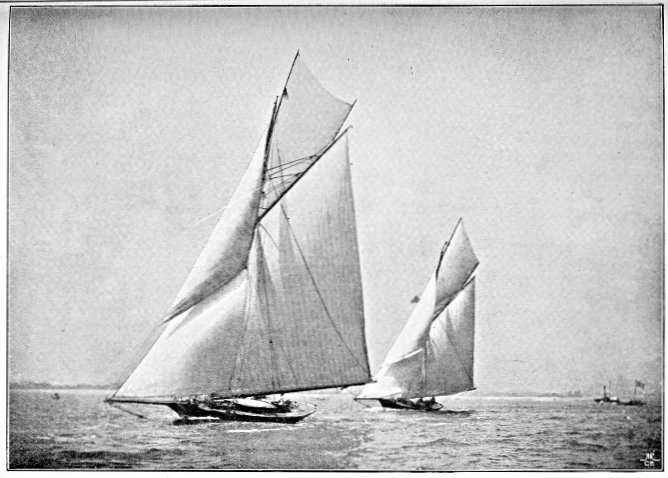
DAPHNE AND LIL.
West and Son. Southsea.
It is the custom of builders to furnish a small saloon with gigantic sideboards, or lockers, as they are called. These are ugly, clumsy, superfluous impediments, which are only made into receptacles for every sort of rubbish, and take up an immense amount of room. There is no need to have your store cupboard in the drawing-room, as by a little ingenuity ample room can be devised in the pantry, and in a safe on deck. Another plan is to have a passage down the side from forward right away aft, which obviates the perpetual disturbance of the stewards passing through your sitting-room. There is then only one door, which necessarily makes a much cosier room. Unless you are an assured good sailor, do not be beguiled into occupying the "after cabin," which is likewise called the "ladies' cabin." How it earned this appellation I am at a loss to explain, as I was always brought up to suppose ladies came first, and if they are relegated to the after cabin they very decidedly come off second-best.[Pg 10] There is twice the motion aft that there is in the middle of the vessel, and in a steamer you feel twice the vibration, beside being right over the screw.
How one gets spoilt! I remember sailing about as proud as Punch in an old Itchen ferry boat, with ragged sails and tarred topsides. The distances we used to cover, and the weather we went through in this old Zephyr are a wonder to look back upon. The whole day, from nine in the morning till nine at night, used to be spent on board, and the experience never palled, as far as I remember. Large lunches were always provided, in case of our getting becalmed, or stuck on the mud, both very frequent occurrences. We were always out to tea, and to boil the kettle in a choppy sea was the great excitement. There was only a kind of dog-hole place forward, where this important function took place. It was a severe test for the best "sailor" to balance a hot lamp, head over ears in methylated spirits, the hot fumes of which inundated the small cabin, while she patiently waited till the water boiled.
It was even worse at night, when a smelly paraffin lamp which would have made the atmosphere almost unbearable ashore, had to be endured,[Pg 11] and in a small and lively boat was certainly trying. When we were "caught out" on our way home from some long expedition, the unfortunate women of the party used to be thrust into this salubrious resort, ostensibly for their own comfort, really and truly, to get them out of the way. That was a place, when there were half a dozen women in there, a paraffin lamp, and the door shut! If one of us ventured so much as to open a chink of door, it was instantly shut again, with such exclamations from our male tyrants as—"Whatever you want to come out for, into all this wet and cold, when you can be warm and cosy in there, I can't think," upon which the brow-beaten female crawled back disconsolate into her lair, muttering rebelliously. And yet we were nothing daunted. Out we would be again with the dawn, to go through all the same thing without a dissenting thought.
We had not even the luxury of a paid hand in those days, my brother, and my sisters and myself doing all the work, which was a splendid education in more ways than one. I reluctantly confess I am spoilt for this sort of thing now, though I shall always look back upon the time with pleasure, and I very much doubt if it was[Pg 12] not one of the most enjoyable experiences in my life. It was all so new, so different from inland amusements, and I then learnt that a sea life has a charm all its own.
In 1888 we hired a 40-ton old-fashioned yawl called the Fox, with which we went in for the regular stereotyped cruising, as generally accepted. It was not a success, and I cannot say I enjoyed it. My back was always aching from stooping, and there was a permanent bruise on my head from constant impact with the beams. Besides, we were always being thwarted in our most urgent desires by the weather—as the skipper said—really by the incompetence of the vessel to cope with the elements. It was never worth while for instance starting with a head wind, as the time the yawl would take in accomplishing any distance, would have worn even Job's patience to a shadow.
Of course we share the sailor's love of fishing, and two large trawlers have been built at Brixham, by my brother and brother-in-law, for the special purpose. The Goddess was a huge great yawl, most comfortable below, and a grand sea boat. We did plenty of trawling in her, miles outside the Eddystone, and made some grand hauls. She had an enormous great trawl-beam,[Pg 13] and steam to get it with. Night was the best time for fishing, and we were not spared if we happened to be enjoying our beauty sleep, when the momentous four hours were up. The row of course would have awaked the dead, and so we scrimmaged into our clothes and rushed on deck ready to claw the great net on board. A waterproof overall and indiarubber boots were essential for this performance, and old gauntlet gloves were a precaution against stinging fish, advisable for the uninitiated. What a grand sight it was. Picture a bright moonlight night, when you were alone on the great rolling ocean, nothing in sight except perhaps the fitful gleam of the Eddystone in the far distance. The great vessel with shortened sail, dipping and curtseying to the proud billows which toyed with her bulky form, as though it was nothing more than a feather. Then amidst great shouting and racket, the huge trawl-beam was brought slowly alongside, and the heavy net was clawed on board full of treasures from "the hallowed precincts of the deep." What a flippering was there, from whiting, soles, red mullet, etc., etc. What wonderful curiosities do live in Davey Jones' locker. All kinds of leggy, finny, and jelly mollusca, none of them[Pg 14] very appetising in appearance, and most of them imbued with some formidable means of defence, such as a sting or a prickle. Once we got two enormous dog-fish, measuring five foot long, they were a great nuisance, as they cut the net all to pieces and were no good to man or beast.
One of the best hauls we ever made was in the Wayfarer, my brother's trawler, between Torquay and Dartmouth, when we had the whole deck full of fish, mostly whiting and soles, and the trouble was to get rid of them, even though we supplied every one in Dartmouth, and that in the time of the regatta.
Brixham and Bosham fishermen are much pleasanter to deal with than the self-styled "Yachtsmen," and they give much less trouble, do more work and require less wage. The custom of making a friend of the "Captain" is a huge mistake, as these individuals are usually the most wholesale extortioners that exist. The exorbitant wages they demand for filling a luxurious billet would stagger a longshoreman, and the petty pilferings, nominally perquisites, in which they indulge are what really make yachting so expensive. The familiar manner of some of these brass-bound autocrats is simply atrocious.[Pg 15] They seem to consider themselves complete masters of the situation, and treat the owner and his friends as so much superfluous cargo to be ordered about at their desire. This, without any exaggeration, is the state of things on numerous yachts I could name, more especially those with lady-owners.
To turn now to clothes, that all important point to members of my sex. I can only venture to suggest the merest hints, as really it is not a subject on which I am an authority, that is to say, if one is supposed to practise what one preaches. Brown in any form is to be avoided on the water, it is unspeakably ugly, and a number of people dressed in brown on a boat would destroy its appearance, be it never so smart. Nothing looks so well as white and red, or dark blue, but not black. Blue gauze veils are useful, but not ornamental, though a broad-brimmed sailor hat embraces both these virtues.
I have been twice to the Mediterranean, once in a sailing boat, the Goddess, and once in a steam yacht, the Normania. So I will close my cruising yarns with a description of what we experienced at the hands of a Greek pilot. We were between the Piræus and Corfu one evening when it came[Pg 16] on suddenly very dark and dirty. Being a very determined party of women on board, we made a stand for taking shelter behind one of the islands. We all "held a board" on the chart, but could see no harbour of refuge equal to sheltering our sumptuous craft. The little Greek pilot however proved equal to the occasion. Pointing out a small indentation in the coast, he urged us to confide in him, and he would guarantee us a peaceful night. Accordingly we slowed down the engines, and made for a faint red light. The chart, by the bye, said this light should be green, but that was neither here nor there. There was a rocky promontory sticking out with a lighthouse on the end, where was the aforesaid red light that should have been green. This our valiant pilot steered straight for. It was blowing a sirocco, with thick rain and a heavy sea, nevertheless we all stood on the bridge to watch the hazardous venture. On we went, straight for the rocks where the rollers were breaking. It was becoming decidedly interesting, and as the chart evidently did not consider the place worth its serious attention, we could no longer look to that for guidance. Very soon the darkness and hurly-burly of the storm lifted for a second, and[Pg 17] displayed a most disorganizing prospect. We were almost on the beach on the starboard side, and could have thrown a biscuit into the lighthouse window on the port, and there was land right ahead. We were in a little pocket, a neck of rocks which ran parallel to the coast, taking the fury of the waves, and affording a good shelter. But a tighter place for a five hundred ton vessel could not be imagined. When we looked out of our ports in the morning, we were still more astonished, for without exaggeration we could have held easy converse with the people ashore all round the vessel, while our bow positively overshadowed the small quay. It was a place into which one would have hesitated to take a 50-tonner with twin screws in broad daylight, and for a 500-tonner to get in safely in a howling hurricane, and when it was pitch dark, was indeed a feat of ingenuity.
Of course it entailed backing out, but as the yacht fortunately was a very handy vessel, this was safely accomplished. Such little incidents, which lend a piquancy to cruising dispel the monotony, and while they keep up the interest in the manipulation of your vessel, also serve to entertain your friends on getting home.
Yacht-racing is in every respect a sport suited to our sex. No unseemly gymnastics, no over-straining or over-tiring, no cruelty can be laid to its charge, in fact nothing to offend the most exacting upholder of the feminine. Yet Yacht-racing is open to abuse, though even here in a lesser degree, perhaps, than other amusements. Where it stands alone, is that in it a woman can compete on equal terms with man.
Yacht-racing needs much study, and should not be attempted till the ordinary art of sailing is thoroughly understood. It is the most delightful education in the world, the most interesting and healthful. It becomes so engrossing you will not rest till you understand the whole thing, and know the why and wherefore of all the different moves. It is not advisable to order a boat of your own till you have served an apprenticeship as "hand." Very few people are now contented to go as "hand" or "crew," every one preferring to "paddle his own canoe." Nevertheless it is delightful to go in a well managed boat where you have full confidence in the skipper, and a beginner should certainly not be above it. She will then see how much there is in "handling," and realize how many races are won solely by clever man[Pg 19]agement and attention to small details. At any rate do not attempt to have a boat of your own for the first time until you have secured an experienced racing skipper. When you have done this be guided by him entirely to start with, only you will do well to be still more particular than he is in adhering to the Yacht Racing Association Rules, which of course you should know by heart. If you are racing do what the skipper tells you instantly, and do not wait to ask the reason first, do that afterwards.
The great secret of racing is to keep your wits about you, do everything "smartly," never hesitate or waver between two opinions at a critical moment, for that will merely lose you the race. The need of prompt decision is one of the most exciting features of racing, now it has been brought to such perfection. One faux pas and you are done if the wind stops true, but on the other hand it seldom answers to give up, as you need never despair of the wind veering round and coming to the rescue, even if you have made a blunder. To be really good in a boat you should have done some single-handed work, but this is not to be recommended until you are well grounded in the rudiments of sailing, or you will[Pg 20] very shortly be "well grounded" on something harder still.
The single-handed matches in one-raters which were witnessed in 1895 and 1896 were excellent trials of skill, as was shown by the results. It is impossible to exaggerate the difficulty of sailing those boats single-handed in rough weather, for it is a task worthy of a Sandow and a Carter rolled into one, and the greatest kudos is therefore due to those sportsmen who brought their boats safely across the winning line. There were some "lame ducks" too, through no fault of their own, and many I regret to say made but a poor show of their prowess. There is plenty of variety, however, in racing without going to any extremes, or attempting impossibilities like those single-handed matches. A half-rater would be quite as much as one man could manage properly in rough weather.
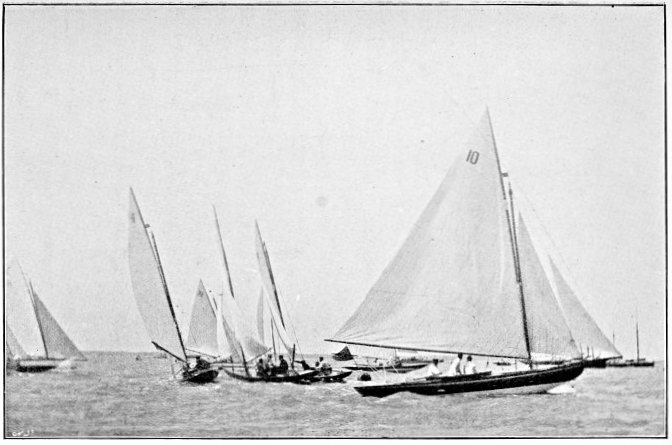
Becken. Cowes.
ONE-RATERS AT COWES.
Every year affords fresh interests, as the type
of boat alters, for there is skill required to get
them into trim and learn their ways. Each individual
boat, too, wants different handling, and it
will often be a surprise to an adept in one boat, to
find himself quite adrift in another. Steering has
been steadily becoming more difficult hitherto,
[Pg 21]
[Pg 22]
[Pg 23]but now I fancy there will be a return to the
fixed rudders we began with, which are much
easier to handle than the balanced ones of later
years. The business will not then be as fidgety,
or require such close attention, as with balanced
rudders your boat which may be ever so light on
her helm, will be constantly veering about and
getting off her course, if you do not keep an
undeviating watch on your steering. Of course
it all makes it more interesting, because more
difficult, but in a way it is not an advantage for
the helmsman to be entirely engrossed with his
steering, unless he can conscientiously rely on his
"crew" to do the rest.
To enjoy racing to the full you should have it all in your own hands with no one to say you "nay," otherwise that spirit of independence—so rarely enjoyed by our sex—is lost. The sensation of being master of your own vessel, with the helm in your hand and a willing crew to do your commands, unquestionably, these are elements which should be experienced to be enjoyed. As a man is dependent on his eye for shooting, his hands for driving, his pocket for betting, so does he depend on his wits for sailing. To be a good skipper you must above all things have a clear[Pg 24] head and plenty in it, for there is much to learn and to keep up. Yacht racing has now attained to a pitch of perfection verging on science, and to succeed in it you must have observation, self-control, perseverance, good ready judgment and self-reliance, besides many other qualities too numerous to mention, such as patience and cheerfulness. There is nothing to compare to yacht-racing in my opinion for a woman's sport, calling into play as it does all these qualities, besides giving the wholesome enjoyment of an ocean life.
I began my racing career practically in 1886,
though I had had some experience with a little
boat called Fairy, which my father had bought
from Picket of Southampton. This boat had
been built for letting out to pleasure-parties, and
was nearly as broad as she was long. Some years
before this he—my father—had built the 60-tonner
Vanguard, and as he was a great connoisseur
on boats he made a good hit in buying the little
pleasure-boat, Fairy. She and the Bird o' Freedom
were the pioneers of that now famous body
the Solent classes. With some slight alterations
to the keel, and with the addition of a large jib
to the sail plan, little Fairy proved herself capable
[Pg 25]
[Pg 26]
[Pg 27]of beating the Bird o' Freedom, which was then
the greatest flyer of the day. This caused some
surprise to the faculty—who were few in those
days—and some of them decided to try and beat
her the following season. Consequently 1886
saw the Minima and Tootsie added to the list, and
some jealous competitions ensued.
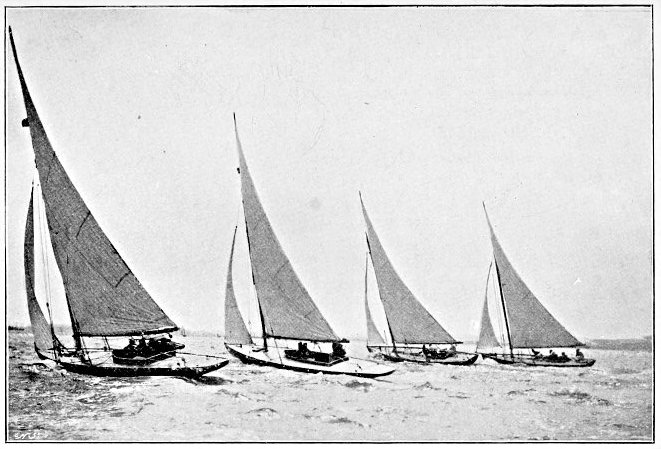
West and Son. Southsea.
READY FOR THE START.
(MYNAH, HOOPOO, STORK, AND MOLLY.)
The Royal Southampton and Portsmouth Corinthian Yacht Clubs came to the rescue and gave fortnightly matches for the small craft, as well as for the 25 and 30 footers. Then the fun grew fast and furious, for the small boat racing having been given the necessary fillip, the designers put their best foot foremost and the sport was fairly started. A motley crew it was that assembled off the Town Quay every Saturday fortnight. Most of the boats were of the nice little cruiser type, slow as a country dinner party, nevertheless so enshrouded in canvas as to present a most sporting appearance. Any deficiency in design was balanced by unlimited additions in canvas, no expense being spared in sailcloth to make up the necessary speed. And how zealous was the competition! Life and death might have hung on the issue, judging by the ardour and agility displayed in the management of the boats.
"Every dog has his day," and this was the heyday of the Dauntless Amateur. An eager, perspiring, undefeated creature was he! Minus hat and socks, having shed all superfluities in clothing, he gallantly plied his task before the mast. Any effort to persuade him further aft, or into the "well," were unavailing. He loved to stand boldly up forward, the wind running riot through his hair, the poor boat shoving along all out of trim, owing to his misplaced weight, while he gallantly stood at attention, eager to signify that he was "ready for anything." However we shall see our hatless, sockless friend no more, his place being now filled by the peerless Itchen ferryman at thirty shillings a week.
The richest man now has the best boat, and if he does not get it the first time he goes on building till he succeeds. The same with the crew, the man with well-lined pockets gets all the best men by paying the best wages. But still even the designers are not wholly responsible for what their craft will turn out, as was proved by Sibbick building the unsuccessful White Rose for the Duke of York. Other cases I could also mention where money was no object, and boat after boat untiringly turned out for the same owner, yet without[Pg 29] success. Then some lucky man may get a boat from the same designer which will clear the board for two or three seasons, her capacities having been all unknown to the designer himself.
How we managed in those days of unlimited canvas with only two hands remains a mystery. What with the enormous topsail and all the extra gear it entailed, the long spinnaker, boom, etc., and the largest mainsail that could be crammed on, the wonder is that we ever gybed round a mark at all, without capsizing the whole lot overboard. The gear of course was very much stouter and the boats slower on their helms than they are now, or it could not have been done. We have the same crew on a one-rater now that we used to have on the 25-footer Lil, which is most astonishing to think of when we compare the two boats. True they are practically the same length, but with what a difference in build. The Lil was a regular ship with her enormous spars and canvas, and her well timbered heavy hull and large cabin, whereas these little one-raters are mere cockle shells without half the amount of gear, nor are they nearly so hard on it. Nevertheless, anyone will tell you it is impossible now-a-days to manage a one-rater properly with less[Pg 30] than two hands, and that with only two sails instead of four.
The first race I think ever sailed by women was between us—my sisters and myself—in the Fairy, and the Miss Coxes in their sister ship Colinette, I believe the Miss Hammersleys also formed part of the rival crew. I have but a vague recollection of the whole thing, being too young at the time really to grasp the situation in its full value, or for it to make any great impression on my mind, as I was always being taken racing in some boat or other. In 1885, we were again rivals in Verena and Lil, one of the Miss Coxes always going in the former, and one of us in the Lil. These were great wholesome boats with enormous sails, and we managed to do a lot of cruising between the races, which in those days only took place once a week. The Lil had quite a nice deep cabin which was the pride of our lives, pictures being hung in every available space, and little curtains and cushions to match. Little Fairy meanwhile was "not quite dead yet," and in 1888 "came up smiling" to fight the battle and the breeze in a resuscitated form. That year she proved herself no mean opponent, and succeeded in making the same figure of merit[Pg 31] as Thalassa, the champion of the previous year. This success was due to a fin keel, an experiment of my father's which has since been through almost every imaginable variation, and still holds sway in a modified form among the smaller classes.
In 1887, Miss Cox built the Madcap at Payne's, and divided the honour with Thalassa, also a two-and-a-half-rater by Payne. The latter belonged to Colonel Bucknill, whose daughters are now so well known on the Solent. Miss Bucknill is indeed much sought after as a helmswoman, and with good cause, as she has learnt the work thoroughly and is as proficient at the helm as she is on the jib sheet. Her father has raced steadily every season since 1886, and she has almost always accompanied him and shared in the work most gallantly. I cannot be quite sure if we sailed Fairy or Lil that year, 1887, but I think both went to the line, my brother also designed a five-rater with but little success, being young he had to buy his experience of course, and learnt the advisability of going to Arthur Payne in future.
The year 1889 was a memorable one for us, as we were fortunate enough to possess the[Pg 32] champion two-and-a-half-rater by Payne. Hummingbird was a charming boat in every respect, comparatively roomy, a good sea boat, and a wonderful performer to windward. She gained twenty-five firsts and four seconds, out of thirty-eight starts, and succeeded in routing three creations of the famous G. L. Watson. It was one of these, the Thief, which my sister, Mrs. Schenley, had the misfortune to possess. A most uncomfortable little craft it was. Only about five foot beam, with decks like sieves, and we were all crammed into little holes or cockpit places with only our head and shoulders out, for all the world like chickens coming out of an egg. That was really my introduction to racing. I had to work hard, as it was not the boat to take people in who did nothing. We were fortunate in securing Charlie Devis, who is now considered almost if not quite the best skipper on the Solent. He was then little more than a boy, so we were all young and enthusiastic together, and despite the many drawbacks I think we all enjoyed that season thoroughly. At any rate we were nothing daunted, and only waited till the next year to renew our efforts in a five-rater of the same type.
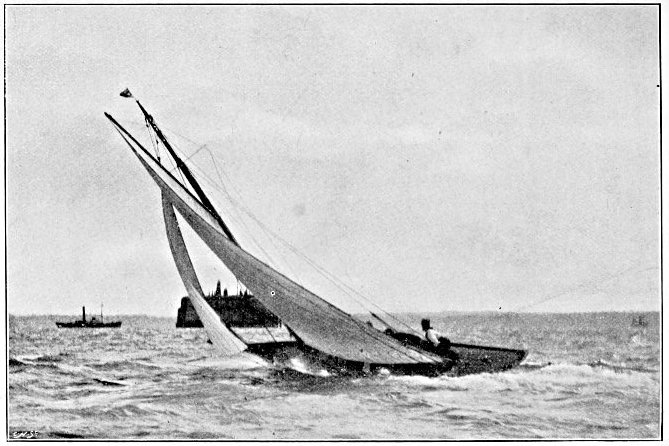
West and Son. Southsea.
THIEF.
This was also Lord Dunraven's début on the Solent, and he was not much better off than we were, having a sister ship to ours, by name Cosette. Therefore, with the Queen Mab, G.G., Lady Nan (Mrs. Rudstan Reid), Thalassa and Madcap (Miss Cox), we had to be content to compete for second honours, the Hummer always carrying off the first.
I might here put in a word in season, on the evils resulting from keeping rival boats in the family. The battles are bound to be re-fought over the domestic board again in the evening, and of the two the wordy war is by far the most bitter and lasting. The envy and jealousy of the defeated cannot fail to show itself, and even the conqueror owes the other a grudge, for having so much as dared to get in his way at the start! We learnt the lesson in 1887, and have kept studiously clear of each other's hunting grounds ever since, even counselling our friends not to put our fidelity to so severe a test as to join the same class. It was this year that Mr. Philip Perceval made his début with the Lollypop, a boat he bought from Mr. St. Julien Arabin. Since that time Mr. Perceval has been an enthusiastic member of yacht-racing circles, and is now almost[Pg 36] as well known on the Solent as Calshot Castle. Most lucky in his boats, whatever he touches must turn to gold, and besides this phenomenal luck, he has unrivalled skill at the helm and in the general manipulation of the craft. So his racing record must be indeed a remarkable one. Perhaps some day he will be persuaded to publish it, in all its branches.
At the end of this season, a ladies' match was sailed in the sister ships Cosette and Queen Mab. Miss Bucknill was at the helm of the former, and Miss Harvey had the Queen Mab. It is much to be regretted that Miss Harvey did not persevere in her racing career, as she showed much ability and came of a nautical family. Her father, Mr. E. Harvey, was well known as one of the original members of the squadron. The race was very interesting and well managed, but far be it from me to say which proved herself the better steerer. Lord Dunraven and Mr. Perceval who now had the racing fever, had both built five-raters at Payne's and divided the honours in that class. Mrs. Schenley determined to make another experiment with Mr. Watson's design in the five-raters. The Valentine, however, was a worse failure than the Thief had been, Glycera[Pg 37] and Alwida being always first and second. The stern chase became rather wearisome, and we did not keep at it so steadily as we should have, only starting twenty-six times to the others forty. We managed to pick up five first and four second prizes, chiefly in light weather. The Babe, Mr. Payne's design, was champion of the two-and-a-half-raters, and poor old Hummer, which had served us in such good stead the year before, was clearly worsted. She was beginning the season in her old style, when the dreaded advent of the Babe put an end to her prosperous career, and she had a hard struggle till the end of the season to keep up her old traditions. I sailed many times on Hummer and Cock-a-whoop, my brother's two-and-a-half-rater, and on the former I said less, but thought the more, as my father's seamanship was undisputed, and his tactics a wonder to behold. That year the inventive genius of Mr. Clayton, champion designer of the old length classers, produced the Dolphin, also a two-and-a-half-rater. She was looked at with decided disapproval and some disgust by the rival faculty, as her over-hang was considered a crafty mode of cheating the rule. So it was, and continues to be to this day in a still larger degree, but after[Pg 38] all it is the designer's object to get as much as he can out of the rule, without paying for it in time allowance. Miss Cox and her sister, now Mrs. Rudston Reid, both built two-and-a-half-raters, which they sailed most conscientiously but without much success. Miss Cox's Mliss did the better of the two, the Troublesome not being a morsel of use except in light air. However, it was a very strong class, and of course every one could not expect to win. Mrs. Schenley was at last persuaded, in 1891, to give Payne an order, and he proved himself fully equal to the trust confided in him, by producing that most delightful of boats the Windfall. Seaworthiness, dryness, roominess, and lightness of helm were some of her qualifications, besides her exceptional speed. War to the knife ensued between us and Mr. Perceval, who had likewise got a new five-rater from Payne. We came out of the fray each with thirty-four flags, Windfall's string however being the better by six firsts, indicated her superiority by six conquests out of the forty deadly conflicts. These struggles have never been renewed, the ordeal having been too great for both sides.
The small pickings left over and above, namely[Pg 39] nine first prizes and twelve second, were shared by Alwida and Iernia respectively. The latter boat, one of Fife's failures, was owned by that genial Irishman, Mr. Langrishe, who had previously sold the famous Samæna to join the ranks of the owners of the smaller classes, to which he has remained faithful ever since. He placed his confidence from the first in young Mr. Charles Nicholson, who ultimately proved more than equal to the trust reposed in him, and he designed the Dacia in 1892. Miss Cox was again at a discount with a most unattractive two-and-a-half-rater, she called Fiera. This was one of the hard-mouthed type, and wanted a fresh wind and a strong man at the helm. She gave a good account of herself however on such occasions, and ran up a better record than Mliss. Miss Harvey was the possessor of a very pretty two-and-a-half-rater called Undine, built from a design by Mr. Clayton. This last was still more of an advance towards the type of the present day, and no doubt would have made a good performance then if she had been raced. She only showed up once or twice, however, and so of course never had a chance of getting into trim or anything else. Possibly Miss Harvey was put[Pg 40] off by a collision she had with the Windfall during the Cowes week. It was very unfortunate, but not her fault as I can testify. Nevertheless it was none the better for that, and I remember pointing out the best place on the Windfall for her to ram with the least danger. Undine's bowsprit accordingly went clean through Windfall, just forward of the mast, and then the two boats got locked together and the spars began falling about our ears. There was a strong wind and a still stronger tide, and we were rapidly driven under the bows of a large steamer Gladwyn. The Undine had the inside berth between Windfall and Gladwyn, and as Windfall got across the tide she fairly ground poor little Undine's frail hull till the timbers groaned again. Meanwhile the gallant crew of the Gladwyn insisted on dragging us ladies up over the bows, and this was the most alarming part of all, as it was such a height. The owner of the Gladwyn, who was in the Squadron at the time, was much surprised a little later to see a strange lot of rather dilapidated females, being rowed ashore in his gig.
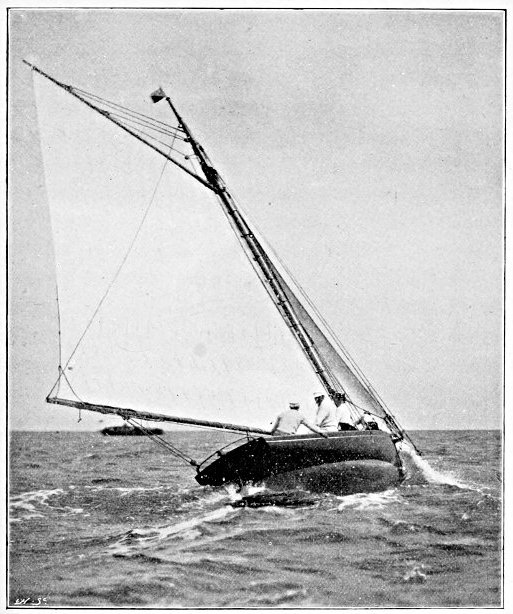
West and Son. Southsea.
NADADOR.
I must not forget to mention that lively little
club at Bembridge, situated on a remote corner
of the Wight, near to which is the double
[Pg 41]
[Pg 42]
[Pg 43]attraction of a superior golf-links. The Bembridge
Sailing Club, or "B and S" Club, as it is
irreverently called, was started in 1889 by
Colonel Moreton and Major du Boulay. Some
of the rules were nothing if not eccentric, and I
am told the favourite hour for match sailing was
about midnight. The women were duly considered
in this club, and most ably did they
acquit themselves in the one design class.
Miss Sutton was tempted out to the more easterly regattas, when she had a half-rater called Wee-Winn, of which more later on. Miss Moreton, Miss Hallows, and Mrs. Dudley Ward and her daughters, were among the other Bembridge sailoresses, though of course many more came down in August to this cheerful little resort.
The next year, 1892, both our family boats were beaten by a new talent, young Mr. C. Nicholson. It was a great thing bringing a new brain to bear on the matter, as for the previous five years Arthur Payne had held the whole sway, and prior to that Mr. Clayton. These boats went quite fast enough to make a good race of it amongst themselves, and though they assuredly were hard to beat yet they were beaten[Pg 44] by the Dacia in the five-rater, and the Gareth in the two-and-a-half-rater class. The latter was the property of Mr. Henderson, who was indeed fortunate, as he was a complete novice, to own the champion of three seasons. Lord Dudley bought Dacia from Mr. Langrishe in the middle of the season for a fabulous price, nevertheless the latter was generally to be seen at the helm. Lord Dunraven's Cyane, from Mr. Payne's design, was at the old game of shovelling the first prizes into her locker, until Dacia came out and put a stop to it. The pace of this flyer soon spread dismay in the class, which was not very well filled even at first, and soon no one could be got to start against her, until she went down to Torbay to show a boastful Scotch antagonist the way round the course. The rivalry between North and South is always exceedingly bitter, but latterly the Scotchmen have not thought it infra dig. to come to the South for their best designs in the small classes. It would be more patriotic, to say the least of it, if the best Clyde amateurs were to challenge us in their home manufactures, otherwise their triumphs are but reflected glories after all.
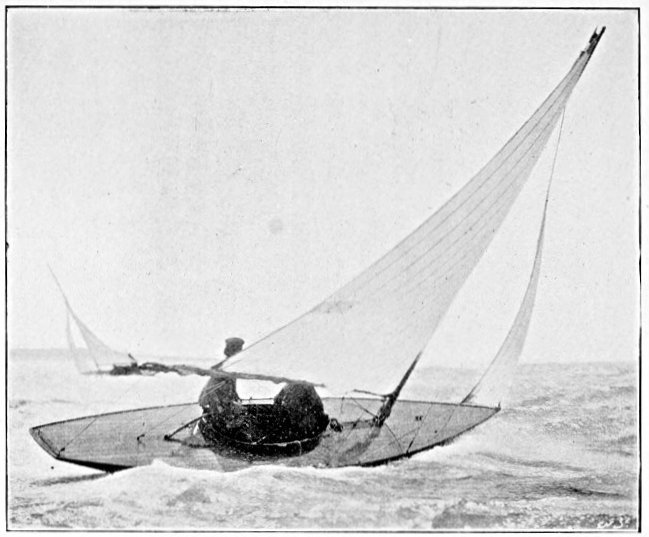
West and Son. Southsea.
MORWENA, STEERED BY MISS SUTTON.
A little stranger from over the water appeared this year (1892), to the order of Miss Winnie Sutton. Wee Winn, however, did not belie her somewhat ambitious appellation, as is often the case. On the contrary, she amply fulfilled it, and the tiny Yankee did her country great credit, and that in what we flattered ourselves to be a very formidable class. She had nine competitors from four different designers, and yet fairly walked round the lot. Her performances were the signal for further Yankee inroads, and 1893 saw two American boats, namely Meneen and Morwena, added to the list. So now there was an American in all three classes from two-and-a-half downwards, and to our shame be it said each one headed her class. It was not till the year 1897 either, that Meneen may fairly be said to have been outclassed, her construction also was a masterpiece of lightness and durability. Her record was forty prizes in forty-nine starts, and this with seven rivals, one of Mr. Nicholson's design and one of Mr. Payne's included. Mrs. Hardie Jackson constantly accompanied her husband in Meneen, and was as at home on the water as she is known to be in the saddle. This was not a propitious year for South coast designers, as Fife held the laurels in the five and likewise in the twenty[Pg 48] class. The twenties were a new institution promoted by Lord Dunraven, and they flourished for four years as Solent classes, but last season (1897) no new ones came to the line except towards the end of July.
In 1893 the race programmes were almost too well stocked, the scrimmage on the line to get the start being a sight to behold, especially in the one-rater class. There were considerably over a dozen of these, and almost as many half raters, all determined to get the start of the others over the line, and that sometimes a very narrow one as in the Hamble river. The Morwena, champion of her class, was owned by one of the sisters of Miss Winnie Sutton, and though her success did not cause such a stir as Wee Winn's, she made almost as good a record. Miss Cox's luck again failed her in Kismet, a two-and-a-half rater built by Payne. I believe she also was a very hard boat to steer, in fact worse than Fiera. My brother sailed the majority of races that year in Gareth, whose performance was a good one but not so good as the Meneen's. Gareth started five times more than Meneen and won two more prizes, but Meneen's figure of merit came out the highest. These two consequently pretty well monopolised[Pg 49] the prizes, but a few being left for the other six, of which Kismet picked up two firsts and six seconds.
Mr. Jessop was the owner of the Molly, twenty
rater, and Coquette, half rater. He consequently
often required a helmswoman for the latter, which
office he kindly offered me. Little Coquette was
an extremely fast boat of Mr. Nicholson's design,
and made one of the longest string of flags ever
recorded. Wee Winn, fortunately for us, only
started eleven times that season. In the same
year (1893) the majority of boats and the largest
prize winners were of a good wholesome type,
but the three following seasons they went steadily
down hill in this respect. Elf was considered an
unsightly monster then, but there have been many
like her since, not a whit uglier or less exaggerated,
which have proved themselves also the fastest
movers. Flat Fish was a case in point. She was
most aptly named; indeed, I think the Flounder
would have been a still more appropriate designation.
She was put together with most wonderful
despatch by Fay and Co., from Mr. Soper's
design, for my sister, Mrs. Schenley. The first
two races she came to pieces, owing to the hurry
over her construction, and had to go back for[Pg 50]
repairs. To hear the flump of her bow on to the
water, it was marvellous that anything could hold
out; she was just the shape of a spoon forward,
and when driven against a head sea she naturally
made the splinters fly. Her nose was quite four
inches higher in the air by the end of the season,
in fact she presented the most cheeky appearance.
A most powerful boat in a breeze, in all senses
of the word except perhaps the individual frame,
she also required a Goliath to steer her. My
sister's and my united forces were unequal to the
task, and it used to amuse us to watch for the
signal of distress held out towards the end of a
race by the boastful amateurs, whom we requisitioned
to steer on hard windy days. They were
never keen to repeat the experiment, and if they
did, they were glad enough for us to take turns.
Our chief antagonist was Fleur-de-Lys, built by
Fife and owned by Major Montgomery, one of
the few lucky yachtsmen who have not followed
up their successes, although a dweller on the scene
of action. Lady Sophia Montgomery occasionally
accompanied her husband, and took a keen
interest in the fray and kept a jealous eye on the
records of the rival craft. Theirs was undoubtedly
the better "all round" boat, as Flat Fish was
[Pg 51]
[Pg 52]
[Pg 53]no more good than a barge in light weather, although
she was conscientiously sailed in all the
races for which she was entered. In 1894 two
new aspirants for yachting fame joined the ranks,
namely, the Hon. Mrs. Oliphant and Miss Lord.
I can hardly say which has proved herself the
keenest sailor. Mrs. Oliphant was most fortunate
in securing an excellent two-and-a-half rater
from Sibbick, called Zivolo, which made a very
good record, taking twenty-nine flags in thirty-six
starts. Although the boat was her own property,
she very wisely got others to steer at first,
though she always accompanied the ship. Now
she no longer needs assistance, and though not
possessing a boat of her own this year, she has had
several mounts on other peoples. The Rosemary,
a formidable customer to steer was in her hands
the latter part of this season, and though a slow
boat Mrs. Oliphant often led the fleet in her, and
won two or three prizes. Miss Lord has had a
succession of one-raters since her début in 1895.
She favoured Soper's design at first, but latterly
has adopted Sibbick's. All her boats have been
large prize winners.
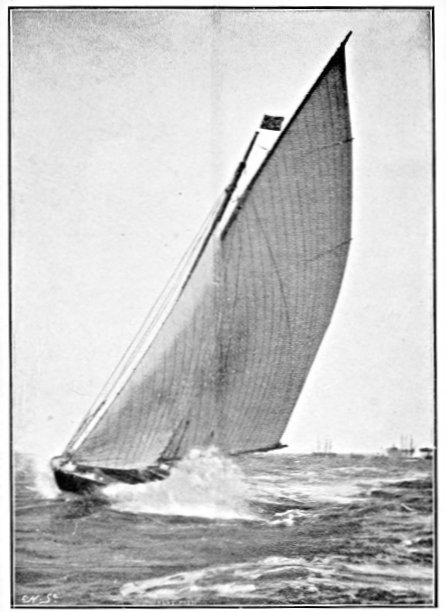
West and Son. Southsea.
FLAT FISH.
In 1895, yacht-racing was distinctly the fashionable sport. Lord Dunraven was no doubt in a[Pg 54] great measure responsible for this, he having persuaded several friends to join the twenty-rater class. Lord Lonsdale owned one of these, Lord Dudley another, Prince Batthyany Stratmann, a pretty boat painted blue, and the unfortunate Baron von Zedtwitz, who was subsequently drowned off his twenty-rater, the Isolde.
Even Royalty patronized the Solent classes. The Duke of York had a one-rater built at Sibbick's in less than a week, in which he took a great interest though he did not venture himself to join in the sport. The White Rose was, however, in good hands, being most ably sailed by his equerry, the Hon. Derek Keppel. She was not a success, however, and when Mr. Keppel, who was called away at the end of August, confided her to me, I made but a poor show with her, gaining only one first in tour starts. Miss Cox was well to the fore in the same class, also having got her craft from Sibbick. She made a string of twenty-five flags, eleven of which were firsts. My brother had bought an unsuccessful one-rater, he re-named Fusee, the year before. He and I sailed this little boat in several races, I steering and he doing the work. It was fun, and the boat was well suited to this game as she was only[Pg 55] good for light water, directly it blew up at all she was passed in spite of all we could do. So when my brother went abroad at the end of June I got a boy to help, and sailed in the light wind races throughout the season. I thoroughly enjoyed myself and got ten prizes out of twenty starts, though poor little Fusee was invariably beaten on a reach except in the lightest air, and had to make up all her time on the "beats." That August was a busy month, for on looking back I find I raced every day, Sunday not excepted, as we used to have duels in Fusee and White Rose with amateur crews. The class to which these belonged (one-raters) was then and has remained the most popular of all classes on the Solent. Once at Yarmouth, fourteen of us started together over the line. It was grand fun and I was very proud of leading at the end of the first round in little Fusee, but unfortunately the wind dropped completely in the second round, and only a few of us managed to complete the course at all. I think Mr. Paget's Soper got in first, and Miss Cox's Mavis second.
1896 was also a great one-rater year, and Miss Cox had the honour of leading the whole fleet in almost every race she sailed. She had returned[Pg 56] to her old ally, Arthur Payne, who designed her the Speedwell. No praise is too high for this little champion, for she still holds pride of place and has proved herself as seaworthy as she is fast. I never steered such a wonderful boat, to windward she positively edged along in the teeth of the wind and made all the others look foolish, as she outpointed them to such a ridiculous extent. I often sailed the old Meneen that year, and she also was dependent on her windward powers for her success, as being much shorter than the others she could not be expected to reach with them. This was well shown at some races at Seaview in August, when we headed the Florence (Sibbick's crack owned by the Marquise de Serramezzana) every time to windward, whereas she would pass us again on the reach. The Florence got two firsts and one second, and we secured two seconds and one first out of the three races. Mrs. Schenley had bought the Corolla, a success of the previous season. We did very well with her until about the end of July, when Tatters became too much for us, some slight alteration having given her the advantage over us. Florence then came out, and we left those two to fight it out to the bitter end. These[Pg 57] boats, both of which were of Sibbick's design, were extremely fast, though they were not remarkably close-winded. Lord Albemarle built Valeria I. at Payne's, and I sailed in her many times but failed to score, there were certainly numerous and formidable rivals and Valeria came rather late to the fray. It must be an unlucky name I think, as Valeria II. has not proved any better, though she is a beautiful boat and great things were expected of her, being Payne's design. Tatters, with Miss Lord at the helm,[Pg 58] won first prize in the Ladies' race (promoted by the Gentlewoman) on August 4th, Mrs. Oliphant who had a good mount in the Florence was second, Miss Bucknill being third in Meneen, I fourth in Valeria, my sister last in Mem Sahib. There was a fresh wind, and as the harbour was full of yachts, and the course was all amongst them, considerable skill was required in the handling. There were happily no casualties. Another ladies' race in one-raters, with a diminished crew of one amateur, was got up one evening at Cowes by Lord Harrington. There was a fine scrimmage getting on board, most of the women or their boats being late, the starting-gun—a 12-bore—was fired off in one of the bathing machines, regardless of the entreaties of the competitors for time. I was dragged on board the wrong boat at the last minute, my "mount" being late, and off we went after Speedwell, but she was already a speck in the distance, and we found we should never catch her again. My sister and I had a deadly encounter in Tartar and Bodagh, and after jostling each other round and round and tacking and filling in a remarkable manner only known to ourselves, I came out the best of it and she gained third honours.
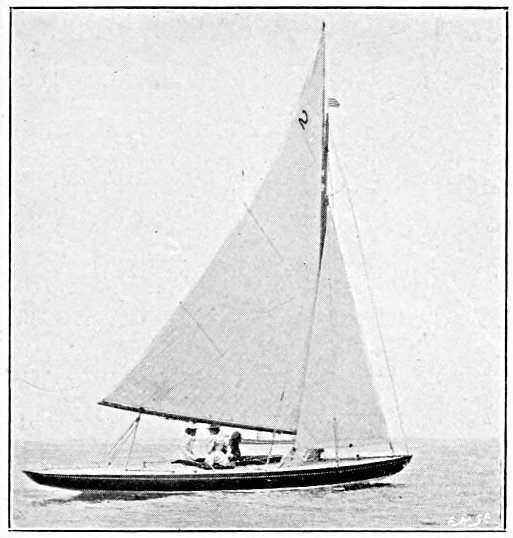
Becken. Cowes.
COROLLA, STEERED BY MISS HUGHES.
In 1897, Mrs. Schenley joined the one-design class—with Cresta—- started the year before by Major Colville and Colonel Bucknill. These boats proved very popular and much good racing has resulted. They are ugly but wholesome, not very fast but answer their purpose well. We did not race very assiduously that season as we were often otherwise engaged. Cresta won us about fourteen prizes, in thirty starts I think. Many women sailed in this class, Mrs. Parry and Mrs. Tower constantly accompanying their husbands, also Mrs. Towers Clark and Mrs. Alwyne Greville were occasionally to be seen on the C'lerk and Eileen. These latter, however, never ventured to take the helm, though they were much attached to the sport and nothing daunted by weather. The boats owned by women this year were the Fairy, Miss Lord, Cresta, Mrs. Schenley, and Speedwell, Miss Cox, while Mrs. Oliphant was Queen Regent on the Rosemary. My sister, Miss Hughes, constantly sailed the Meneen and Speedwell, but she will never make such a record as she did with the Viva, half-rater, lent her by Mr. Wood, which was one of the largest prize-winners and most successful of her class ever floated.
Half-raters are too small for my taste, and I think a two-and-a-half, as the boats are built now, is the best size for a woman. Possibly the day may come back when the five-raters will be as easy on their helms as they were in 1891. My sister tells me she steered Forella, five-rater, in quite a fresh wind this season and had no difficulty in managing her, so perhaps I am not too sanguine in anticipating more sport for us in this class.
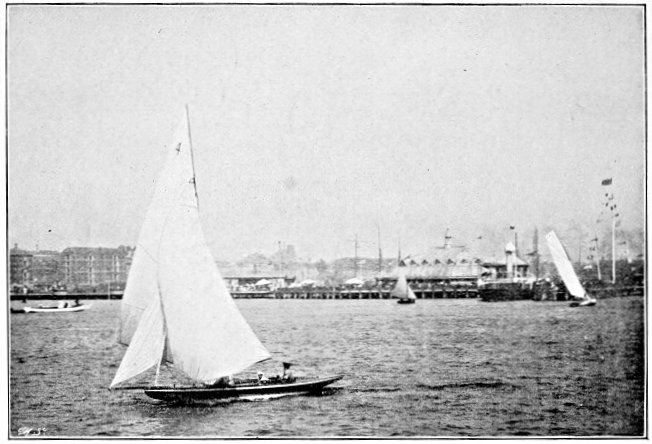
F. G. Stuart. Southampton.
FAIRY, STEERED BY MISS LORD.
My ideal mode of yachting would be to have
a new two-and-a-half-rater whenever the old one
was worsted, with a five-rater perhaps now and
then to vary the monotony. A fifty-ton steamer,
or one perhaps a little smaller, to act as convoy
is essential, and it should be fast and have a good
saloon, and a couple of rooms to change in if
needed. Cowes is the most convenient pied-à-terre
from a racing point of view, being very
central with regard to the more frequent regattas.
Racing is not a cheap amusement, but then,
nothing nice ever is. To put it roughly, the
two-and-a-half-rater would cost £300 to build,
and £100 to "run." The steamer £2,500 to
build, and £300 to "run," and the little house at
Cowes, one or two hundred for the season. Of
lesser items connected with racing there are
[Pg 61]
[Pg 62]
[Pg 63]several, the numerous club subscriptions for one
thing being no small matter. The expenses of
yacht-racing have been steadily on the increase,
and I hope now they have attained their maximum.
We have had sixteen racing boats in
the family during the last twelve years, our last
effort being made in the poor man's class, the one
designers, which fact speaks for itself. Many
others are in the same hole as ourselves, and are
glad enough to find a means of racing without
so much expense. The one-design class was
specially instituted to meet this demand, as the
boat only costs £200 to begin with, and all the
costs, wages, etc., are limited and prescribed by
the rules. They are fine little craft too, stiff and
dry and light-helmed, in fact very suitable boats
for a woman to start her racing in. About fifty
prizes are given by Solent clubs for this class,
though, of course, they are not so well catered
for elsewhere.
A trip to the Westward at the end of the Ryde week is a pleasant change, the regattas at Torquay and Dartmouth being quite unique spectacles. I know of nowhere in England where ceremony is so lightly disregarded, or where conviviality is so essentially the order of the day.
The late Prince Henry of Battenberg did honour to these festivities in 1894, and won himself golden opinions by his geniality, and genuine enjoyment of the fun. He asked my brother to sail his twenty-rater, Asphodel, during this time, and proved himself not only a lenient master, but a kind friend and a keen sportsman.
My chronicle is now at an end. I am conscious of having made many omissions, and though my love of yachting makes even writing on it a welcome task, still I feel the futility of my endeavours to portray adequately the pleasures of the sport, which it has been my life interest to enjoy.
Barbara S. Hughes.
The following list of Racing Clubs of the Solent may be of use to those interested in the sport:
| Ent. Fee. | Sub. | |
|---|---|---|
| Royal Southampton Y.C. | 2 gns. | 3 gns. |
| Royal Portsmouth Y.C. | 0 " | 3 " |
| Royal Albert Y.C. | 4 " | 4 " |
| Royal Victoria Y.C. (Ryde) | 5 " | 6 " |
| Royal Southern Y.C. (Southampton) | 4 " | 4 " |
| Castle Y.C. (Calshot) | 3 " | 3 " |
| Bembridge Sailing Club | 3 " | 1 " |
| Island Sailing Club (Cowes) | 1 " | 1 " |
| Minima Y.C. (Hamble) | 10/6 | 10/6 |
| Hythe Y.C. (Hythe) | 2 gns. | 2 gns. |
| Seaview Sailing Club (Seaview) | 1 " | 1 " |
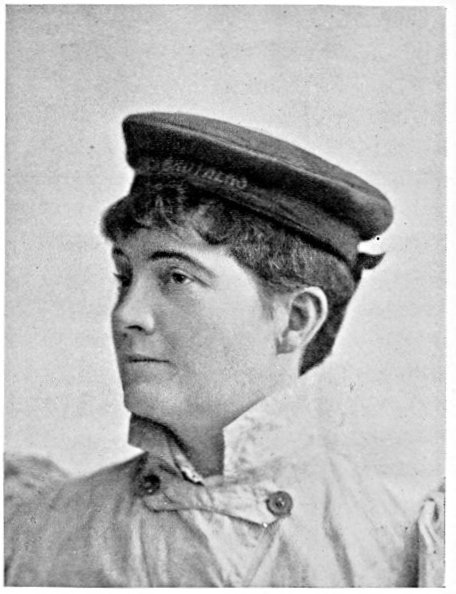
Lombardi and Co. 13, Pall Mall East.
MRS. W. L. WYLLIE.

The first punts on our river—the Medway—were simply flat-bottomed shoe-shaped boats, which were built to slide over the mud, and were principally used by muddies and watermen, or by those people who, having boats anchored off the shore, required something they could push over the intervening flat. With a wind astern or on a slight incline in the mud, the slipping process was simple, the happy owner of one of these primitive punts finding himself on the river with but little trouble. A friend of ours at Gillingham determined to build himself one in his own dining-room to use for rowing, and being of an ingenious turn of mind, as he had to pull the punt up into his garden every time she was used, he added a detachable wheel under the bow, and then by fixing her oars on either side of the gunwale as handles, he was able to wheel her up and down[Pg 68] the causeway with the greatest ease. This friend had long since found out that the Gillingham boy, boats, and mud did not agree. He it was who first saw the possibility of the punt being turned into a sailing boat, and when this idea occurred to him he started building the Snowflake, an ordinary mud punt with square chime, a centre plate and lug, which in its turn gave place to another named Crystabel. A small club was then thought of, for the purpose of opening up the healthy enjoyment of punt racing to the working class, and it was soon formed and my husband invited to become Commodore. A small subscription of half-a-crown, and a shilling entrance fee, made it possible for the working man to enter, and most races were arranged to suit his convenience. The money was paid to the officer of the day before the start, and only by the boats competing.
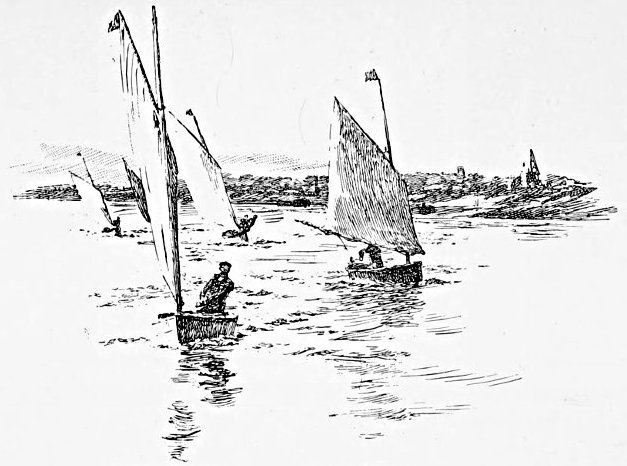
CRYSTABEL. NELSON.
Sketch made by W. L. Wyllie, A.R.A. For The Sportswoman's Library.
PUNTS RACING.
Punts in those days only cost from £4 to £5,
and we soon had several. Our eldest son was
promised a boat as soon as he could swim, which
hurried matters, and a new punt was laid down,
finished and christened Nelson before the summer
was out, but this, as well as all the earlier
ones, leaked. Then a real start was made. My
husband being fired with the idea of improving
[Pg 69]
[Pg 70]
[Pg 71]the breed, began cutting out and drawing many
models preparatory to building. The greenhouse
was found to be the only place long enough, so
the boat throve though the flowers faded, the
pots grew chips and copper tacks to the despair
of the gardener, and we had no show of flowers
that winter. In the early spring, the new creation
was taken into the little wood close at hand,
and there with the sweet primroses and bluebells
growing all round her was turned bottom up for all
who were interested to come and sand-paper her
whenever there was a "spell oh" in the course
of the day's work. She was then finished off with
a scarlet coat, and carried on the shoulders of
four men in procession to the beach, where the
christening ceremony was to be performed. At
the moment, the family being full of Lear's Nonsense
Songs and Stories, the little girl insisted she
must have lavender water tinged with pink. So
this of course was supplied. The boys ran up
flags and hurrahed enough for the launching of a
first-class cruiser, the men gave a big shove, and
the little girl broke her bottle, calling out good
luck to Scarlet Runner. This punt never leaked
a drop, and sailed splendidly for her size, though
unlike the accommodating bicycle of a well-known[Pg 72]
song, she would not hold two, and in a sea little
but a man, mast and sail could be seen. At this
time bigger punts were built, principally by Mr.
Baker, a fruit-grower of Gillingham, who introduced
a stronger, larger type with much higher
freeboard. From his little yard were launched
Tar Baby, Go By, Satan, and lastly Black Bess,
which held her own against all comers. The
blacksmith also built Ethel and Mud Puppy, so
that altogether there was a nice little class. Scarlet
Runner, after several alterations, ultimately beat
Black Bess. Then came a decision to sail under
Y.R.A. rules, and bring the boats up to half-rating.
This in most cases meant building afresh,
so once more Commodore started chipping bits
of nice soft wood, till the desired shape for the
new punt to hold two was arrived at. We then
hunted for a building shed, and at last settled on
a loft over the stables, a nasty draughty place, but
one with plenty of room. The punt was drawn
out life size on the floor in chalk, and five nice
fir planks were procured from the village carpenter
for the bottom. The centre plank was one
inch thick, and the two on either side three-quarter;
a grown oak knee formed the stem, and
another the stern post, and to these a strong rope[Pg 73]
was fastened to make into a tourniquet to give
the proper rocker to the bottom. Every day as
it grew dusk, off we all went to that horrid cold
loft, lit up the lamps and started an abominable
din of hammering, a boy generally buzzing round
the while with a broom to clear away some of
the chips. When I grew tired of crouching and
holding a hammer to the rivets, then the boy was
victimised. The wheelwright came to lend a
hand in the evenings, and envy seized my soul as
I watched him send home screw after screw as if
they were going into so much butter. Commodore
would not even leave his work to come in
to dinner, and looking back now, I really think
it must have been a very uncomfortable time.
The sides were made out of one wide plank of
Kauri pine without a join. This was riveted to
the beams and angles of Bull metal, and a devoted
friend put in the mast step, which to this day
holds all the water it catches, sending up a spirt
as the mast drops into place. The centre board
case gave a good deal of trouble, but even this
gave way to patience. The seams were gone over
with the greatest care with putty and varnish, as
we were determined she should not leak, and the
mixture proved most satisfactory, as whatever[Pg 74]
water the punt shipped ran out of the centre
board case, and never a drop came through the
seams. I was greatly distressed when the well
was put in. I really could not see how I could
be expected to sit in any comfort on a butcher's
tray, which it resembled. The idea in itself no
doubt was lovely, for any water coming on board
emptied itself out of the tray, which was flush
with the top of the centre-board case, down the
case, thus making the boat absolutely unsinkable.
But fancy sitting for hours with one's knees up to
one's chin in a calm. I argued for a long time, and
was made to sit in position over and over again,
my husband declaring it was quite comfortable,
but I could not see it. I agreed, however, to waive
the question till the punt should be afloat. So a
light deck was put on her, with canvas strained
and painted over it, and then she was turned bottom
up on the tressels, and Commodore planed,
whittled and sand-papered till every line was
beautifully fair. The rudder was shipped on to
the transom on the curved Bull metal gudgeons,
so that if it touched the bottom it slid up the gudgeons
without coming off. It could also be triced
up with a line when sailing in shallow water.
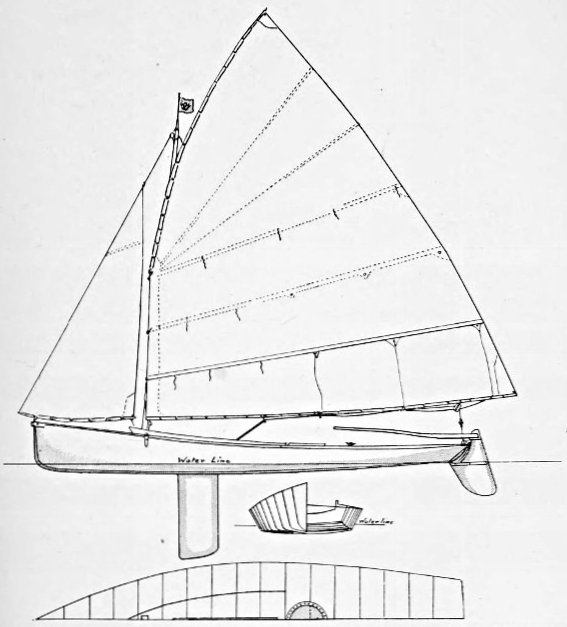
From a Drawing By W.L. Wyllie, A.R.A.
PUNT: SEA MAIDEN.
At last came the happy day for launching, when a cart was brought up from the farm filled with straw, and pulled up close under the door of the loft, the punt being lowered away carefully on the top. In procession we followed down the old road to the brickfields, the little girl[1] bringing up the rear in her chair. When the cart had been backed as close down the river as possible, Sweet Pet dashed her bottle of wine against the boat's side, and with a little excited shriek, called out good luck to Sea Maiden, as the punt plunged into the water.
That same evening, Sea Maiden's sail plan was calculated, and drawn out. We have very strong ideas of our own on the sit of a sail, and had proved by many experiments that a sail that sits dead flat is a mistake, but to make sure, we made one more trial with a lot of little paper vanes stuck on pins, and setting our sail, pinned these right across, shifting them time after time as we sailed about. Then we came to the conclusion that there should be a fairly flat after-leach curving very gradually to the luff, and that seams carried across the sail in the direction of the wind, caused less deflection than the usual seams up and down. Now the carpet was rolled up in[Pg 78] the drawing-room, and our union silk cut and ruled with the greatest care, each seam with half-an-inch curve towards the luff over-lapping to form pockets for the light ash battens, and a nice round after-leach and foot. Then came the machining, which was simple enough, and fell to my lot, and in time the sail was bundled up and sent off to be roped, with strict injunctions that it was to be sewn loosely to the rope, especially the luff. When it came home it was set between a tree and a fence, where through the early spring it flapped gently up and down whenever there was a light breeze, stretching and improving itself in the sun. Sailing was then started in real earnest, so that we might learn the ways of the boat, and get all the gear to work with the least amount of trouble, before the racing came on. Our balance-jib looked after itself, being laced to a light ash boom. In going to windward the sheet was always fast, and when off the wind it could be goosewinged in a second by letting the sheet run, and pulling on the lee-guy, so that what little we lost in the size of the sail was counteracted by the speed with which we could handle it.
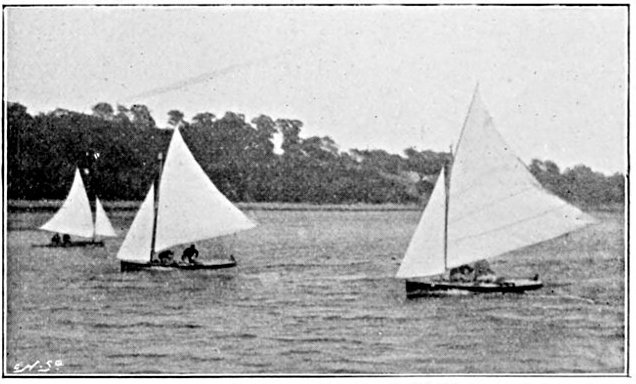
Drawn by W. L. Wyllie, A.R.A. For The Sportswoman's Library.
PUNTS RACING.
(THE RACE.)
That butcher's tray was uncomfortable, and
[Pg 79]
[Pg 80]
[Pg 81]there was not a thing in the boat I could lay
hold of to keep myself on board. Only those
who have sailed punts can imagine the rapidity
of their movements, and my first attempts were
certainly exciting, as only having the tiller to
hold on to, which naturally was not of much
use, it came over with me. I several times
nearly went backwards into the river. After
this, Commodore cut a square out of the well,
so that my feet could just fit down, and framed
it in with water-tight canvass, and so altered
matters that my real joy in sailing began. The
feeling of being run away with in a boat is glorious,
and a good punt is hard to beat at this.
The excitement keeps you in a glow, though the
water breaks all round and over you. The first
race in which I steered we won, and then began
a record on our own river. Punt after punt was
built to beat us, but still Sea Maiden came in first.
Emboldened by our wins, we took her round to
the Thames to try her against the half-raters.
Our first race was over the circular course off the
Royal Corinthian Club, at Erith, in a very strong
wind. As we stepped on board the Sea Maiden,
the waterman, from a little grey steamer that was
being repaired, begged us to be careful, as it was[Pg 82]
blowing very hard and we should find more sea
on the other side. Mr. Hope thinking Lotus'
mainsail too big for her, hoisted one belonging
to a dinghy, the other boats starting closely
reefed. Lotus led the first round, with Sea Maiden
a close second, but the wind gradually lightening,
Lotus increased her lead. We saw it was absolutely
necessary to shake out our reefs, which we
dared not do whilst close-hauled, so we could
only wait impatiently as the stern of the leading
boat grew smaller and smaller. At last we got
round the buoy, and out came our reefs in a
minute. The effect was magical, and we ran up
to Lotus hand over hand, till by the time we
reached Crayford Ness mark we were close astern.
Mr. Hope could not stand this, so began shaking
out his reefs, but we now had a turn to windward
and at once passed him, and throughout the remainder
of the race kept the lead. The boat was
looked at with great curiosity as we came alongside
the causeway. She was called a "Thing," an
"Eggbox," and other uncomplimentary names,
but all agreed that she could go in a breeze.
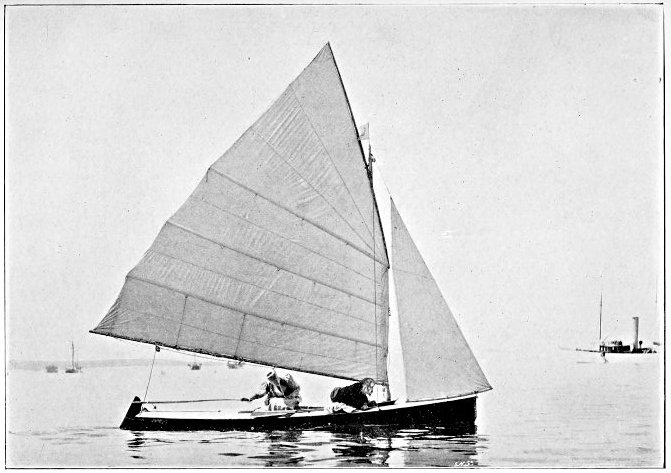
A. Debenham. Cowes.
SEA MAIDEN.
Next day was almost a perfect calm. A racing
tide was running down the wind to Greenhithe,
and we were all mortally afraid of being drifted
[Pg 83]
[Pg 84]
[Pg 85]over the line before gun-fire. Nevertheless, we
thought it best to risk it, and consequently stood
away close hauled right into the middle of the
stream, the other boats meanwhile keeping in a
little eddy close to the shore. When the gun
did go they were over the line long before us,
but we were in the middle of a swinging tide
which swept us away at four miles an hour,
whilst the others were all trying to work out of
their little slack. On reaching Greenhithe we
found we had left our instructions behind, and
could not remember on which hand to leave the
buoy, so to make no mistakes rounded first to
port and then to starboard. Unfortunately
Lotus came in sight as we rounded the wrong
way, and having also left her instructions behind
was led astray. Our very light draught enabled
us to skirt the mud out of the tide all the way
back, and brought us in first again with a very
long lead. Our third race was sailed in a
moderate breeze which fell to almost a dead
calm at the last. Lotus led for the three rounds
of the circular course, and do what we would it
seemed impossible to pass her; however, at the
very last, a stretch of strong tide had to be
crossed to reach the line, Lotus left the slack[Pg 86]
first, sailing straight for the mark. Seeing it
was our last chance we kept away in the slack
much further down, then started across keeping
the line on our weather beam and the tide on
the lee-bow, we slowly drifted crab-wise across
the broad stretch of river. It was a moment of
intense excitement, the wind had died down to
a mere breath and a crowd of tugs, huge steamers
and drifting barges were coming up with the
tide, we had to pick our way through these as
we both converged towards the bobbing flag-boat.
Lotus, seeing her mistake, set a spinnaker
and tried to stem the tide, but it was too late,
and again Sea Maiden took first gun, and the
Muriel Challenge cup for the best of three races.
The punt went on winning after this, till we were afraid of being disliked on our own river, so put her in a railway truck and took her down to the Solent, where the storm drum was up and a sou'wester blowing in heavy squalls. As we started across from Portsmouth Harbour, we reefed down small, for the sea was the biggest I had ever sailed the boat in, the waves breaking completely over us, filling my bucket and drenching us both to the skin. A strong tide too was running to windward, but we got into the[Pg 87] shelter of Wooton Creek in a very short time, and were most hospitably received in the Canoe camp and dried bit by bit. Our first race on the Solent was at Ryde, for the hundred-guinea cup, presented by Mr. West. And here we met our old enemy, Lotus, which had been doing wonders against the Isle of Wight craft.
Unfortunately, Mr. Hope exclaimed as we came up, "Hullo, Mrs. Wyllie, I think the race lies between the Thames and the Medway today." Now this was most unlucky, as we have always found that wherever any bragging is done we are sure to lose; and so it proved. Keeping an eye on the time ball on Ryde Pier, Sea Maiden was first over the line, the wind was terribly light with a nasty bobbly swell which seemed to knock the life out of her. The boats with heavy lead keels went through it better than she did, and it was not long before we were passed. After rounding the Stourbridge it was a close pinch to Gillicker point, with the tide racing out and the sun blazing and dazzling one's eyes with its reflection in the oily heaving water. It was a weary time, and as we became mixed with the lagging members of the large fleet of one-raters which had started before us, our chances for that day[Pg 88] were lost. It took the best part of a day to sail the one round. The Thames and Medway were not in it, Sea Maiden finishing an inglorious seventh.

PUNTS RACING.
Next day there was a little more wind, and Lotus came in a very good first, Sea Maiden second, and Wee Winn third. The moment the race was over, the helm was put up and we ran across to Portsmouth hard, and in two hours from the finish, the boat was safely placed on the truck that was to take her to Burnham-on-Crouch, where we were to do some racing, and where Lotus took first each time. There we had a week of first-class sport, some of the races being very exciting, one especially so, for there was a long run in a heavy sea, ending up in a jibe[Pg 89] round the buoy which some did, and some did not do. It was a breathless moment as the boom came over and we careered away at a tremendous pace, the boat rocking wildly from side to side, and the waters seething all round and over us. Suddenly I found I had no grip on the helm, the rudder having floated up on our following wave. She broached to at once, and though, thanks to Commodore's prompt letting go of the sheet, we managed to save a capsize, it was a close thing.
That year we sailed twenty-seven races, winning fifteen firsts, six seconds, and two thirds, and ending the season on the Medway with a series of matches in which we all changed boats and crews. It was on a lovely autumn afternoon that we anchored our barge yacht under the wood as committee boat, with tea, something stronger, dry clothes, and a party of friends on board. In every case and with every crew Sea Maiden came in first, till we persuaded Lord Charles Beresford to sail his Undaunted with our sail, when she at once turned the tables. Next year there were a number of new punts built, namely: Mosquito, Star Fish, Water Lily, Princess May, and Tartar. The Royal Engineers, too, built the Terrible and Powerful, sister ships, with[Pg 90] long overhanging sterns, and Captain Mareney, R.E., with his own hands built Bébé, which has proved the fastest of her class. In a strong wind the Bébé's speed is something quite phenomenal, and one race she sailed in a hard gale, surprised everyone who saw her. Mr. G. C. Kerr's punt, L'Espérance, besides being good-looking, sails very fast; and on one occasion, in a light wind, beat the seventeen-ton, Buccaneer, in a race to Sheerness and back, without time allowance. Owing to the drawing of our punt, which appeared in the Field, there have been many imitations of our flat-bottomed class started in different parts of the world. The Puffins at Plymouth, a little fleet at Weymouth, the new class at Southampton, and individual boats in Scotland, Northumberland, Anglesea, Florida, and even distant Hong Kong. There was a rumour that a challenger for the Seawanhaka Cup should take the shape of a long flat punt, and for this purpose a drawing was made by one of our most celebrated designers, but the Canadian holders of the cup have accepted the American challenge, instead of that of the Minima Yacht Club, so, this spring, the sound of the hammer will not be heard in our loft.
M. A. Wyllie.
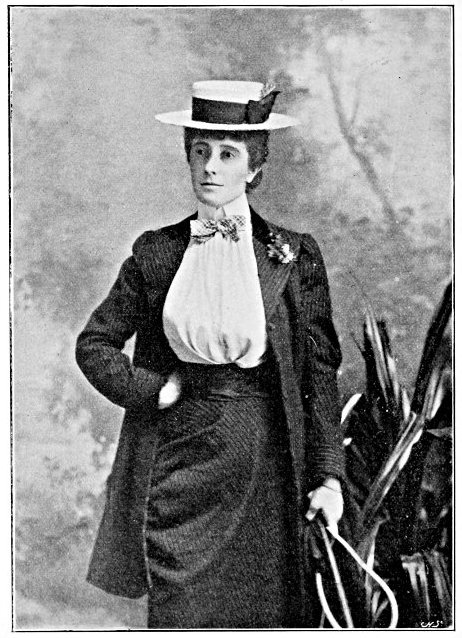
MRS. PENN-CURZON.
[1] Mrs. Wyllie's invalid daughter.—Ed.
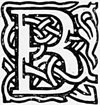
Books and Magazine articles dealing with the Chase and the habits of the Red deer, are so many and so excellent that I feel diffident about attempting to say anything on a subject that has been so thoroughly thrashed out. In old days, or at any rate twenty-five years ago, very few people wended their way Westward in the months of August and September, to see what has now become such a popular sport. The crowds at the present time are now enormous, often worse than the Quorn fields, and the riders all full of zeal and desperately anxious not to miss anything from find to finish, thus often causing the Master no little anxiety, and trying his patience sadly.
In case my readers are not acquainted with the method in which stag-hunting is conducted, I will try to give a brief history of a day's sport. In the first place the deer must be harboured,[Pg 94] that is "slotted" or tracked into covert, and this requires great knowledge of woodcraft on the part of him to whom the business is entrusted. The harbourer's business is to find out that his deer is a warrantable, i.e., a runnable, stag, which he can tell by the size of the slot, or footprint on the ground, and he must also make sure that his quarry has not passed through the covert. To do this he must search carefully for a slot leading out of the wood, or if the covert be too large he must make good as many of the paths round where he thinks his deer is lying, as he can. The difference between the slot of a hind and a stag is almost imperceptible to the ordinary eye, but if closely observed it will be noticed that the slot of a stag is larger and has a wider heel and blunter toes, also that an old heavy deer has his toes frequently uneven in length, while a hind's toe is pointed, and she has a narrow heel. In an old deer there is generally also a little space open between her toes. The harbourer can tell whether a stag or hind has been feeding, and though the signs believed in by some are disputed, one infallible test is whether the ash shoots have been nibbled or not. For while the hinds and young deer do[Pg 95] not affect them, stags have a perfect passion for them, and the delicacy seems to be as irresistible to them as oysters and caviare are to a human gourmet.
The harbourer generally goes to the scene of action the day before the meet, and gleans what information he can from those whose knowledge he can rely on. With regard however to the feeding ground of the deer, he will do well to depend entirely on his own eyes, and to form his own conclusions. Next morning he must be afoot in the small hours, and look for any fresh slot pointing towards the covert, made by the deer returning from feeding. Should he see what he thinks belongs to a warrantable deer, he must next make sure the animal has not gone through the covert, and if the woods be very large, he must try and localise him as much as possible. The late Miles, who was the harbourer in the Devon and Somerset country for so many years, was a marvel in doing this, for he seemed to know the habits of the deer as well as they did themselves. His loss to the hunt was irreparable, for apart from the harbouring, he was of unbounded assistance during the run, and often when the deer seemed hopelessly lost, and[Pg 96] Master and huntsman were in despair, have I heard Miles's whistle and his cheery holloa, saving the day at the eleventh hour.
For the business of tufting, as finding the deer is called, four or five couples of the strongest hounds are required, as they will have to run with the pack afterwards. Also, it is well to select those hounds most inclined to throw their tongues, as their deep notes are more than welcome in the big coverts, where they get out of sight. If the deer has been well harboured and is inclined to leave covert quickly, so much the better, but patience is often sorely wanted in stag hunting, when a cunning old deer will double back into covert time after time, and turn out his younger relations to try and get hounds off his line. We will suppose, however, that the deer has chosen to break covert quickly, and the welcome sound of Anthony's horn means that the body of the pack, till now kennelled in a convenient barn or stable, will be laid on. If the deer has chosen a good line, that is over the forest, we must pull ourselves together and save our horses wherever possible, knowing that we may gallop for eighteen or twenty miles or more.
It is wonderful how two or three miles over[Pg 97] holding ground will steady a field, and weed them to within reasonable bounds. I consider Exmoor the worst possible country for a stranger to take his own line, the best man to hounds on earth cannot tell some of the crossings by instinct, many of the combes having only one even decent crossing, and that has to be negotiated with care. Most people, however, seem to come down with the idea that Exmoor is one vast bog, which is all nonsense, for most of it is quite rideable, or at any rate you can pick your way over it. The crossings are the worst drawbacks to riding straight to hounds. A large majority of the field ride to points, and most annoying it is, after you have galloped your hardest at the tail of hounds, to see a batch of tourists who have been piloted by someone who knows every inch of the country, and who has guessed the stag's point, with comparatively fresh horses, while your own, no matter how carefully you have nursed him, has pretty nearly had enough.
A deer will nearly always soil once, if not oftener during a run, and it is marvellous how a plunge in one of the many streams, or a roll in a peat hole, will refresh him. Stags, especially the older and fatter ones, generally lie down after[Pg 98] they have run for a time if not pressed, that is if hounds are not laid on at once, and the master generally gives a big heavy deer a little law. A fresh find is a beautiful sight, and the tricks and dodges of a wily old stag would fill many chapters. To anyone fond of seeing hounds work, and not only anxious for a gallop, the sight of hounds trying to pick out the line of their deer, when he has gone up or down stream, is alone worth going out for. It is extraordinary how long a deer's scent will hold on the moor. It is no uncommon thing for hounds to hunt up to, and kill their stag, after he has been two hours ahead of them.
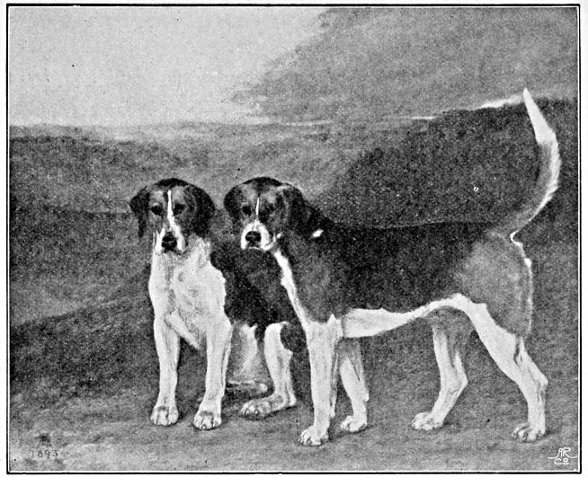
HOUNDS OF THE DEVON AND SOMERSET PACK.
(From a Picture in the possession of C. H. Basset, Esq., of Watermouth Castle.)
One thing in hunting the red deer impresses
people very strongly who have only seen foxhunting,
and that is the way hounds tail on the
moor. Several explanations of this are given.
One is that the deer running in a straighter line
than the fox, the fastest hound gets in front and
stays there, others say that it is easier to get
through the heather in a string, and again some
hold that the scent of a deer being very sweet,
hounds run one behind another to get it all.
When they do carry a head, the sight of the big
hounds, none under twenty-four-and-a-half inches
[Pg 99]
[Pg 100]
[Pg 101]and all unrounded, racing over the heather, is a
very fine one. Deer almost invariably die in the
water, either in one of the numerous streams or
rivers, or going to sea. In the last case they have
to be followed by boatmen, and are brought to
shore and killed. This is the greatest drawback
to stag hunting, but it is no good being sentimental
about it. The deer do an immense amount of
damage to the farmer's crops, and if they were
not killed in the chase they would very soon be
shot, and stag hunting would be no more, so that
my advice to those who cry out about the cruelty
to "the poor dear stag," when they see him
being ignominiously towed to shore, is to stay at
home, so that their feelings may not be hurt by
the sight.
It is wonderful how the more ignorant portion of the large field of strangers, who condescend to honour Exmoor with their presence in the stag-hunting season, grumble unceasingly at the sport. The country, Master, hounds, and hunt servants, all come in for scathing criticism. One has a great longing to let them try and hunt a deer themselves, to convince them that it is not such A B C work as they seem to think. Also, should the Master persist in remaining in a covert to[Pg 102] hunt the big deer he knows to be there, instead of laying on to the four-year-old which has just broken away over a tempting line on the forest, there is a chorus of discontented ones, "Oh, what rot this is; why can't he go after a decent deer?" The malcontents, either forgetting or not knowing that it is the fat old sinner now doing his utmost to save his skin by turning out his younger relations, which gorges himself nightly on the farmer's best turnips and corn, and that it will be a poor consolation to the latter if hounds pursue a young deer twenty odd miles and then lose him, while the author of the mischief is left, possibly with a keener appetite than ever, after his unwonted exertions.
There is always a hope that a big fat stag may be run up and killed, should his whereabouts be a certainty, in time to lay on to another, and I have often seen two deer killed in one day. A fat stag which is merely blown and not exhausted, will waste a lot of valuable time beating up and down the water, too out of breath to breast the hill and give a gallop, and too strong to be pulled down. This gentleman is a most unpleasant customer to tackle, as in fact is any deer at bay. A stag is a grand looking beast when he stands[Pg 103] with his back against a rock, in one of the picturesque streams that abound on Exmoor, with his lovely head well up, and great, sad, frightened eyes, the pack baying round him and not daring to come within striking distance of those death-dealing horns. The sooner then the huntsman, or one of the willing farmers always at hand and ready to assist, can slip behind the beast and lasso him, the better for everyone.
The head and slots of stags are the Master's perquisite, the skin and inside and the hinds' heads belong to the huntsman, who generally shares the liver with the farmers. The carcase is distributed amongst the farmers on whose land the deer was found, and who highly appreciate a bit of venison. The Master alone never gets any, and to speak for myself I have only tasted hunted stag once. This was when my mother was sent, by a kind neighbour, a haunch of a five-year old deer, which had given us a run of nearly thirty miles, and very excellent it was. I have never seen a more vicious stag either than this one, for though he had run from Cloutsham to within five miles of my mother's home,[2] he fought desperately and severely injured two[Pg 104] hounds before he was taken. I always remember that gallop too on account of the marvellous way the puppies worked, with hardly any old hounds to help them, my father[3] having saved the older hounds for the next day, when he was meeting in a close woodland country, where he thought the inevitable crowded field would work less havoc among the older and more sensible hounds than on the puppies, many of which were hardly way-wise.
There is one delusion that strangers labour under who meditate a few days with the Devon and Somerset Staghounds, and this is, that it is absolutely necessary to ride "the horse of the country," as they term it. I think this is quite a mistake. Any horse that looks where he is going, and doesn't go yawing about with his head in the air, will go well on Exmoor, at any rate after a time or two, but horses accustomed to the country certainly get less frightened in soft ground than strangers. In fact, a moor-bred animal wont go into a bog at all. I have ridden all sorts and conditions of horses, and I think I would choose animals that stand about 15.1 or 15.2., short-legged and strong backed and with good[Pg 105] shoulders, for though I have seen a little straight-shouldered Exmoor pony canter down a hill without a false step, when most people have been leading down it, yet I never think it gives you a comfortable sensation to be sitting almost on your horse's ears. Two things are absolute necessities, blood and condition, without these one cannot hope to get to the end of a long moorland gallop with comfort to either man or beast. I know no more hopeless-looking objects than a poor underbred and underfed hireling, floundering through the wet ground, remorselessly urged on by an ambitious but ignorant tripper, whose pedigree will probably bear even less looking into than his unfortunate steed's. For a very light weight with extravagant ideas, polo ponies would be ideal mounts, being in the height of condition, after the close of the season at Hurlingham, and very fast and handy on their legs, but it is not everyone who can afford or would care to risk valuable animals on such broken ground. Some people hold that big horses are better than small ones, but I cannot say I agree with them. A large horse shakes himself and his rider to pieces galloping down the hills, and if you would see a long run well,[Pg 106] you must gallop down hills, and take it easy up them; he also does not recover himself so quickly should he make a mistake over the rough ground, and is more liable to strains and over-reaches in the boggy land, to say nothing of the fact that he can frighten you to death in the tiny narrow paths through the woods, where a false step means rolling into the river many feet below. A small horse may be quite as dangerous, but I don't think he feels so clumsy, and again, a small horse undoubtedly comes to time again sooner after a hard day. One thing I specially dislike on the moor, and that is a hard puller. People say, "what does it matter, when there's heaps of room." This is all very well on a racecourse, but when you are on the verge of almost a precipice intersected with ruts, peat holes and other trifles, with either a bog or a river waiting for you at the bottom, it is very poor fun to be hardly able to steady your horse, much less hold him, and I have seen some very nasty falls resulting from the inability of an unhappy sportsman to control his mount.
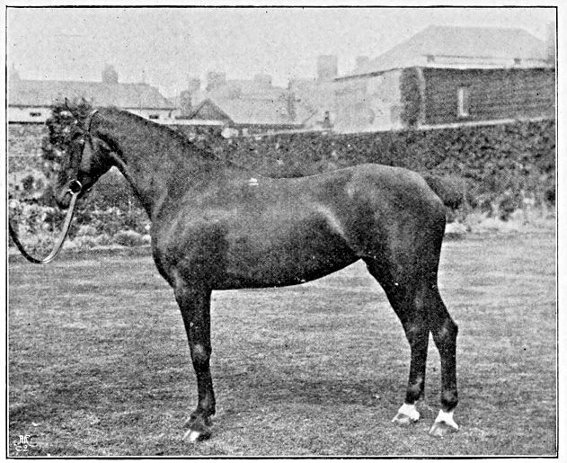
PRINCESS, IRISH MARE.
(Property of Mrs. Lewis Mackenzie.)
You can also have a nasty fall if you try and
descend the steep combes sideways. It is a
golden rule to ride a horse straight down. At[Pg 107]
[Pg 108]
[Pg 109]
the worst then he can but sit down, but if you
are half cantering, half shambling down a hill
sideways, and your mount puts a foot wrong, a
horrible fall is the probable result. It is a wonder
to me, looking at the crowd of people riding,
most of them ignorant of the first principles of
horsemanship, why there are not more bad falls
than there are on Exmoor. Now and then it is
true a man gets his face cut, or a rib broken or
something of that sort, but really bad accidents
are most rare. I suppose that the sweet little
cherub that sits up aloft, looks after the welfare
of the bold tripper, or perhaps the softness of the
ground has more to do with it.
I think Exford is the best centre for stag-hunting, that is if you do not mind having absolutely nothing to do on the off days, or have enough horses to go out with the foxhounds or harriers. Some people like Minehead, others prefer Dulverton. Personally I prefer Porlock, as it is quite close to the Moor meets, and is far and away the prettiest place to stop in. Accommodation is good and moderate, hirelings are to be obtained there and at Minehead, and are generally very good animals, though I would advise anyone with a couple or more well-bred[Pg 110] horses in condition, to bring them down. The difference in comfort, especially in the long distances hacking home, is great.
Special care should be taken of saddles for this work, for there is no country where horses suffer so terribly from sore backs as Exmoor. The steep climbs up and down hill, the great heat, followed by standing still till a horse is chilled, then another gallop perhaps, and lastly a long ride home, horse and man, or oftener woman, dead beat, work absolute havoc in a stable full of otherwise sound horses. I would advise anyone hunting with the staghounds to have all saddles thoroughly fitted, if possible one for each horse, the horses' backs hardened a little, and above all to see that the saddle is left on the horse for some time after he is cool, whenever he comes in from hunting. Very few persons will take the trouble to do this, especially when a horse comes home about eleven o'clock at night, but it should always be insisted on.
Towards the end of September is to my mind the pleasantest time on Exmoor, and from the middle of the month to the time stag-hunting ends, about the tenth of October, sport is generally far better than earlier in the season. The[Pg 111] deer break covert quicker, and run better, the weather is cooler, and Cloutsham which has in the earlier part of the season, been the happy picnic ground, to crowds of delighted strangers, now affords a sure find of a good Stag. This is, thanks to its kind owner and his son, who though not hunting-men themselves, are most desirous of showing sport to others. So much has been said about this opening function at Cloutsham and the beauty of the surrounding scenery, which in fact cannot be over-rated, that I will not allude to the "vast leafy combes," the "hazy outline of the Welsh coast," and the "stately purple-clad hill of Dunkerry," except to warn those who have never tried to gallop over the said Dunkerry that it is the most deceptive bit of going to my mind in the whole of the stag-hunting country. It is covered with rocks and stones, alternating with bogs, and is generally productive of a lame horse. I never saw it look so lovely as one day during hind-hunting.
It was a soft muggy day in November, and I was standing in a field behind Cloutsham farm, when a hind went away over Dunkerry. As I was riding a pony, I stood still and watched the[Pg 112] proceedings. Anthony laid on, and the whole hunt swept away up the hill, and as they did so down came the fog like a curtain, but only covering half the hill. By and bye, back came the hind, and ran into Sweet Tree, as the extension of Cloutsham Wood on the Exford Road is called, and the hounds, huntsman and field all came one by one out of the mist. It was like a ghost hunt. Twice did that hind do the same thing, and then sent a young sister to take her place, but hounds were luckily stopped and the wily lady was captured, after a great deal of twisting and doubling up and down the water.
Very few people have any idea of the different aspect the country wears in the hind hunting season to what it does in stag-hunting time. In August on your way to the meet, you pass dozens of people, walking, riding, or driving, the latter with huge luncheon hampers, which are most welcome later on. The meet may be at Culbone Stables, in which case the Lynton road outside Lord Lovelace's plantation will be packed with carriages, etc., and people will idle about and stand in groups among the stunted fir trees, looking out on a calm blue sea. The stag may after some time "go to moor," and then away go the[Pg 113] field after him, but for hours there will be carriages on the Lynton Road on the chance he may turn back and go to sea, which he may very likely do. In this case, those of the riders who have had enough, will turn round at the top of the hill and go home, but the majority will ride down through the Ashley Combe woods to the sea, and wait in the warm August afternoon till the stag is brought to land. The fishermen from Porlock Weir are always on the look out on a hunting day for a possible windfall in the shape of a deer going to sea, which means a sovereign in their pockets. The field meanwhile refresh themselves and their horses at the picturesque little hotel, the Anchor, and after the last rites of the chase have been gone through, ride home in the cool of the evening.
In hind hunting on a bitter December day, we
have a very different picture. About four shivering
women, or perhaps fewer, half a dozen sporting
farmers, the Master and the hunt servants
form the field. The women generally make a
bolt for the little cottage at Culbone Stables, and
sit round the fire there till Anthony comes for the
pack. The wind is blowing half a gale, and sleet
is falling, but once we are started no one cares[Pg 114]
for the weather. Deer, unlike foxes, will run in
the teeth of the fiercest gale, and sometimes one
is literally nearly blown out of the saddle. The
hind which has probably left her calf lying in her
bed, will run a big ring out to the Deer Park
and back. With the ground at its heaviest, the
small field has to gallop its fastest to keep the
flying pack in sight. Back into Culbone the
hind comes, and we stop and listen, and wonder
if she will go to sea, trying in the meantime to
get a little shelter from the icy wind under the
larch trees. But our friend has not had half
enough yet, and may take us over the same ground
again, if she fails to induce another deer to take
her place, or possibly we may go away after a
fresh hind without knowing it; heart-rending
work this for horses and hounds. Ultimately she
will go to sea, either down the steep cliffs of
Glenthorne, or from Porlock Weir, and the boatmen
have to follow her, supposing it is not too
rough for their safety, while the field, by this
time of still smaller dimensions, wait patiently
for the end. Then home we go. Porlock Weir
was comparatively sheltered, but once on top of
the hill again, the gale seems to have increased,
and the sleet to be thicker, and by the time we
[Pg 115]
[Pg 116]
[Pg 117]get home we are nearly frozen, and it is pitch
dark. Yet to my mind notwithstanding the horrible
weather, hind hunting is a finer, wilder
sport than stag-hunting, and a run after a straight-going
hind in the spring when the weather is
better, is hard to beat. Fog is the great enemy
to hunting in the winter. Often the hounds
have to go home from the meet, after waiting a
couple of hours and more for it to lift.
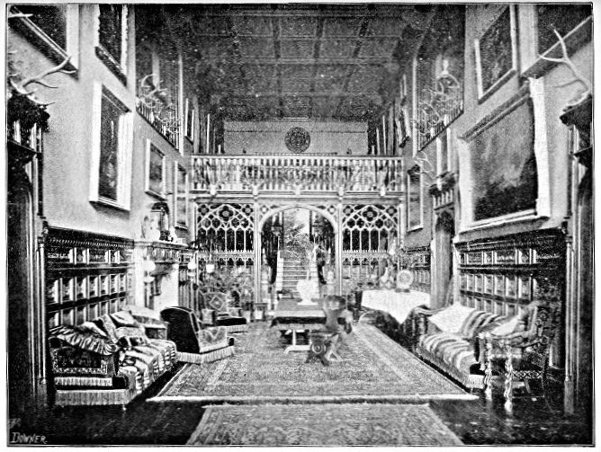
F. Downer. Watford.
HEADS AT WATERMOUTH CASTLE.
I do not think casual visitors have any idea of the immense strain on hounds, horses and men that hunting from July to April entails, or they would not grumble as much as they do when they get a poor day's sport. Rather let them follow the example of one most genial tripper, who when a friend of mine remarked we had had a shocking bad day, nothing but wood work, said: "Well, I 'ear folks say they 'aven't 'ad a gallop, but I always 'as a gallop, and what I do is this. I watch one of them 'scarlet bounders' (presumably the huntsman), and when he lays on to the stag, I don't care where 'e is, I lays on to 'im. It takes a bit of doing too, and I always 'as a gallop!" Whether the "scarlet bounder" was equally pleased with a noisy follower, when he wanted to catch the slightest sound in covert, is another[Pg 118] matter, but a jovial sportsman of this sort is far more welcome to the West Country than those people who go down and grumble at everything, and generally depart with the donation of a few shillings to the deer damage fund.
It is out of this fund the farmers are paid for the harm done to their crops by the deer, and richly they deserve some compensation, for without their help stag-hunting on Exmoor would soon be a thing of the past.
Edith Curzon.
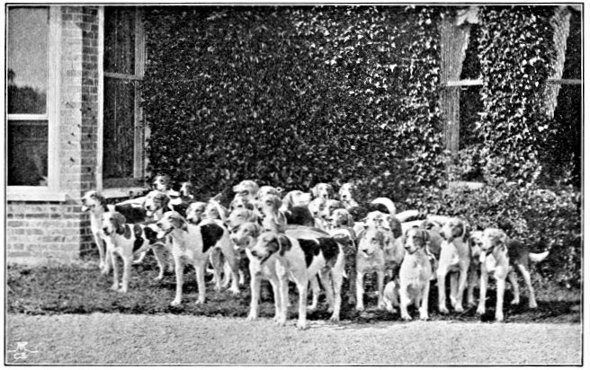
SIR JOHN AMORY'S STAGHOUNDS.
Though when Mr. Fenwick Bisset undertook
to revive Stag-hunting on Exmoor in 1855, the
attempt was regarded almost as a forlorn hope.
It has now been found necessary to start a second
pack in Devon, in order to keep down the herds
of red deer. The last established pack is a
private one belonging to Sir John Heathcoat
Amory, and its popularity with all classes of the
sport-loving West country is very great. Mr.
Ian Amory hunts the hounds himself, and he is
assisted by the Messrs. Las Casas, who act as his
[Pg 119]
[Pg 120]
[Pg 121]whippers-in, the important duties of the harbourer
being also performed by an amateur.
Everything in this establishment is carried out
in the most sportsmanlike manner, and the time-honoured
traditions of the hunt of the wild red
deer are strictly adhered to. The sport shown
by this pack, since its institution in 1897, has
been excellent, and to the sportswoman who
dares not brave the storm-swept expanse of Exmoor
during the winter months, and yet loves
to share in the grand sport of hind-hunting, the
less exposed country hunted over by Sir John
Amory's staghounds offers very great advantages.
The picturesque little town on the Exe, indeed,
is likely to take a high place among Western
sporting centres, for it offers the triple attraction
of the pursuit of the stag, the fox and the hare
in its immediate neighbourhood.
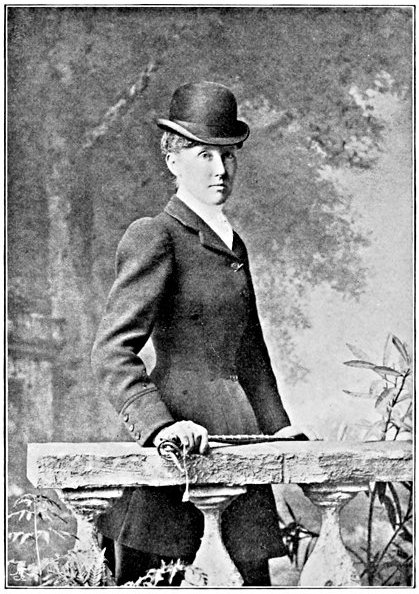
J. Weston and Son Folkestone.
MRS. CULPEPER CLARKE.
[2] Near Ilfracombe.—Ed.
[3] Mr. C. H. Basset, then Master of the Devon and Somerset Staghounds.—Ed.
NOTE.—This article has been kindly read and approved by Mrs. Culpeper Clarke, who was unfortunately prevented from undertaking the task of writing it herself. In several cases the valuable suggestions she has made will be found embodied in the paper, marked by the initials C.F.C.C. At the special request of the writer of the paper, Mrs. Culpeper Clarke has consented to allow her photograph to appear.

Of all forms of the chase, that of the carted deer, has the unenviable distinction of having been followed, discussed and written about, by a greater number of people ignorant of the first elements of sport, than any other. It has too the disadvantage of being scorned by some of the boldest followers of the fox and the red deer, and thus while "crabbed" by those incompetent to judge, it is a "thing of naught" in the hunting calendar of some of the best sportsmen and women of the day. In spite of this, however, the hunt of the carted deer is the source of pleasure and health to many who otherwise would seldom or[Pg 126] never be seen in the hunting-field, and as such it deserves to be chronicled.
That certain objections have always been urged with more or less weight against this particular form of sport, I am well aware, but I will leave its defence to abler hands than mine, and while ready to give help, if it may be, to any sister-sportswoman who would take it up, I must say boldly that a day with fox or hare is in my opinion, worth more than a dozen brilliant gallops after an enlarged deer. On the score of humanity, however, there is undoubtedly nothing to be said in its disfavour. The deer is well fed and cared for, and rarely comes to harm when before the hounds, and though there are nervous deer as nervous people, who will in the one case "funk" a possible fence, and in the other show signs of extreme fear at the pursuit of hounds, I do not believe in the agonies of terror of which the so-called humanitarians are pleased to make so much. On this point, however, let those who like Lord Ribblesdale, can wield the pen with as skilful a hand as they can steer a horse across country, speak with the authority which is theirs by right of profound knowledge, and long and unusual experience. And if we should find that[Pg 127] other forms of sport are for whatever reason out of our reach, we may well be content to ride after the carted deer with such sisters of the chase as Lady Julia Follett, Lady Georgiana Curzon, Lady Downshire, and the brilliant horsewomen who week after week are among the followers of the Wards over the stiffest part of the Meath country. Can we go far wrong either in following such sportsmen as Lord Coventry and Lord Ribblesdale, with the spirit of Whyte-Melville inspiring us?
Let us then turn for a few words about the quarry of the Stag-hunt. The animal pursued, whether it be Stag, Havier, or Hind, has been carefully selected and most heedfully cared for, so that when it comes out for a gallop it is in the very height of condition. It is not often that it is asked to exert itself, for it comes out only in its proper turn, and this in the larger hunting establishments would not be more than three or four times in the course of the season. A Stag, fed on the choicest oats and the best old hay is not easily fatigued, and probably at the close of the day's proceedings, will not be nearly so "done" as the horses that have ridden in its pursuit, or the men and women to whom it has[Pg 128] been giving pleasure. We all know the old history of Mr. Henry Nevill's deer, which lived on terms of perfect amity with the hounds kept for their chase, and I have myself seen a stag deliberately trot down a road and look over the hedge at the pack, which had considerately been stopped till his Lordship should get his second wind. The exploits of a celebrated old hind too, which was on the best of terms with all connected with her hunt, are still remembered in the country in which she afforded sport. As soon as she was released she would speed away, often for twenty miles or so, and when weary would take refuge in a wood. Recognising the sign that the hunt was at an end, the huntsman then stopped his hounds, leaving the hind in peace till the deer-cart came up. When this had been backed to the boundary fence of the covert where the deer was waiting, and the old driver had given a low peculiar whistle, the keen ears and soft eyes of the hind would appear through the bushes. If no enemy was in sight, she would then jump lightly in the cart and be driven home. Let us hope she would have a more comfortable journey than many a sportswoman, with weary limbs and a weary horse to[Pg 129] carry her, and many long miles stretching between her and her abode.
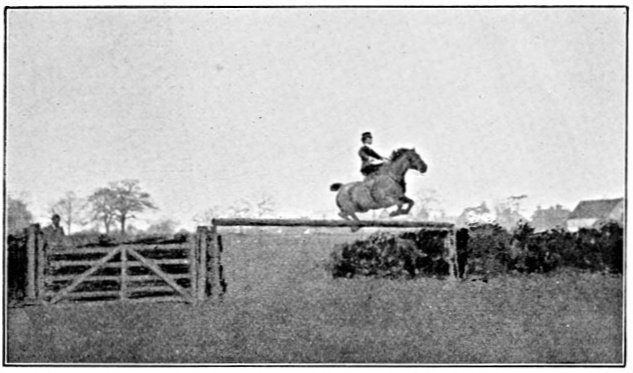
IN THE AIR. NO. 1.
There are certain women who ride hard, for whom this form of the chase has special advantages. For example there is the woman who from whatever cause, whether from the care of a large household, or the pressure of the duties that her literary or artistic, or it may be her political tastes, have involved her in, finds it extremely difficult to take a whole long day for her pleasure in the field, and to such an one the short day with staghounds will be an inestimable boon. Again there are women, whose social or domestic duties keep them in town during the winter months, and to them a run with the[Pg 130] staghounds will be a much-prized form of recreation.
On the other hand it should be remembered that to some women who are more or less of invalids, and who would yet rather not go out at all than leave off before the run is over, the possible long day, and the almost certain fast pace with staghounds, will be against this form of sport. This, like most other matters connected with sport, will depend very much whether the chase of the deer is the sport of the neighbourhood, when hounds will often make long days, or whether, as in some good foxhunting countries, it is more or less subservient to the chase of the fox.
There are others again whose lot is cast in a good stag-hunting country, who honestly find a satisfying enjoyment in riding after the hounds. These will like to make long days, and if they follow the chase to the end, will be not less weary than their foxhunting sisters, by the time they turn their steps homewards.
Let us see how such will fare.
Suppose that a run with Lord Rothschild's splendid pack is in prospect, and that the meet is fixed for twelve o'clock. If time is of moment to you, you may reckon that if you arrive[Pg 131] at the rendezvous three quarters of an hour later, you will find you still have a margin before hounds are laid on. This will give you a comfortable morning's work, before the cart is at the door. For remember, that a pony cart or dog cart, or the more luxurious brougham, is very necessary to the comfort of the hunter of the carted deer. In the first place the long distances covered and the fast pace, make large demands on a woman's powers and those of her horse, and she should, therefore, husband both till the moment of the chase arrives. Equally for both horse and rider too, she should, if possible, make the return journey also in the cart.
That this often will not be practicable, and for the same reason that it is generally useless to have a second horse out stagging, does not in any way detract from the comfort of having the cart at hand if it can be managed. If, however, the deer should run too fast and too far, for his cart to come up to him for many hours after the "take," then—and this will be the most frequent experience of the followers of the chase—the rail may prove the best hack home for both woman and horse.
The former will thus be saved a weary jog[Pg 132] home, and her horse will also be spared what, even if he is a good hack, will be the most difficult part of the day's work to him. And though, of course, an ideal woman's hunter should also be a perfect hack, how few even good horses answer the description. What hunting woman cannot recall some animal, and many it may be, which have served their turn, for which she would not have taken centuries, if offered when he was sailing with magnificent action over a grass country, but which on the journey home at night, she would have been almost inclined to give away to the first comer? But even with a good hack, it is a doubtful pleasure to ride him after he has tired himself in the chase, and you will find it a relief unspeakable to exchange the saddle for the cushions, and to drive or train home, instead of striving to keep your weary hunter on his legs.
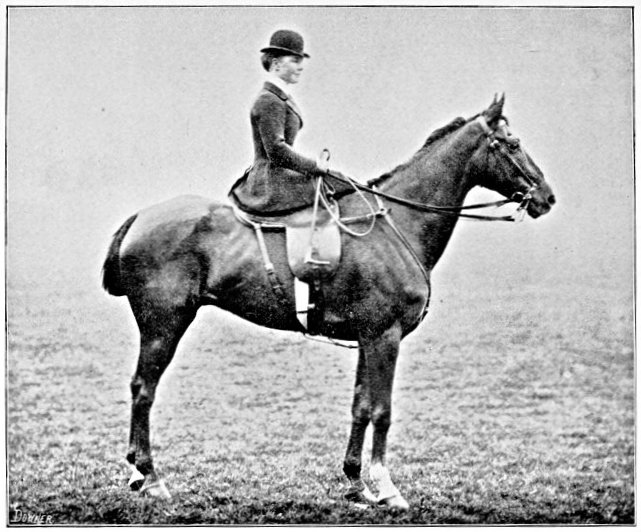
T. Bennett and Sons. Worcester and Malvern
LADY DOROTHY COVENTRY ON SIXPENNY.
But to return to the meet. When you get to
the place of meeting there will be three courses
open to you as a rule. You can either see the
stag un-carted and the hounds laid on, or you can
omit the first ceremony and come on the scene
with the hounds, which in well regulated establishments
will not have been allowed to catch a
[Pg 133]
[Pg 134]
[Pg 135]view of the cart, or you can adopt another
course, and wait till the stag has completed his
first circle, which he is almost sure to run before
leaving. If you incline to the last, and there is
much to be said in its favour, you will look out
for some point, such as the crossing of a road by
the stag, and trotting quietly down to it, you
will wait for the hounds to come up. By the
time they reach you, they will have got over the
first flurry with which staghounds always make
for the line, and will come chiming down as
prettily as a pack of harriers.
[I think the best plan is to come into the field with the hounds, if possible, pick your own place at the first fence—of course riding wide of the hounds—and do your level best to get a good start. If staghounds really run, a good start is every bit as important with them as in the Shires, and that is one reason I think they are such good training for judgment, decision and nerve. She who hesitates is sure to be lost sooner or later, and when you have been out of a good thing two or three times, because you did not push along at first, it does make you keen.—C.F.C.C.]
Then you should ride to the hounds and watch[Pg 136] them working. You will observe that they string more than foxhounds—though they are foxhounds in everything but the use to which they are put—but such packs as Lord Rothschild's or the Queen's, will drive forward on a hot scent and work out a cold one, in a way that will delight any lover of hound work. Now you may, nay you must, ride somewhat closer to the pack than would be quite orthodox with foxhounds, and if there should be anything like a scent you will find that in spite of being a light weight, it may be, and riding one of the best, it will take you all your time to live with them. Nor will you be in any danger of overriding hounds. With a good deer you will find you need all your judgment, horsemanship, coolness and pluck to live to the end.
After you have been going some twenty or twenty-five minutes, perhaps, hounds will run up to their deer. But the sport will not be over. If possible at this point you should notice whether the deer has his mouth open or shut, for this will tell you whether you may still look for a long gallop or not. A deer, be it remembered, closes his mouth when he is beaten, but as long as he has it open, you may be sure he has not the[Pg 137] smallest intention of being captured. You will find that with the consideration for the feelings of the quarry which marks all the proceedings, hounds will not be allowed to go on till ample time has been given for the deer to get a good start. He may not unlikely be encouraged by the friendly crack of a hunting crop by one of the field, but otherwise his Lordship will be left to himself, and the hounds meanwhile will stand with their sterns waving in eager impatience to be off, and their eyes fixed on the face of the huntsman. It was a grand sight to see poor Mark Howcutt at such a moment, in the vale of Aylesbury. The loose thong of his whip, as he sat motionless in front of hounds was enough to keep them in check, and when he quietly gathered the thong up, they knew the moment had come, and casting themselves on the line, they would break into a chorus of rejoicing, and race eagerly away.
It is not till you see the stag soil, that you may begin to take things easily, for this is generally a sign of the beginning of the end. It is, however (and here I recall the words of Whyte Melville), an act of courtesy to those who supply our sport, to stay and see the deer taken before we leave. If you are up at the end of a good gallop over[Pg 138] the Vale, you may be pretty sure you will be able to hold your own wherever fortune may lead you, even if the Quorn hounds should be running their best from the Ashby Pastures, over the Twyford Vale to Burrough Hill, or the Cottesmore lady-pack be racing in front of you from Ranksboro' Gorse to Woodwell Head.
As stag-hunting begins later in the day than the pursuit of the fox, so does it leave off earlier, and the sportswoman who shares in it will generally find herself at home in time to get into a comfortable tea-gown, and give what our neighbours call "five o'clock" to her friends. There will then be the chance of a rest before dinner, and to those who are not over-strong, or who have heavy social duties before them, I would recommend the plan of a well-known rider to hounds in Leicestershire, who goes quietly to bed and gets perhaps a couple of hours sleep before her maid rouses her to dress for dinner. As many women undoubtedly suffer from the strain entailed by the great demands on their strength during the hunting season, the plan may help them to keep both good looks and health, and will thus give them a keener enjoyment in their favourite sport.
And now a word as to equipment, though this[Pg 139] will be brief indeed, as what applies to the follower of the fox applies in almost every particular to her who rides after the stag. I would only suggest in the latter case that the habit worn should be plain, and that the distinctive collar of any Foxhunt of which you may be a member, is not quite in place when you are following another form of sport. As to the vexed question of the tall and the round hat, in the hunting-field, some will declare in favour of comfort as represented by the latter, while others will prefer the undeniable smartness of the ugliest product of modern civilization.
[My advice to everyone is to take a change in a Gladstone, and leave it either at the Inn where the meet is, or better still with the clothing and horse-box, for it is a serious matter to get ducked in a brook and then perhaps have a long train journey home, without the possibility of dry clothes. I say this feelingly, as this year after the Stag in Kent, I fell at a brook about 2.15—my watch stopped, so I know the hour—and after finishing the run, I had to ride seven miles to Paddock Wood, before training home. Of course I ought to have died of pneumonia after this, but happily was none the worse.—C.F.C.C.]
The above note reminds me that if at any time you should get a wetting, such as that described above, and have no welcome change at hand, you will in nine cases out of ten experience no harm, if in train or cart you cover your wet clothing with coat or rug, or even horse-cloth should nothing else be available. Some may think even a probable chill preferable to the last suggestion, but verbum sap.
The canteen for a day with staghounds will not require much thought, for between the late breakfast and early tea, which generally are possible, the demands of appetite will not be great. However, as there will be no second horseman to rely on, the sportswoman will do well to carry with her a few biscuits and a little cold essence of beef, or a slice of plum pudding, and some port wine should she prefer it. (A medical friend says there is nothing like Kola Wine.)
But now, last, though of more importance than all that has gone before, we come to the question of the hunter. To leave out of count for the moment, the points we should insist on for all women's hunters, the first great requisite for a horse that is to follow staghounds, is speed.[Pg 141] For remember that the fastest possible form of the chase, is when a pack of large-sized foxhounds, is in pursuit of a red deer hind, over a grass country. A well-bred horse is essential, and other things being equal, if clean thoroughbred, so much the better.
[From my eleven years' experience of Stag-hunting, I have come to the conclusion that the most essential thing is that a hunter should be well-seasoned. If you ride a young horse with the stag, which would go perfectly well with foxhounds, he will go off his feed and fall all to pieces, even if you are lucky enough not to strain or over-reach him. A horse ought in my opinion to be quite seven years old, to take his turn regularly once a week stagging.
I quite agree with what you say about breeding, but for a woman the ideal horse for staghounds must not only be temperate, but in every way good-mannered. I suppose it is the rush at starting, which of course suggests racing, that excites them, but I know by experience that a horse which is a comfortable mount for a woman with Foxhounds or Harriers, may prove quite unmanageable if taken with Staghounds. A hot horse, too, even if you can ride it, takes so much[Pg 142] out of itself, that it cannot stand the long days, and is sure to knock up. With the packs I know in Surrey and Kent, a good timber jumper is essential, and in Kent you also want a water jumper—a rare combination.—C.F.C.C.]
A good fencer will be the best to carry you in the Vale of Aylesbury or the Ashford Vale; while if you go out with the Queen's, you will need a stouter animal for their Beaconsfield country, and indeed for most of the country of the Royal Hunt. With the Wards in Ireland, you will need the very best class of horse you will ride with the Meath, and in all countries where the chase of the carted deer is pursued, you will, in my opinion, find size and scope important, as a large horse will be going well within himself while a smaller one is at a stretch. As however to every rule there is an exception, so an undoubted authority tells me, that an Arab pony standing only 14·2, was well to the front in a good run after stag one day this season (1897-8), and pounded some gallant Dragoons over a six-barred gate.
Although the fences in most stag-hunting countries are generally of a manageable size, yet as you have to gallop at them, you should have a bold free horse under you. One too which has[Pg 143] his wits about him is perhaps, if that be possible, even more valuable after stag than after fox or hare, the pace necessitating the promptest decision and the greatest possible judgment in making the best of the unexpected, which is sure to happen, even when you think you know every inch of the country.
Stag-hunting then, we have seen, has its advantages, and I am not sure that if your lot is cast in a provincial country where the interest of watching hounds track their fox over flinty hills, from the depths of one thick covert to the recesses of another, is seldom varied by a gallop, you will not do well to take your place, at least occasionally, with the followers of the local staghounds. Of course, I am taking for granted that you are, more or less, interested in the working of hounds; but if you should be one of the hard-riding brigade, who frankly acknowledge they hunt to ride, then I should say that your best place will always be with staghounds, for with them you may reckon on the gallop which with other hounds is, and always must be, a matter of doubt. In most parts of the country you will find some staghounds within reach, at least of the "iron covert hack," and in Ireland the Wards[Pg 144] and the Rosscommon are unrivalled for speed and incident in any land. It is only, though, the youngest, and pluckiest, and best mounted of us who can hope to live over the stiff Irish banks at the pace at which the latter hounds go. A saddening thought, but true, as many a good woman has found to her cost.
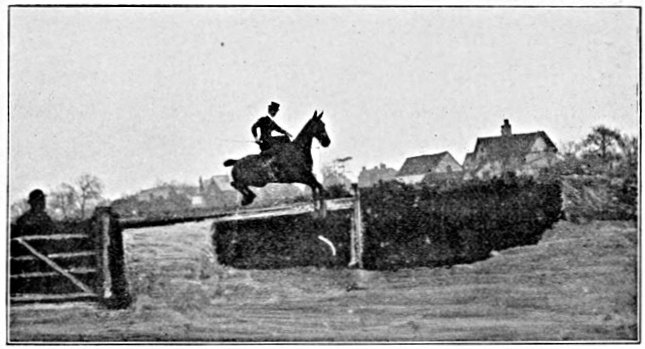
IN THE AIR. NO. 2.
If your hunting lot should be cast within distance of a stag-hound kennel, I would strongly advise you to learn something about the hounds. Your pleasure in the chase will be greater if you can distinguish between the notes of a trusted hound and those of a youngster which has not proved his right to your confidence. My own reception by kindly Fred Cox, when I made my[Pg 145] first visit to Lord Rothschild's celebrated kennels, I have always felt to be a reproach to my fellow-sportswomen on this point. It was during a frost in the early days of 1895, that I determined to ask Cox to show me his beauties on the flags. A telegram brought back a satisfactory reply, and I duly presented myself at Cox's door. Mrs. Cox, however, was doubtful about admitting me, and told me her husband was engaged to show the hounds to a visitor at twelve o'clock.
"But I made an appointment for that hour," was my remark, and the astonishment with which the old lady regarded me I shall never forget.
With uplifted hands she exclaimed, "Well, to be sure ma'am, we thought you was a man!" and it was some little time, I could see, before the old huntsman himself decided that though I had the misfortune to be a woman, I was not altogether ignorant of what a good hound should be.
It will be a good thing when more women who ride to hounds know sufficient of hound work to be able to take an intelligent interest in the performance of the pack in the field, for those who can only enjoy a mad gallop know but little of the inner joys of the hunting field.
Frances E. Slaughter.
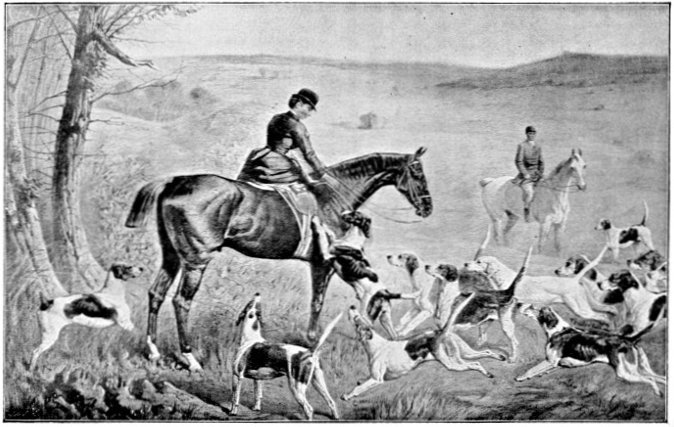
THE LADY THEODORA GUEST ON PEMBROKE.
(With the Blackmore Vale Hounds.)

The great question in buying horses to carry us with hounds is, of course, expense. If our purses are deep and well-lined, then we can ensure being well carried, provided of course we know sufficiently what we want to be able to choose aright. But even with two or three hundred guinea hunters, we may, according to good authority, only hope for the superlatively good one, once in a lifetime. Yet if only once this joy is to be ours it is worth trying for, the nearer perfection is our horse the greater will our pleasure and comfort be in the hunting field.
In saying this I am speaking of the great majority of women, those, who while being good riders and fair judges of what a horse should be, are yet not among the exceptional few who can make any horse go and most go well, and who can, therefore, lay claim to the title of[Pg 150] consummate horsewoman. That the latter is rare, even in these days of hard riding, few will be found to deny, though perhaps many of us have a belief deep down in our minds, to which we would not give utterance for worlds, that we ourselves are above the average in our skill with, and knowledge of, horseflesh.
So those who feel they have nothing to learn will not be likely to trouble themselves with these few words on the choice of hunters, and to the "exceptional few" there is certainly nothing to be said that they do not know far better than one of their less-blessed sisters can tell them. But with these reservations there may still be a goodly proportion of riders to hounds, who will like to consider the subject of what a hunter should and should not be.
With a devout wish then that we could each truly say we find our pleasure in any horse, because even if he is a bad one, the excitement and interest of checking his faults and getting the best out of him, will make up for our loss of pride of place, let us think for a moment of the points essential for the average woman's hunter to possess.
These are, a well-laid shoulder, good carriage of the head and neck, and good manners.
Many other qualities there are which are more or less desirable, but the above are absolutely indispensable to a woman's safety, as well as pleasure in the hunting field, and, from choice, no woman should buy a horse that does not possess them.
A good shoulder, as we all know, means so much to the comfort of every rider, whether man or woman, that too much stress cannot be laid on it. But if desirable for all, to a woman it is the one point, for which, if she have to choose, she will give up all else. Without a shoulder which gives the play necessary for him to recover himself, a horse with the dead weight of a woman on his back, has no chance in the case of a slip-up, or peck, or any of the thousand-and-one trifles that will scarcely receive passing notice, if he does put himself right and go on.
Strange as it may seem, some women who go fairly hard in the wake of hounds, do not realise how all-important a matter this is. They do not, in fact, seem to understand the enormous difference between the dead pressure of our weight on a horse—light in comparison though this be in reality—as we sit with our support entirely on one side, to that of the man, who[Pg 152] though in nine cases out of ten heavier than we are, yet by the even distribution of pressure and the springiness afforded by the double support of the grip of his legs on both sides of the animal, may be described as living weight. The advantage given by a man's seat is, I believe, incalculable, as those of us who have done long distance rides in uncivilised parts of the world, can say from practical experience, yet I would not—even if it were of the smallest use, in the face of popular opinion—advise women to start a crusade against the existing state of things. We have crusades enough in these days, without taking up the war of the saddle, a victory in which might turn out to be a disastrous failure from other points of view.
That the head should be well put on, is again of special importance to a woman, because beside the fact that she has less physical power than a man as a rule, from the nature of her seat she has less control over her horse, one therefore that carries his head badly, may prove beyond her power altogether to control, and will certainly be unpleasant and fatiguing to ride.
From the full clear eye which will look at you with such winning intelligence, you may and[Pg 153] indeed must, if the horse is a stranger to you, make up your mind as to his character. And this is a test that will never fail. I would, therefore, counsel an intending buyer to turn resolutely from any horse that does not satisfy her in this respect, however good his points may otherwise be.
This brings me to the subject of manners, and full as much may be said on this important topic when we discuss the equine species, as when our talk concerns the human race, for is it not true, and equally true, that "manners maketh" both horse and rider what they are. But to confine ourselves to the former for the present, and to see first what he should not be. A horse that is to give you pleasure in the hunting field should not pull, and above all things must not rear, for nothing is so likely to lead to a ghastly accident as this. He must not be a refuser, as here a woman's physical lack of power will be against her. If he fidgets, you will find a long day on his back most fatiguing, and should he be a kicker your enjoyment will be marred. If, indeed, you ride an animal with this fault, and one which at the same time has any turn of speed, you should try to get to the front and stay there,[Pg 154] for so you will have more space and freedom than can otherwise be the case. Wherever you are, remember you cannot be too careful to keep the active heels out of reach of the hounds, and of your companions in the field. It is most desirable that a hunter should be quiet at gates, and here, perhaps, I may be allowed to remark that all women who ride to hounds should be able to open a gate quietly and quickly, so if you are not proficient in this, I should advise a little practice by yourself. In a flying country your horse should be more than ordinarily bold, and as clever as you can get him for a creeping country, for never forget that you cannot drive or squeeze him as a man can. If you are a thorough good horsewoman you may of course use spurs, and thus force him "where he would not," but to raise the whip as you near a fence is to teach your horse to swerve, for he very soon learns to expect and shrink from the blow. Beside all these negative and positive qualities, the perfect hunter must be a perfect hack if possible, and when you have these combined you may congratulate yourself on having the horse of a lifetime.
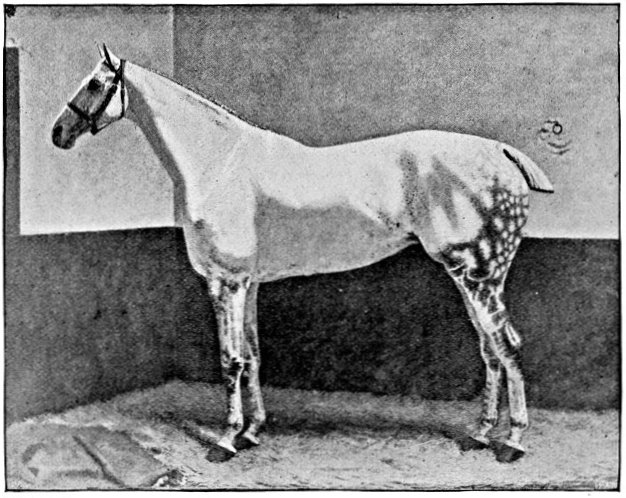
LA CIGALE.
(Property of Mrs. Gordon Canning.)
A horse with the manners I have described
[Pg 155]
[Pg 156]
[Pg 157]will not be young, and I should say, though each
rider will have her own opinion about this, that
a horse is best for a good woman with hounds,
when he is seven off, or even over.
In height he may be about 16 to 16.1, and when buying, remember that there is a certain class of horse which looks much smaller than it really is. This is the animal with a large body on short legs, which has the large bone, the good barrel, and the large knees and feet of one that stands much higher.
Whether you have one of these, or an upstanding creature which looks all, and perhaps, more than he is, let him be as near thoroughbred as you can afford to buy him. I think, myself, as I have said, that old horses are on the whole safer to ride than young ones, though of course if anything does go wrong with them, they have not the power of recovery that a younger one has. A saying of that good judge Whyte Melville is worth remembering. He was speaking of the horses that would be at the end of a long run, and said, "it will always be found that one or more of these is a thoroughbred, an old horse, and under 15.2," and is ridden by a lightweight, he might have added. At any rate our light[Pg 158]weight is one point in our favour, and another is our light-hands. I am firmly of opinion that in the matter of hands we distinctly score in comparison with our husbands and brothers, who in so many ways have the best of it in the saddle. For every man who possesses the coveted "hands," you will find half-a-dozen women who have them. We are too, quicker as a rule, to grasp a situation, or to anticipate an impending fall, and indeed, if we were not, we should rarely have time to free ourselves and get clear of our horse, for unless we are ready when the time comes we have no chance of escape, as those have who can save themselves on either side, when they feel their horses going.
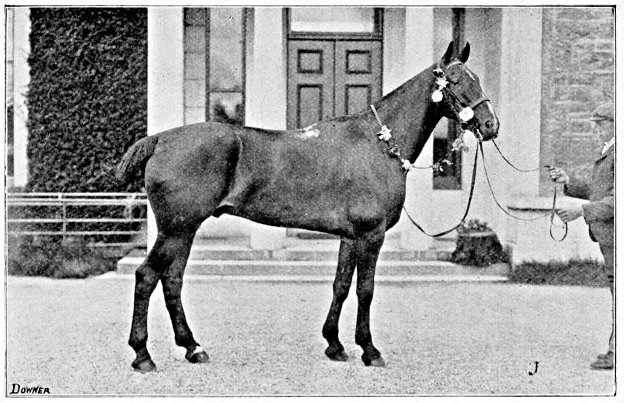
SILVER DOCTOR
(By Death or Glory.)
The property of Mrs. T. E. Harrison. 1st Prize, Dublin Horse Show, 1897, and winner of 15 first prizes in Ireland.
It is difficult to say what price you would have
to give for animals such as these, but any coming
with a good character from a known stable,
would probably cost from £150 to £300, and if
you can afford it the money would be well spent.
With two good all-round horses, such as I have
attempted to describe, a woman would see more
sport than with three or four inferior ones to
carry her. They will come out sooner than less
well-bred ones, and by good management and
having both out with hounds, their owner should
[Pg 159]
[Pg 160]
[Pg 161]be able to get two days a week with them.
Wherever possible I should always advise women
to have out two horses, for this plan not only
economises horse flesh, but is an immense saving
of fatigue to them, as nothing is more tiring than
to ride a weary horse. An intelligent groom
should know how to pick up hounds in the middle
of the day, if they should be anywhere near home,
and though in the case of a great run this would
be out of the question, then the enjoyment of the
long gallop will have to make up to them for the
days when the horse will not be able to come
out.
But inasmuch as many of us know by mournful experience that we cannot afford to buy the best in the way of horse flesh, let us consider what we can forego without risk to life or limb.
1. We may dispense with size, because if a light weight, we can ride horses that would not carry the average man. This at once lessens the price, as the demand is of course much smaller, and for £60 or £80, or even less, you might meet with a serviceable and pleasant mount. Of course to the few women who weigh as much or more than a man this cannot apply, and indeed, for such I may say frankly that I know of no way[Pg 162] in which they can mount themselves with safety, except by buying the best horses that money can procure.
2. The second way in which, if we must cut down our prices, we can do so fairly safely, is in having less of strength behind the saddle. Not that I would advise a horse with weak quarters under any circumstances, but while the qualifications in front of the saddle of which I have spoken are indispensable, I believe, if we do not ride over eleven stone, we may make some sacrifice in the matter of power behind the saddle. Those horses which are too light behind to carry heavy weights with safety are often very pleasant to ride, and we may meet with them at a very reasonable price.
3. Again, if we wish to keep within a moderate
figure in the purchase of our hunters, we need
not reject those that are undeniably slack in the
couplings and have short back ribs, and consequently
give the impression of being very long
in the back, always of course supposing that they
are suitable in other respects. Such horses are
often pleasant enough to ride, and as they could
in no case be suitable for a heavy weight, they
should never be high priced. The great draw[Pg 163]
[Pg 164]
[Pg 165]back
to having such, of course, is that they will
not come out so often, or stand so long a day as
a truer shaped horse will.
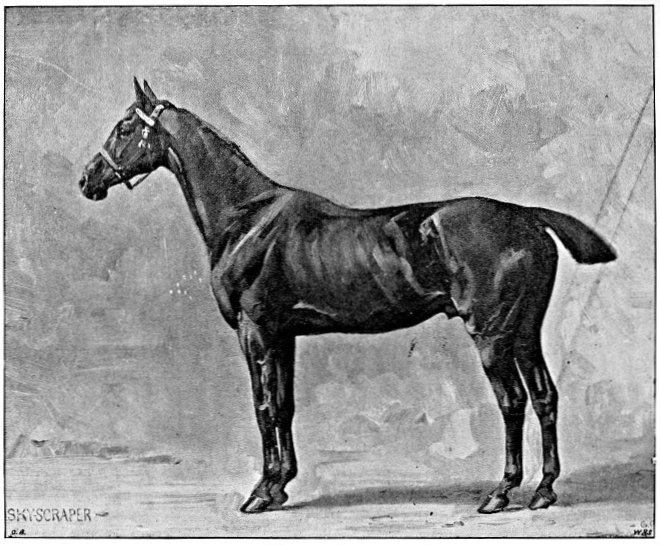
SKYSCRAPER.
(Grandson of Hermit In Alarm. Property of Lady Gerard.)
A counsel of perfection is to have a saddle for every horse in your stable. This is so important that though it involves a considerable outlay with every change in your horses, it will be found a real economy in the end. When your saddles are overhauled, as they should be at the beginning of the hunting season, every horse should have a saddle fitted to it, and thus, and thus only, will you—provided of course your stable management is what it should be—escape the sore backs which will entail loss of sport in a way that is peculiarly aggravating, when you know it might have been avoided.
As important and yet within the reach of everyone is for every horse to have its own bridle. Never allow any departure from this rule, and see yourself that the head piece of each horse fits easily and that the throat lash is loose, also (and this is a point on which few grooms are to be trusted) that the bit has been properly fitted to rest on the right part of the mouth. This is of no slight importance, for a badly fitting bridle will spoil the manners of the very best of horses.
I should advise a woman always to ride with a double bridle, for with a snaffle her strength, as a rule, will not be sufficient to hold the horse together when he is tired. With light-mouthed horses, either a leather curb or a curb chain sewn in leather will be found the best. A good hint given by an experienced horseman is to drop the snaffle and ride lightly on the curb when going home after a long day, as this by relieving the horse will be less tiring to his rider. Another thing to remember is, that while in the morning when hacking to the meet you will naturally choose the soft sidings of the roads, on returning at night you should keep your horse on the crown of the road, as this will be easier going for him and he will be less liable to stumble.
As samples of high-class hunters that have been ridden well up to hounds in different countries, I would point to the horses reproduced in these pages, and the choice between the speedy thoroughbred and the clever Irish or provincial horse, must be dictated by the form of the chase and the country over which he is to carry you, and by the depth of purse to be reckoned with in the purchase.
Frances E. Slaughter.
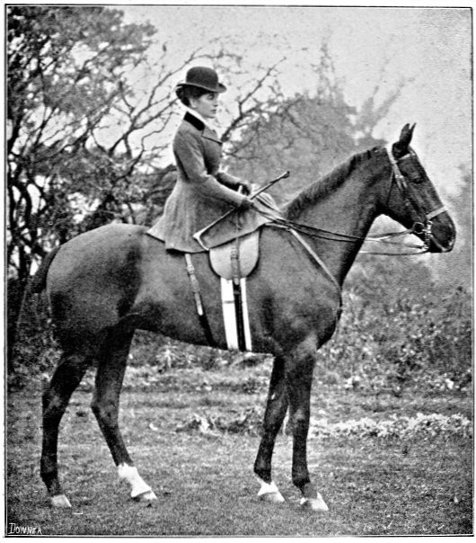
Elliott and Fry. 55, Baker Street.
MRS. WRANGHAM ON THE DUDE.
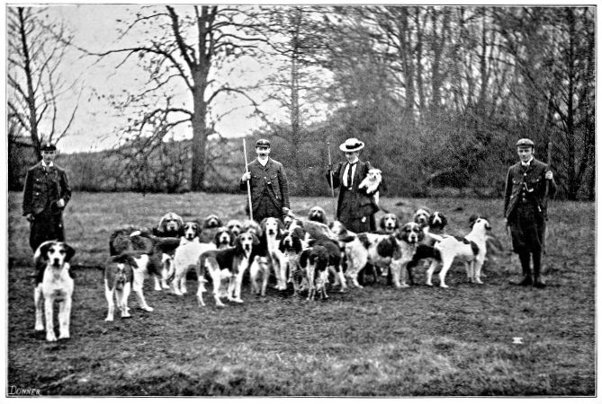
Elliott and Fry. 55, Baker Street.
MR. AND MRS. WARDELL.
(With the Hawkstone-Otter Hounds.)

Possibly no form of sport has grown into favour more than Otter-hunting of late years. Fresh hunts are continually springing into existence, and there are now in the United Kingdom some eighteen recognised packs of Otterhounds. In speaking of a pack of "Otterhounds" one does not necessarily imply that the pack are Otterhounds by breed, as Foxhounds, both Welsh and English, are frequently pressed into the service of Hunting the Otter, most, if not all packs of Otterhounds having some Foxhounds among them. Besides these, many half-bred hounds are used, that is a cross between Otterhound and Foxhound.
In fact for all round work the latter are often preferred, as the cross-bred hounds possess the[Pg 172] stamina, constitution, high courage and dash of the Foxhound, together with the deep, musical note, heavy coat, and grand appearance of the Otterhound.
Some packs of Otterhounds indeed are composed entirely of Foxhounds entered to otters, and so keen do hounds get on the scent of the Otter, that Foxhounds will become perfectly steady from hunting a fox, though they may have run two or three seasons with a pack of foxhounds, as soon as they have become accustomed to hunting their new quarry, and are fairly entered to the Otter.
The true Otterhound is a large upstanding hound with hard shaggy coat, long ears with the "roll" in them similar to that of the Bloodhound. In colour, more of them are whole-coloured than Foxhounds, the commonest colour being black with tan points, though they are also sometimes red, and black and white. The Otterhound has a beautiful, deep melodious note, which he uses freely when hunting, in fact one of his faults is that he is apt to throw his tongue sometimes too freely and to be "noisy."
For real sport, as a general rule, a mixed pack is to be preferred i.e., one composed of Otter[Pg 173]hounds, half-bred Hounds, and Foxhounds. They must be in the best condition, have good sound, hard feet to stand a long tramp along the road to the meet, perhaps several hours swimming in very cold water, and then the long walk—sometimes fifteen or twenty miles—back to their kennels at night.
The management of the Hounds in kennel is exactly like that of Foxhounds. They should be regularly fed and exercised in exactly the same manner as Foxhounds, the only difference being that they can be kept "bigger" in condition, as Otterhounds do not have to go fast, but have often long, slow, tiring hunts, and have to stand long exposure to cold water. In addition to the hounds themselves, good terriers are indispensable. These must be of good constitution, with good feet and legs to stand the long journeys on the road, and as hard as nails in every respect.
Otter-hunting is a sport that is followed on foot and is therefore one that any woman, rich or poor, possessed of a good pair of legs and a thick pair of boots, can join in whenever the meet is within reach.
Most packs have given up hunting at break of day, and meet at the more reasonable hour of[Pg 174] nine or ten. Having arrived at the meet, and after a few minutes' law has been given for late comers, the hounds will be put on to the river, and the business of the day will begin. The Huntsman will always, if he knows his business, have some hounds on each side of the river, so that not a holt or inch of the water may be missed.
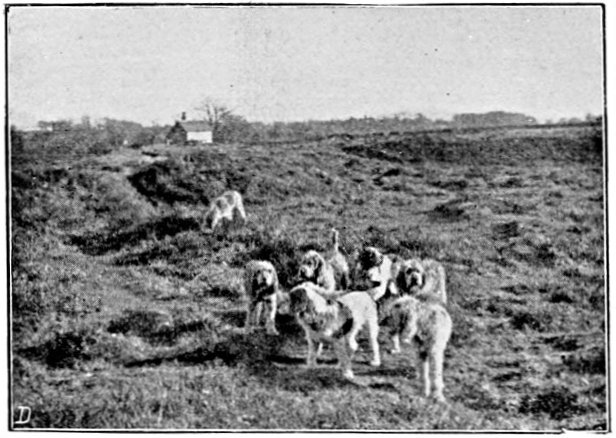
GROUP OF OTTER HOUNDS.
We will suppose that the river is being drawn up stream, for most huntsmen, for various reasons too lengthy to go into here, prefer to draw up stream. Perhaps several miles are traversed and no sign of an otter. Suddenly one of the old hounds is seen to hang and lash his stern at a bend of the river, the rest of the pack[Pg 175] eagerly rush to him, and soon are busy trying every stick and stone and tuft of grass an otter may have touched during his nightly wanderings, and though they cannot quite speak to it, there are unmistakeable signs that an otter has been on the river. The whole pack know it too, and become doubly keen and swim backwards and forwards across the river eagerly examining with their trusty noses, every stone, island, or bit of shingle where an otter may have touched. Every now and again they come to some spit or bend in the river where he has touched, and then they can just "feather" to it, and one old hound actually speaks, but it is only a stale line and the rest of the pack can but just own it. A mile higher up we come to a spot where a small brook joins the river we are drawing, and in a moment a change comes over the scene. Across a bend at the mouth of the brook every hound dashes forward on a hot drag, a cheer from the Master—who is his own huntsman—a touch on his horn, and away the whole pack of eighteen couples dart up the rocky dingle, and with a musical chorus make the wooded valley ring again.
Here is a burning scent, and the ground being[Pg 176] rough they get clean away from the most of the field for nearly two miles, but at length they check on an old weiring made of wattle work and covered with big stones. One by one the old hounds leave this, and with a satisfied shake plainly say they know their otter is not there. No doubt a place where he has been lying the day before, but now he has moved on to fresh quarters. The master makes a dash up stream to make quite sure his otter is not above him, then a return is made to the main river, by the nearest route. And now as we are quite sure the otter is not below us we have every hope of a find. We soon strike the drag again, but here there is more water, and consequently it is only across certain bends or spots where the otter has landed, that hounds can speak to his line.
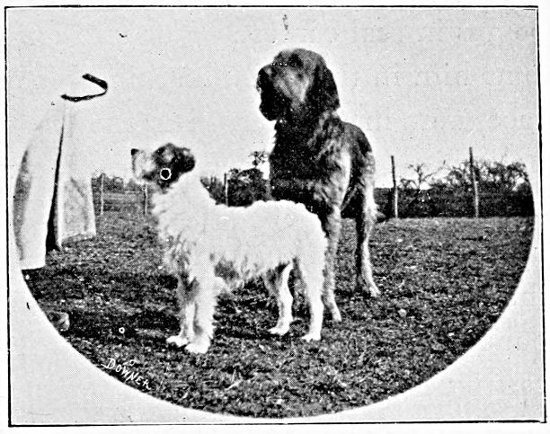
OTTER HOUND AND TERRIER
For nearly three miles they pick out his line up stream, trying every hole and corner and tree stump where an otter might possibly lie, till at length we come to a long deep pool half-a-mile in length, and shaded by many overhanging trees. At the head of this is an old ash tree, with roots spreading down to the water's edge. Hounds seem to wind it before they get within twenty yards of the spot, and with a dash and cry they[Pg 177] rush at it, and begin baying and tearing the roots with tooth and claw. Excitement is now at its height. "Look out below!" shouts the master, and the first and second whippers-in make their best pace to the fords above and below, accompanied by willing members of the hunt, all anxious to help in the day's sport, whilst others put themselves in likely spots to get a view if the otter should but show his nose above water, or betray his whereabouts by the long line of bubbles called "his chains." The hounds dart a little way down stream to make sure that our quarry has not slipped away from the belt, but they can make nothing of it and seem loath to[Pg 178] leave the old ash tree, most of the old hounds persisting in returning to it. At last, after some difficulty, an entrance is made for one of the terriers, and after a short scuffle inside, a line of silvery bubbles darts out from the belt. Another minute and a ringing "Tally-ho" comes from down stream, and away swim the hounds, every one in the pack speaking to him. Now the hunt begins in real earnest. For two long hours they hunt him in this pool, marking him first in one place, now in another, then they swim him from one end to the other, and once he narrowly escapes meeting his doom on the bank. Suddenly he disappears, and nothing can be made of him for some twenty minutes, till at last one of the old hounds hits him off below the lower ford. He has slipped by, unseen in the muddy water and after going about a hundred yards or so down stream, has taken to the land, through a thick covert overhanging the river on the steep hillside. Every hound is now throwing his tongue wildly on the line and making the woodland fairly rattle again with their music, they are close behind him, after a couple of rings round the big wood, and it seems as if he would never reach the river, but the briars are very thick and[Pg 179] the hounds have difficulty in getting through, and he just manages to reach the water as one hound makes a grab at him. Hounds, otter and one of the field all come tumbling down into the water together. We are now in a deep pool half-a-mile lower down the river, but there is little or no cover here and he gets no rest. There is a capital scent on the water too, and hounds never give him a moment's peace. He is constantly viewed and is getting dead beat. At last he makes an attempt to get over the lower ford. But the hounds are too close to him, and with a dash they are on him. Woo-whoop, and another dog-otter is added to the tale of the slain after a capital hunt of three-hours-and-a-half. With considerable difficulty he is taken from the hounds, his head, tail, and pads are distributed to the field and the hounds receive their well-earned blood.
To those women who can enjoy healthy exercise, good sport, and can appreciate beautiful hound-work amidst lovely surroundings, and at a time of year when they can get no other kind of hunting, my advice is "come otter hunting." Having once come out, you will assuredly want to come again.
The season for otter hunting commences as soon as the water is warm enough, that is in March or April, and goes on till about the end of September. Of course May, June, July and August are the best months, as to hunt big rivers they must be low and the weather warm, to enable hounds and men to stand many hours of water work.
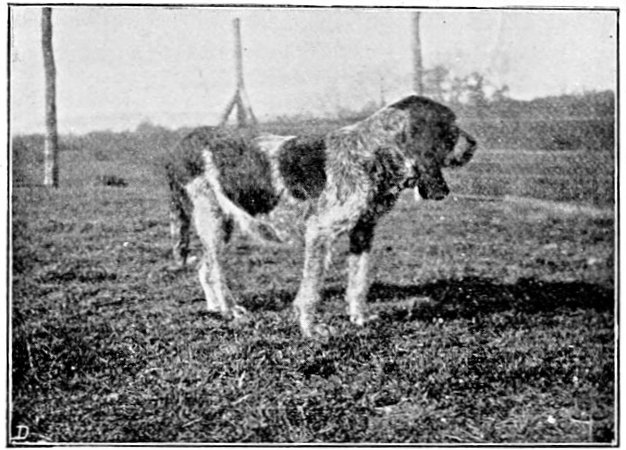
END OF THE SEASON.
(Looking back.)
The late Lord Hill hunted an otter for ten hours and eventually killed it. Hunts of five to seven hours are of frequent occurrence, and often end in the otter being left master of the situation.
One word of advice to those ladies who may be going out for the first time. Do not in your eagerness crowd on the hounds or get in front[Pg 181] of them when drawing. Do not walk down the river the hounds are going to draw, to find them, instead of coming to the meet. Do not, when an otter is found, rush wildly about, up and down the bank in front of hounds swimming their otter, in hope of seeing him. If you do, you will be doing harm and spoiling the sport of others as well as your own.
Remember that thick boots and a short skirt are necessaries, if you wish to enjoy your day with otter hounds.
L. Wardell.
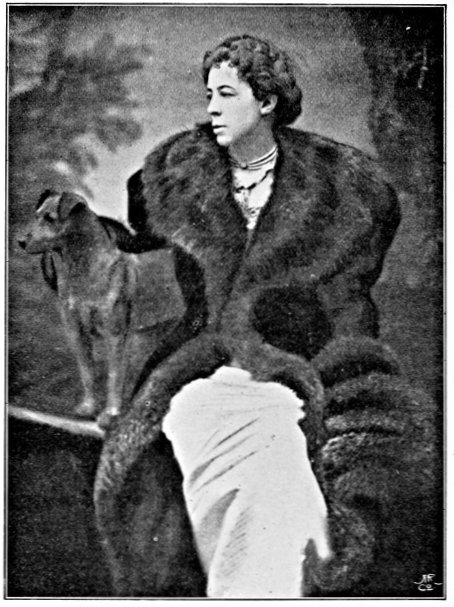
Alice Hughes. 52, Gower Street.
SUSAN, COUNTESS OF MALMESBURY.

La Fontaine's lines, to which I have appended a somewhat free translation, could certainly not be applied to the modern representative of the species, whose extensive educational privileges on the subject of bait and flies have formed his mind, brought his acquirements thoroughly up to date, and elevated him from an innocent unresisting victim into an adversary whose cunning not unfrequently out-matches our own, but of whom the true fisherman should scorn to take an unfair advantage.
This being a sport in which delicacy of hand is more necessary than mere brute strength, it is especially adapted to women who love fresh air and beautiful scenery, and who are willing to bide the good time at which the fish feel disposed to rise.
I should perhaps say here that my remarks are intended to apply to salmon and trout fishing in rivers and lakes, taking incidentally such "coarse fish," pike, perch, etc., as are to be found by the way.
Of all fish the salmon stands pre-eminent for his sporting qualities, and next to him in order come trout of all kinds.
Salmon are a curious and interesting race, whose habits have been an object of study to the naturalist for many years past. They are born in the shallow reaches of rivers, the eggs taking from eighty to over a hundred days to hatch, the exact length of incubation being determined by the temperature of the water, and they sometimes remain in or near their original quarters till they are from one to three years old, when they migrate to the sea. By far the greater number, however, descend to the sea within twelve to fifteen months after they are hatched out from the ova. Up to this crisis in their history they[Pg 187] are called parr, and seldom exceed some three ounces in weight. As the period of migration approaches—usually in the spring, though autumn migrations also occur—the samlets increase in size; silvery scales replace their barred markings, and they are known as smolts. Both parr and smolts feed greedily in the rivers, but it is a curious fact that subsequent to their first visit to the sea none of the salmon tribe appear to feed in fresh water, the stomach almost invariably being empty when examined. They remain in the sea for an uncertain period which may vary from three or four months to as much as two years, and during this time must certainly feed with voracity, as they increase many pounds in weight. On their first return to fresh water as grilse they weigh from two to eight pounds.
I have myself seen, in the Killery Bay, a shoal of salmon making for the mouth of the Erriff river. They were apparently led by a large fish, which from time to time sprang out of the water, I suppose to reconnoitre the neighbourhood. The fisherman used to look out for this leading fish, and run a net round the shoal. Salmon certainly do not live in company in the rivers, whatever they may do in the sea. They start on the journey[Pg 188] up stream in shoals, but soon separate to take up their quarters in the different pools through which they pass. They are now promoted to the name of grilse, and attain the rank of salmon on their second and all subsequent migrations. Their arrival in fresh water is partly determined by conditions of weather and water; also by the special circumstances of the river to which they belong, i.e., whether it be early or late. The fish come up in prime condition, for the purpose of spawning, and return eventually emaciated and most unattractive-looking, after this has been accomplished. In the first state they are called "clean" or "fresh-run" fish, and are a bright silvery colour; in the second they are termed "kelts," become reddish or dark in colour, and from being thick and cobby in shape appear long and eel-like, the males having developed strange crooked snouts which vanish in quite a miraculous way when they return to the sea. There is no sign of this odd proboscis when they first enter the river, so that it comes and goes, leaving no token of its presence behind.[4]
Salmon are now unfit for the table, and must be returned to the water uninjured, when they are caught. I might here say, as I am regarding the salmon from a culinary point of view, that it greatly enhances the flavour and firmness of a clean fish, if he is "crimped" at once on being landed. He should first be killed by a blow on the head, and then cut into slices about an inch thick; taking out the joints of the backbone and running a stout piece of cord through the hole thus made. These slices may then be put into the river where the current is not too strong, the string being secured to the bank by a stout peg, and they should remain in the water for several hours until the flesh "rises," as it is called, to the "crimp."
My appetite for crimped salmon received, however, on one occasion a severe shock. I caught a beautiful fish weighing about eight or ten pounds, in the Hampshire Stour. The keeper proceeded first to kill him, and then began the crimping process. He advanced as far as the shoulder, at which moment I told him to stop, saying he might have the rest for himself. Thanking me, he laid his portion on the ground and we went further down the river. In [Pg 190]half-an-hour we returned, and a friend who was with me and who had studied medicine, took up the head and shoulders of the fish and showed it me. To my horror, the heart, which was plainly visible and untouched by the cut of the knife, was still beating strongly. My companion assured me it was merely muscular action, but it was a ghastly sight, and for a long time I could not face crimped salmon again.
The instinct of the fish urges them to run up the river as high as possible, sometimes at a tremendous pace, and to make violent efforts to leap all obstacles in their way.
When in this state of mind they very frequently turn into small tributary streams, which, being flooded, allow them to pass up, but where they are sometimes found almost high and dry and unable to return, like a stranded whale of small proportions.
Sea trout also belong to the migratory species, and of them it may be said, shortly, that they are, in appearance much like miniature salmon, and have game and fighting qualities of very high order.
I may perhaps be allowed to say here that I have found mackerel, caught in the sea with a[Pg 191] light trolling rod and trout tackle, give a great deal of sport. They are particularly muscular little fish, and the curl of their lithe tapering bodies, and forked tails, seems to give them a hold on the water which is out of all proportion to their actual size. When caught, after they have been killed, the large vein in the throat or gills should be torn. They bleed to quite an extraordinary extent, but are much better eating and less oily when they have been treated thus.
Bull-trout are something between the salmon and the sea-trout, and are also migratory fish of much the same habits and characteristics. They are very common in some rivers, less so in others, but I remember seeing one caught in Dhulough, County Mayo. There were also in this same place numbers of sea-trout which rose to the fly or came at a minnow, but as far as we could learn there was no egress from the lake by which these fish could get into the sea. They must, however, have had some means of descent.
The Salmo Ferox, or Great Lake Trout grows to an enormous size, weighing as much as thirty pounds. They give quite as good sport as a salmon, and many of them were caught some years ago in Loch Arkaig. The method of fishing[Pg 192] was to troll for them in a boat, either with a fly or with a small gudgeon or minnow, but always with pretty fine tackle, heavily shotted so as to sink to a considerable depth. I hear that none have been taken in this way for a very long time in that water.
There only remains to be mentioned the ordinary brown trout of our streams and rivers, so common and so delicious when in good condition, but by far the most wary and difficult to catch of all his tribe.
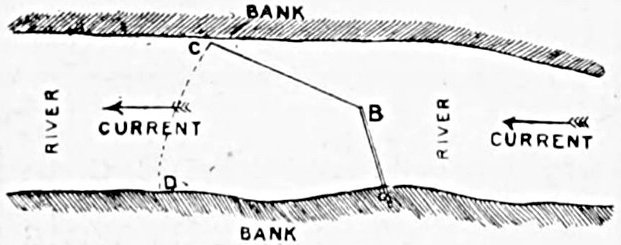
The Cast for Salmon.
One of the greatest initial mistakes made by the novice in salmon-fishing is to continue flogging the water for hours together, without intermission, and regardless of the state of the sky or water. It is very difficult to give general directions as to the latter, for circumstances vary in different rivers, and experience only can enable the angler to judge when the right moment has come, but in floods or in rising water no fish will, as a rule, pay the slightest attention to the fly. As to the weather, a fresh breeze which ripples the current of the river or the surface of[Pg 193] the lake is always a point in the angler's favour, and the sky should be overcast. A bright sun is generally fatal to any chance of sport, but there are of course exceptions to this rule. The largest salmon I ever caught, and which weighed thirty-two pounds, rose to a fly just before sunset, after a cloudless day, during which he had remained at rest close under the bank, holding a levée of numerous visitors who came to admire his fair proportions as he lay motionless and, apparently, without fear, within a foot of the surface of the water.
I have seen fish rise as if they were mad, in a gale, with pelting rain and flashes of lightning. In weather like this, my father caught in one day some years ago, thirteen salmon and one hundred-and-seventy sea trout to his own rod in the Erriff. It was a sort of convulsion of nature and the fish seemed to look upon it as an opportunity for a Saturnalia.
In all rivers and lakes with which I am acquainted I have found that the Salmon rise at certain fixed hours morning and evening, and sometimes also in the middle of the day. As salmon do not rise from hunger, as far as we know, it is difficult to understand why this[Pg 194] should be. I leave the explanation to others and merely state the fact as I have found it. In that part of the Hampshire Stour with which I am best acquainted, the hours for rising were five in the morning, one p.m., and sunset. At one p.m. the fish were so regular in their habits that the servants' dinner-bell, which rang at that hour and was audible for some miles round, came to be called the Salmon bell.
In Dhulough, Delphi, and Glendalough lakes, in County Mayo, the fish were lotus-eaters, and preferred the afternoon for intercourse with the human race.
In Pool Persyn, on the Usk, near Brecon, they never rose, as far as we could find out, before twelve o'clock, or between two and four, when I presume they had their siesta. No doubt a great deal depends on the time of year and the amount of daylight. These peculiarities in a river can only be ascertained by experience, or by consultation with someone who knows the water, and should never be disregarded, as for all we know to the contrary, fish may get used to the sight of a fly which is constantly being dangled before their nose, and end by paying no attention to it.
Another very important matter is to make[Pg 195] oneself acquainted with the haunts of the fish, the spots where they lie and rest on their way up the river—I do not say "down" as well, because they must not then be caught at all, owing to their condition.
In fine weather, therefore, when the sun is bright and the water low, the wise fisherwoman will leave her rod at home and walk along the bank, slowly and carefully examining the bed of the river and ascertaining, as far as she can, where the fish are lying and where the rocks and roots of trees, or "snags," as they are called, are situated. This knowledge will assist her to cast her fly in the right and not in the wrong place, and may avoid the loss of a fish which would otherwise either accidentally or of malice prepense entangle the line and snap it by means of a resistance which he cannot get from a lissom rod and a running line.
This is such a favourite trick with pike that it amounts to a recognised dodge, and would almost seem to be the result of some form of reasoning, however dim.
To flog the river for hours at a stretch, without having first ascertained these simple facts, at a wrong time of day, or when, for instance, the water is rising, is worse than useless,[Pg 196] for it disgusts the angler, and renders her incapable, from sheer fatigue, of throwing a light fly when at last there is really a chance of a prize. Casting, let us say, from forty to sixty feet of line with a heavy rod is hard work for any woman; indeed, most men return from their first day's sport with a stiffness in the muscles of the back and shoulders which it takes a vast amount of "Elliman" to alleviate.
It is most important for a woman, in fishing for salmon, to husband her strength, otherwise, if she hooks a heavy fish and is already tired out, she may find it a difficult matter to play it safely, and to land it eventually, after perhaps following and keeping strain on him for some distance over unequal ground.
Thick waterproof boots, made high in the legs, gaiters if required, a short skirt, a blouse or tennis flannel, strong belt of leather or webbing and loose jacket, with a small hat well fixed on head, is the most suitable costume to go out fishing in. I take for granted that most women will not care to wade, a practice which is dangerous to health and sometimes to life itself, even when waders are used, as few women so hampered could regain their footing in a strong[Pg 197] current once they had lost it, or if they accidentally stepped into a hole.
Quiet colours, heather mixture and the like, should be worn, as fish, and more especially trout, have a quick eye for a bright patch. White objects are to be avoided. It is a well-known trick with poachers to send a large piece of white paper floating down stream. Not a fish will rise for hours afterwards. It seems to affect them as flying a kite does partridges—they lie close and can be netted afterwards with ease.
Salmon are distinctly less clever than trout, and the same precautions against being seen are not so necessary, although always advisable even in the case of the former, which will also be attracted by a much coarser form of lure. No doubt the reason is partly that we fish for salmon and its varieties—the sea and bull-trout—in deeper water of which the surface, being broken by the current, is roughened and intercepts their view of the upper world. In trout streams this is not nearly so much the case, as a rule, and where the banks rise high above the water, trout require the greatest care, coaxing and delicacy in handling to induce them to exchange a comfortable home for the angler's creel.
When salmon are rising, they will take almost anything, and in thick or heavy water I have caught them myself with the identical spoon-bait which I used for mackerel in the sea.
It is difficult to fathom what is in the salmon's mind when he takes either a spoon or a boiled prawn, objects which he can never have met with in the sea in his natural state, but many fish will come at the fly merely to drown it by striking at it with their tail, and are ingloriously "foul-hooked" in consequence. When this happens they are far more difficult to kill, and often lead their captor a pretty dance before being finally gaffed or netted, the tail fin not being so sensitive as the mouth, which the fish can therefore close, thus swallowing no water when the strain begins to be severe.[5]
Before starting for a day's fishing it is necessary thoroughly to examine the rod and tackle which are to be used. I recommend from personal experience, for a woman, a light, well-balanced rod about sixteen or seventeen feet in length. Greenheart is a very good wood,[6] and mine, which is [Pg 199]made of this, has lasted for years and is, apparently, none the worse. All depends on the care which is taken of it during the time it is not being used. I have always kept my rod in a moderately warm place, where neither the damp could get at, to warp and swell the wood, nor too great dryness make it brittle, and before beginning the season I varnish it carefully to preserve it from wet. Spare tops should be always kept ready in case of an emergency, but the accomplished sportswoman will of course learn how to splice a broken joint, as accidents do not always occur within reach of assistance. Each joint, unless made with screw fastenings, is provided with brass eyes; a piece of waxed thread should be fixed to these so that, being wound round an eye in each joint, the whole rod can be securely put together.
Having omitted this precaution on one occasion when I was fishing for pike, I cast into the river, with my bait, the top joint of my trolling rod, which floated in the water, but did not, strange to say, prevent my hooking and landing a fish of seven or eight pounds.
Examine the reel carefully; take it to pieces, oil it, if necessary, and work the handle to see[Pg 200] that it runs smoothly without a hitch before winding on the line. Large heavy reels and coarse tackle are, to my mind, very inartistic and unsuitable for women, as they naturally lessen the chance of hooking a fish, although, once hooked, all the angler has to do is to hold on, "show the butt" persistently, keep the point of the rod well up and tire out the fish by main force.
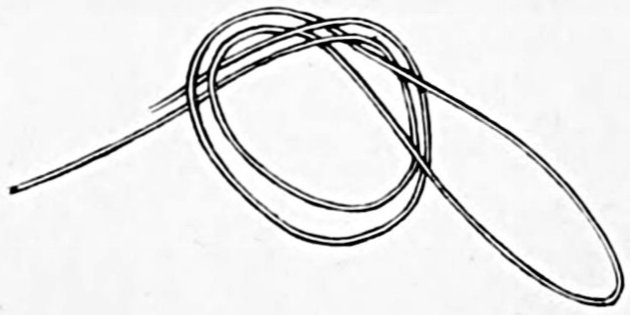
Knot for Gut Loop.
This manner of proceeding has always seemed to me to be taking an unfair advantage of a salmon or trout. With a pike, of course, the question is a different one, as he cuts the line with his teeth, if you give him the chance and nothing but gimp is of any service. The rings through which the line runs should also be examined to see that they are secure and that the line itself, which is best of hemp for salmon-fishing is free from kinks and not chafed anywhere, also that it is wound evenly on the reel, from which it must run lightly and easily.
A check in the running of the line, when a[Pg 201] large fish makes a sudden dash, would almost certainly enable him to break away. Many people waterproof or varnish the line to keep it from rotting, and its usual length is from sixty to seventy yards, the gut cast at the end being generally about three more and stained (according to the colour of the water in which it is to be used) either with tea or coffee, or else ink and water.
One very important point is to wet both line and cast thoroughly before using; the former should be run through the rings in the rod, and casts made on a lawn or other open space for practice and to remove kinks if any. Lines must be thoroughly dried after use.

Ordinary method of tying Gut.
Most women buy their tackle ready made, or are accompanied by an expert fisherman, but, if breakage in the cast takes place and no help be at hand, they should know how to make a single and double slip-knot, and how to put on fresh flies in case of need. It should always be remembered that the two ends of gut about to be joined should be thoroughly moistened before they are manipulated. Otherwise the knots will not bind and the gut will break.
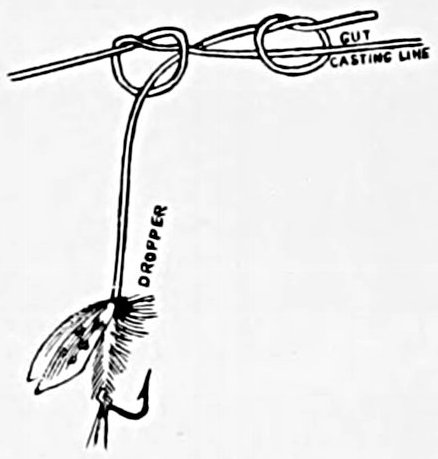
Method of fastening Dropper to Cast.
It is better for a woman, if not an expert, to keep to one fly, that at the end of the cast, called the tail fly, unless she is fishing for sea-trout in which case a smaller one, called the dropper, may be employed a little higher up the cast, or it may be advisable to use two different kinds of salmon flies, but they are apt to get entangled and give a great deal of trouble, without any conspicuous advantage. This is particularly the case where casting is interfered with by high rocks, or trees and branches just behind the fisherman.
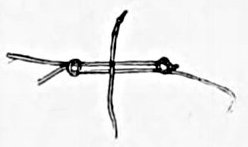
Dropper and Cast.
The length of my own favourite salmon and trout rods are seventeen and eleven feet respectively, but many people recommend a length of not over fourteen for the former, as a woman's strength is so much less than a man's.
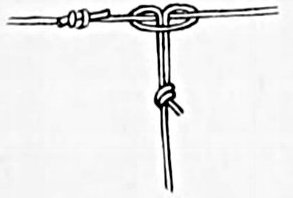
Dropper and Cast.
My own experience is, that in casting against a strong wind, a stiffish rod of eighteen feet is quite within my powers, so much depending on the balance of the[Pg 203] whole apparatus, the size of the reel and weight of the butt. In quiet weather my "Castle Connell," a foot less in length and much more supple was very satisfactory.
Marvellous tales are told of long casts, but personally I have found sixty feet or thereabouts to be the length of my tether, at least so far as a satisfactory performance is concerned. This distance is usually quite enough for all practical purposes, and it will be some time before the angler can be certain of dropping his fly lightly and surely on a given spot, even at forty feet.
Women should practise casting on lawns without a cast at the end of their lines, as, when the fly is on, a novice has been known to hook swallows and even inquisitive puppy-dogs. The "Spey" cast should be studied as well as the ordinary method, the former being most useful where there are high branches or rocks just behind the place where the angler must stand.
The "Spey" cast consists in so switching the line that it shoots out direct to the required spot without ever passing behind the angler's head, while in the more ordinary method, the great secret is to send the line right out at the back, and then with a dexterous turn of the wrist to[Pg 204] bring it forward. By raising the tip of the rod slightly just before the fly touches the water, it will fall into its position in a light and natural manner. Casting requires great care and patience in practising, and many a time the beginner may find her flies firmly embedded in her own back hair, instead of speeding swiftly through the air to where the fish lies.
In casting a line either for salmon or trout it should be noted that fish always lie with their heads up-stream, and that it is therefore necessary to stand some distance above where they are supposed to be, and cast across the water so that the fly may fall delicately and gently, without the least splash, a little above their noses. It cannot be too often repeated that, in fishing for trout, the great art is not to be seen. The angler must therefore stand well back from the bank, hide behind trees and bushes and crouch in hollows. Above all, it is absolutely essential that the figure should never be seen against the sky. She must keep her face to the sun, that her shadow may not fall on the water, throwing her fly first of all under the near bank and then by successive casts across the stream.
The salmon cast is naturally a longer and[Pg 205] slower movement than that which is used for trout, but in both instances it is often well to allow the fly to sink a little before beginning to play it. For salmon the line should be drawn gently and with successive movements of the wrist up-stream and across the space which intervenes between the spot where the fly has fallen and that at which the angler stands. The trout cast is much more rapid, and the playing should be across and down stream as well as up, the movements of the wrist being much lighter and more varied. In both cases, when a fish is felt, a "strike" should be made, at least, authorities, to whom I am bound to bow, insist on this ceremony. Personally I believe that the fish, by this sharp turn of the wrist, is as often lost as hooked, unless care be taken to chose the actual moment when he has closed his jaws upon it. I have seen a fly pulled right out of a salmon's mouth, and have been told by those looking on and instructing me that I had done that same thing myself, when I merely intended to strike. My impression is, therefore, that the novice had better let her salmon hook themselves, which they will certainly do if they come well at the fly.
The cast itself requires careful examination before it is used; it should be stained to the required colour and tested with a steelyard up to sixteen or seventeen pounds for finer tackle, and eighteen for that which is coarser. Trout-casts, will not, of course, require or bear so severe a strain, but should be tried to see whether there is any defect either in the gut or in the knots which unite the several lengths of which they consist.
Few women, I imagine, will care to make their own casts, although some do, and for those I may mention that the best and cheapest gut is to be had in the South of Spain, where it is about one-third of the price which it fetches in England. Fly-making is very pretty work for delicate fingers but tedious and, on the whole, not very remunerative, as flies can be bought very cheap now-a-days. They may not be quite so carefully finished as those of home manufacture, but they are, I must admit, equally killing, although for years I placed implicit faith in the latter.
There was one fly for which I had a special fancy; it is a combination of orange-coloured silks and tinsel for the body with pheasant and[Pg 207] jay for the wings, peacock for the head and golden pheasant for the tail. On one occasion, this "Orange Body" of private manufacture was presented to a friend, who admired it greatly and sallied forth, on slaughter bent.
He hooked a salmon almost with the first cast, struck with decision, and behold, all the dressing of the hook including of course the eye, came away and he lost his fish.
What had happened? The secret was this: that the cobbler's wax used for fly-making had been mislaid, and an ordinary piece of wax-candle used instead, the result being that the fish went away with the hook in his mouth while the rest of the fly remained to adorn the cast.
Test your flies, therefore, see that they are thoroughly sound and that the eye and piece of gut by which they are fastened to the cast are not frayed. It is a good thing to try a new fly in a basin of water or shallow pond to see whether it floats, as it should, horizontally, and whether the wings have a life-like motion, as by repeated short movements you play it with your hand.
Attention to all these little matters may seem very irksome at first, but it is by these means[Pg 208] that one angler will succeed when another who precedes him on the same ground, will obtain no sport.
To give an accurate description of the different kinds of flies used in salmon and trout fishing, would be quite impossible in so short an article as the present one, but it should be said that, as a general rule, the deeper and larger the river the larger and brighter will be the flies required.
In thick or heavy water, after a flood, large bright coloured flies are indicated, and the clearer the stream the smaller must be the size, and the more neutral the colours tend to become. Most authorities seem to agree that the size of flies is a much more important factor in their killing qualities than the special materials of which they are made, or the finish and delicacy of their manufacture. When fish do not seem to be rising it is well to try them with another colour or make, and this will often enable the angler to fill his basket, when otherwise the day's sport must have been marked with a "duck's egg."
The same general rules also apply to trout fishing, but it should be remembered that in the latter case, except when fishing in lakes or rivers for the larger species which may fairly be angled[Pg 209] for as salmon, the shallow water, enabling the lure to be plainly seen, requires less gaudy colours, and, of course, an immense reduction in size.
I must not omit to mention the gaff and the landing-net, most important parts of the angler's outfit. The former is best for large fish, under which it is much more difficult to get a net.
There is always a great controversy raging as to whether it is best to gaff "over" or "under," and the right place to accomplish the former is said by some authorities to be the back just at the shoulder. Personally I belong to those who gaff "under," and have always found it much easier than the other.
When a fish is brought close to the bank, sometimes only half or three-parts killed, he will generally make a dash for his life when he sees a murderous-looking steel instrument close to him, so it must be concealed from his view, and it is a good plan to have the gaff pretty deep in the water before he is brought up to it then striking under and drawing the gaff sharply forwards and upwards. I have landed some very heavy fish in this way, and scarcely ever missed one.
Once I gaffed a beautiful salmon of at least eighteen pounds, on the Usk, landed him trium[Pg 210]phantly, and stood admiring him while the fly was taken out of his mouth. He seemed quite dead, but just as we turned away to what we hoped would be fresh conquests, with a vigorous flap of his tail, he managed to slide over into the river and was lost to view. I am afraid he was mortally wounded by the gaff, and must have died before long. This was a lesson to me to remove my fish to some distance from the water's edge and to make sure that they were really dead before leaving them. The net should be used for "red" or "black" fish, which must be returned to the river on account of their condition, with as little injury as possible.
Grayling are not usually considered as interesting to catch as salmon and trout, for, although they will sometimes make a desperate fight for life, they will only too often sink down to the bottom of the stream and remain there. They must be fished for with the same precautions against being seen which are used for trout, and with several flies on the cast, as they often move in shoals. They usually lie in the middle of the river, in its lower reaches towards the sea, and when these are broad, the angler is often compelled to wade to get the best chance at them. They are caught[Pg 211] with the fly as well as worms and other bait. The cast should be made up-stream.
I must not forget to mention dry-fly fishing, which is particularly suitable for women. This form of angling is usually necessary in chalk streams, where trout will often refuse to be tempted by any other. The cast must be made up-stream so that the fly drops on the nose of the fish in a natural manner, and floats on the top of the water. The moment the fly gets wet it is useless, and must be dried by making two or three false casts in the air before returning to a real one on the stream. The fly must be worked with the greatest delicacy of touch, and allowed to float down with the current on the surface of the water.

Lead for Spinning. Double Swivel.
The above title includes pike, perch, roach, dace, chub, bream, barbel, and tench, the last of which is very good eating, its fat being almost like that of the turtle. When the nobler[Pg 212] varieties are not to be obtained, coarse fish are by no means to be despised, either for the table or for sporting purposes, and many a happy day may be spent on rivers and lakes at a time of year when perhaps neither salmon nor trout are available.
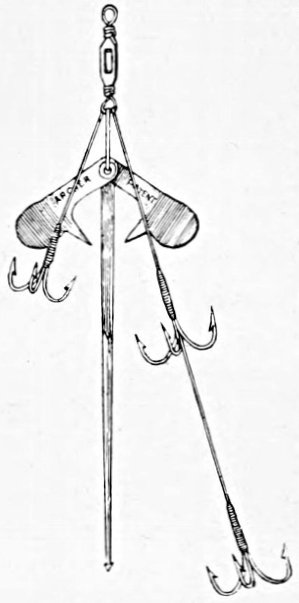
Archer Spinner.
My experience of pike fishing has been chiefly in the Hampshire Stour, which has a gravelly bottom, so that those fish, which are apt to be muddy in flavour, were superior to any I have tasted caught elsewhere. They are to be taken either with a float and live bait, or else with a trolling-rod and spinning tackle, baited with a dace or other small fish. After the care and tact which must be displayed in salmon, and especially in trout fishing, pike seem to be of a very inferior order of intellect. No concealment of one's person at the river-side is absolutely necessary, though it may be advisable sometimes, and the splash made by the bait in the water when spinning and[Pg 213] which is enough to frighten all the trout in the pool, does not seem to affect the appetite of the fish we are now dealing with.
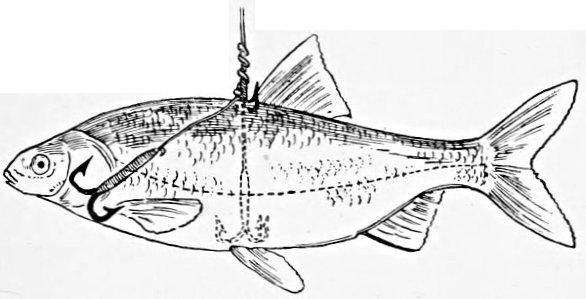
Bickerayke's Snap Tackle.
As far as my experience goes, I should say that gimp is the only thing that will hold a large pike, whose tactics are to cut the line with his teeth, or to wind it round a rock or root in the bed of the river and so defeat his human enemy. Even when safely landed he is still dangerous for he has jaws like a tiger, fitted with large, sharp teeth, which must be approached with caution. The trolling-rod is short and stiff, with large rings so that the line can run freely; the latter cannot of course be wound on the reel when fishing, unless in casting from the reel, but must be drawn in by hand. Great care is required to prevent entanglement, and the angler must beware of treading on his line as he moves along.
I found, inside a pike of twenty-five pounds, caught in the Hampshire Stour, a perch of three pounds, which had been swallowed whole. The pike had, apparently, only regarded this as a Hors d'œuvre and not as a square meal, since he came to my dace with the greatest voracity.
Perch fishing has always had great attractions for me, and I have caught many beautiful baskets of them, also in the Hampshire Stour. They are curious fish in some ways, and are to be found in large companies in pools and lakes, at the time of year when they are in season. When they are on the shallows they are not fit to eat, and will not usually take the bait. We fished for them with a live minnow and float, sometimes from the bank and sometimes from a punt. They do not seem shy, and I have caught them with my hand in the water holding the gut and minnow, but if once a perch is lost, no more will rise in that pool.
They must have some means of communication with each other, for after such an event the only thing to do is to move to another hole. When, by the disappearance of the float under water, the angler becomes aware that a fish has taken the bait, a short time should be allowed[Pg 215] before striking as it must be remembered that the perch has to swallow part of the minnow before arriving at the hook. If left too long, the perch will gorge the bait (and this applies also to pike), the result being very unpleasant for all parties concerned. I have also caught perch with a worm, in which case the bait should be almost on the bottom of the river. The great attraction in this sport is that you can fish on a brilliantly fine summer's day, and see the objects of your attentions swimming about and playing regardless of you in the deep clear water.

Pennell Flight for Small Baits.
It is said that certain kinds of trout croak, but that roach do, I myself can testify, and so distressing is the noise they emit that when I have caught them by accident, I always returned them to the water with great despatch.
Carp and tench are exceedingly shy fish and both prefer muddy and weedy ponds to a clear running stream. In the former they may be caught with paste and other forms of bait, but, to my mind, are hardly worth the trouble and, if wanted for the table may just as well be circumvented with a net, for all the sport they afford.
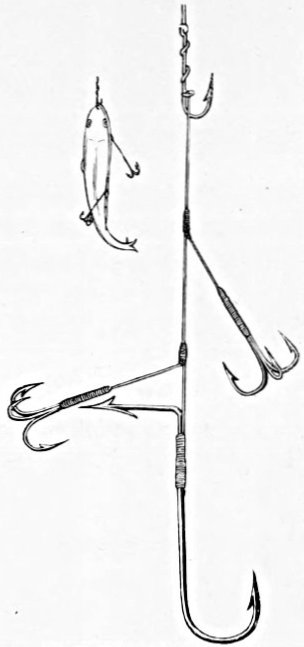
Pennell Flight for Large Baits.
Barbel and bream are very dull fish to catch with a rod and line; the former especially dive at once and burrow sulking in the mud, opposing merely dead weight to the angler's efforts. Dace and chub only remain to be noticed. The former will take a fly very readily, and give very good sport for[Pg 217] their size, while chub are as shy as trout and as difficult to catch, if once they obtain a sight of their antagonist on the bank.
It has only been possible to give a very short account of the various kinds of fresh-water fish, and numerous questions will occur to the novice in angling, which must be elucidated partly by study of the many excellent volumes already published on the subject, but chiefly by experience and consultation with men who possess special knowledge of their own locality.
Still, I hope I have said enough to encourage women to look into the science of angling for themselves, and not to be entirely dependent on the services and advice of anyone who may chance to accompany them.
S. H. Malmesbury.
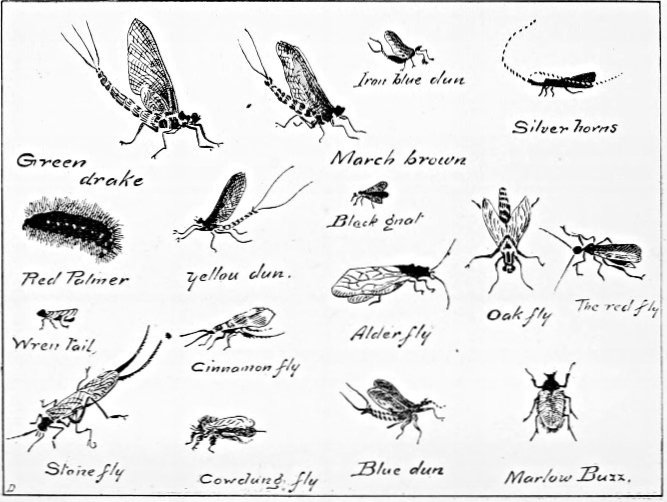
NATURAL FORMS OF FAVOURITE TROUT FLIES.
[4] This hook or beak on the lower jaw of male salmon is a provision of nature to enable them to rake those furrows in the gravel wherein the female deposits her ova. It has been known to pierce entirely through the upper jaw, causing the ultimate death of the fish.—Ed.
[5] The foul-hooked salmon, too, has far more leverage.—Ed.
[6] Rods of split cane are very largely used, and as they are light and strong have much to recommend them.—Ed.

This subject far from being treated exhaustively, or even with any attempt at fulness, will, on the contrary, only be written of, so as to give a few hints to those who love to wield the rod. Bottom fishing, with the paraphernalia necessary to that branch of the sport, has objections at least from a woman's point of view, but to fishing with the fly there is no drawback, unless indeed you happen to be one of those who hold that you should never pit your skill against one of the lower animals in a struggle for life. Of all sports indeed there is none more entirely suited to the powers of woman than fly-fishing. The nicety, the quickness, the light-handedness, and care as to details, and I think I may add thoroughness in any pursuit they really take to, in which women generally excel are all points in her favour the moment she takes a rod in hand. Great strength[Pg 222] is not needed, unless indeed she choose to go after one of the leviathans of the deep, but only constant and exhaustless patience. Yet it is the mention of the last that will make many who know only of the sport by hearsay, look scornful and say they see no fun in standing watching and waiting for the bite that often never comes, and that they prefer something more active. As it is no use arguing with people who are persuaded they view the subject from a vastly superior standpoint, the only answer to this is, "If you do not change your opinion after a week's—or even a day's—experience—well, fly-fishing is not for you."
What I am anxious to impress upon all is, that fly-fishing is not necessarily an expensive sport. For the best of salmon-fishing and the right to try for trout in their choicest waters you must indeed pay, but for the right to fish for their less thought of brethren there need be but small demands on your purse.
My own experience one summer may be of some use to those who would fain do likewise. My lot was cast in a part of Sussex where under the Downs flowed a tiny but most beautiful little river. "No trout," had been the answer given[Pg 223] when I enquired as to the prospect of sport from its banks, so sadly I made up my mind that beyond an occasional visit to a trout stream, owned by some friends in the same county, my rod would be idle that summer.
"If only it was stocked with trout," was my frequent reflection as I wandered along its banks and noted the swift flowing current and the tempting stickles that looked a perfect paradise from a trouting point of view. One evening as I stood watching the clear waters as they rushed round and over some opposing rocks into a large pool, I caught sight of a silvery, most graceful fish dart through the water at the side of the eddy. Then when my eye became accustomed to the curious light, as the rays of the setting sun fell slantways over the pool, through the branches of a mighty oak tree that rose from the banks, I saw another, and another. "Dace," was my verdict, and forthwith dismissed them from my mind. But I had not reached home before the thought of trying for those dace with fly came to me, and the next day, trout rod in hand, and with a Black Palmer and Alder on the cast, I made my first venture in what was to me quite a new branch of sport.
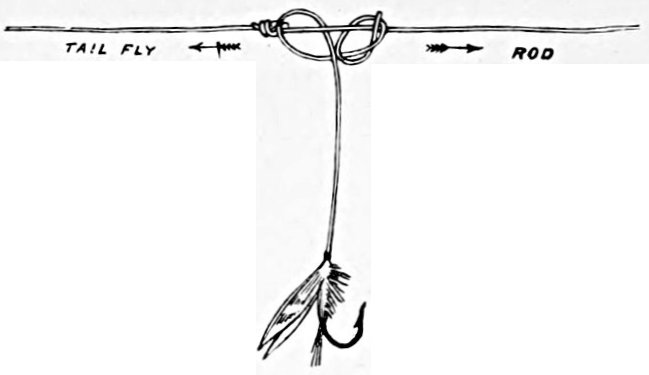
Method of fastening Dropper to Cast.
As the line flew out for the second time and the flies fell gently and lightly on the water, I had but to wait a second before a faint thrill ran through my hand and told me something had touched the fly. Could it be a bite? So different was it to the sudden onslaught of a trout, that I hesitated whether or not to strike, and contrary to the usual fate of the waverer, it was the momentary pause which gave me the fish. A slight movement of the wrist and I had him fast, and then a delicious few minutes followed while I played as game a dace as I ever wish to measure skill with. Indeed I should not have been surprised when at last my prize was safely caught in the landing net, to see the spotted scales of a trout. But no, the slender, silvery, beautiful-headed fish could be no other than a dace, and his captor at least was content with the gallant bid he had made for his life.
If dace would take the fly, why not also roach[Pg 225] and chub, and soon, faute de mieux it is true, but none the less with very considerable enjoyment, I was fishing the little stream for all three kinds in turn. On the gravelly bottom of a certain portion of the water, I found a red Palmer very attractive to the roach which were there in considerable numbers. Some of them were of fair size, the largest I took turning the scales at 1-lb., but I am bound to confess that I found these fish such very shy biters that I generally preferred to try either for dace or chub. One roach, however, gave rather a novel experience by hanging itself in a tree, and causing the greatest excitement among our party, the members of which quickly came from their chosen spots to see and admire. I was fishing from the shelter of a bush on the top of a high steep bank, and with some trees close at the rear and a decidedly fresh breeze blowing, it was not an easy matter to get the line safely out at all. The water, however, was but little disturbed by the wind, from which just there it was protected by the high ground, and the fish were clearly visible in the water below. As there was nothing for it in such a position but to swing the fish out if I caught one, I did not for that once wish to make a big capture.[Pg 226] Scarcely had the tail fly—this was a red Palmer—touched the water than one of the usual shy bites was made, and fortunately my strike secured the prize so far. But he seemed heavy and was, besides, the gamest of his kind I have ever played. Quietly we could not manage things, and it was very soon clear that if I did not then secure him, I need not struggle with the difficulties of casting again in that part of the stream, for every other finny inhabitant would have taken the alarm. All my faculties were therefore intent on the capture. When I saw him at last tired of struggling and almost beneath me, I tried to swing him up, wondering, as I did so, if it were possible my light tackle could stand the strain. A flash of silver through the air, then a puff of wind, and a red-finned, black-backed roach of about 8-oz. in weight, was dangling over the topmost bough of a tree which grew up from the lower part of the bank a little to my left. The poor fish struggled and the line swayed ominously among the branches, till at last a nimble climber released them both, and to my delight restored them to me.
For chub I found a larger fly effective, and a Coachman and a Red Palmer, both tied large,[Pg 227] were what I generally used. In my experience, chub is the most determined biter of any of those I am now discussing, and he is very game up to a certain point, his dashes and struggles as he tries to free himself from the hook, being as fierce as those of many a good trout. The battle, however, will be over much sooner than with one of the latter species, and when you see the inert form in the water, you will realise with sorrow that after all he does not belong to the kind known as "game fish." In fishing for chub you must be as careful about showing yourself as you would be in trying for a trout, for he is very quick in spotting anything unusual, and once he has done this, you may offer him the most tempting flies unavailingly. By the time you have landed a 2-lb. chub, you will, in my opinion, have exercised to the full as much, if not more skill, than you would have done in the capture of a trout, and though the sport of playing him will be sooner over, it will have been good indeed while it lasted.

Method of fastening Reel-line to Cast.
The chub I found to rise earlier in the day in this little Sussex stream than either dace or roach, the two last on the warm August evenings often[Pg 228] rising freely as long as we could see to cast for them.
The great difference between fishing with the fly for game and coarse fish lies in this, that while with the latter you require even more lightness of hand and skill in casting than on any ordinary trout stream, the intense excitement of the moments when you play a good trout or salmon will not be experienced to the same extent. But that sport and good sport may be enjoyed with any of the three varieties I have named, I have proved to my own satisfaction, and I hope that what I have said may induce others to try for themselves.
At the same time that nothing can equal the joy of playing and landing your first trout, I would be the last to deny, for the day on which the first fell to my rod is still marked as a red letter day in my life. This also was in Sussex, in a well-stocked merry little stream which babbled and chattered over its white stones, giving the last touch of beauty to the peaceful valley through which it flowed. After the preliminary walk along the banks of that part of the water I was to fish, so as to get the knowledge of the position of the pools and eddies and overhanging banks without which one's labour is likely to be[Pg 229] thrown away, I sallied forth, rod in hand, to the neighbourhood of a bridge from which I had noted several trout lying with their heads up stream. A few hundred yards from this, where the banks it is true did not seem to offer much facility for casting, there was an eddy at one side of the stream and a mass of rushes on the other, all under the shadow of trees which rose between them and the bridge. When it is remembered that I was trying for my first trout—the experience now lies back in the dim distance of the past—it will not perhaps cause surprise if I say that my whole being thrilled with the excitement of the moment. My cast had a red Palmer for the tail fly, and black Alder as dropper, for at dinner the night before I had been advised to try these by a local fisherman. I should probably make a mess of it, and catch my line in one or other of the traps that literally bristled on all sides of me, was the thought that was uppermost, as after scrambling down cautiously and keeping well out of view, I craned my neck to see how I could possibly get my cast to alight on the spot I had chosen. As I had my hand up for the venture a swift rise just where my eyes were fixed on the water, told me of the presence of a trout.[Pg 230] My line flew out, and the tail-fly falling within the widening circle was instantly seized, and a sharp turn of the wrist gave me a trout with a bewildering suddenness. Up went the point of the rod, and the good cane bent to the weight beneath. A maddened dash across stream to the reeds, was the first attempt of the prey, then a trial to get to the shelter of a rock conveniently near, but slowly and surely he gave in to the steady pull brought to bear on him, and soon I looked with unspeakable delight on a ½-lb. trout, in the prime of condition, safe within the folds of the landing net. That no fish ever comes up to the one you first capture, has since this moment been an article of faith with me. Others larger, gamer, better in every sense may, and will if you have ordinary skill and perseverance, fall to your rod, but nothing will give you the same thrill of rapture you felt when you saw your "first trout" on the bank at your feet.
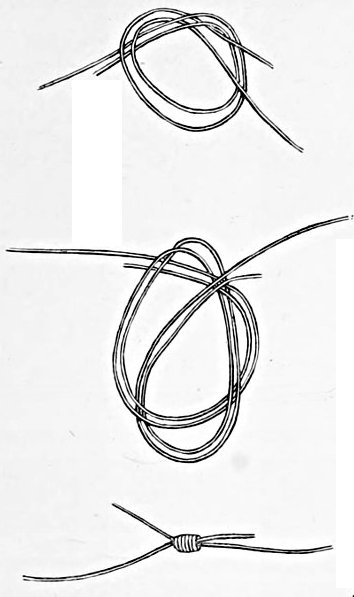
A good Gut Knot.
To make a good trout fisher there are of course many things to learn, and one of the greatest charms of the sport lies in this, that you never come to the end of what there is to know of it. But pre-eminently is it true that an ounce of practice is worth a ton of precepts. You must[Pg 231] to a very great extent buy your own experience, and though you will always do well to profit by other people's advice, you must yourself build up the theories which will show you how, when, and where to cast so that fish may rise to your fly, when they are proof against the blandishments of the less skillfully-thrown lure. That you should always study the lie of the water over which you mean to fish is a truism, and yet it is a fundamental rule to the neglect of which many both men and women owe the fact, that they never rise above a very mediocre degree of skill. Unless you know something of the habits of the fish and the spots in which he is likely to be found, how can you hope to succeed in making him acquainted with your fly? To prevent him catching a glimpse of you, and for this end to be[Pg 232] dressed so as scarcely to be distinguished from the ground upon which you will be standing, to make no noise or disturbance, to throw with the utmost delicacy of hand, to strike instantaneously or the reverse according to the particular class of fish you are angling for, to cast up stream or partly up and across, and never to allow the gut to make a ripple as you draw your cast through the water, all these constitute the ABC of an angler's stock of learning.
I believe that most people carry about with them a quite unnecessary stock of flies, and that as much success will fall to you if you only provide yourself with different kinds of Palmers, Black and Red Gnats, the Black Alder, Red Spinner, March Brown, Blue Upright, Yellow Dun, Stone Fly, Wickham's Fancy, Greenwell's Glory, and on some streams the Green Drake, having these in several shades and tied on different sized hooks, never forgetting to supplement them by any others recommended by local fishermen, whose knowledge remember has probably been bought by careful study and long and varied experience.
For coarse fish I have found the Palmers, Black Gnat, Artificial Grub, and Bumble Bee[Pg 233] the most successful. The Chub always liking their fly tied large, the Dace and Roach preferring theirs small.
A rod well-chosen and well-balanced is of course of the first necessity to your success. To speak again from my own experience, I found an inexpensive light Greenheart made by Hancock, a delightful rod in every respect and with this my first ventures both with trout and coarse fish were made. It only measured 10-ft. 6-in., but was beautifully balanced, and you could make very fairly long casts with it. As a beginner you should always get some experienced friend to choose your rod for you, though like everything else of the kind, you will naturally prefer to make the choice yourself as soon as you know how to test the balance on which all else depends.
In the matter of outfit, you will need a creel which should contain an upper tray for luncheon, a landing net, and one or two casts ready made for use. The last may be fastened round your hat, and of course if you have any idea of being independent and going out by yourself, your creel and net should be chosen with a view to lightness, or they will naturally add materially to the fatigue of a day on the river bank.
Lastly, I would say, that if you should have the opportunity of going out with a good fisherman on a river or lake, there to learn the elements of fly-fishing, by all means avail yourself of it. In no other way can you master the rudimentary practice so easily as from a boat, for there will be no bushes or banks, or the hundred and one difficulties you may have to consider on land, and you will therefore be able to concentrate your efforts on getting your line out in a fairly workmanlike manner.
That you should not be easily discouraged it is scarcely necessary to add, for who that has landed her first trout has not straightway felt the fever of the rod take possession of her?
Frances E. Slaughter.
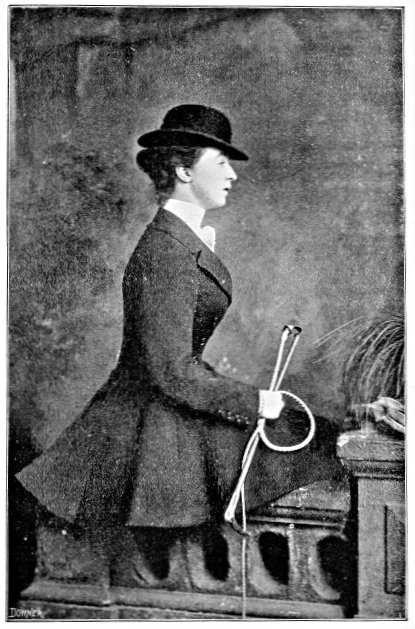
Lafayette. Dublin.
MISS MASSEY-MAINWARING.
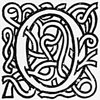
Of the many forms of sport indulged in by women there is in my opinion none more fascinating than driving. Single, pair, and tandem-driving are within the capabilities of most women, though to control a team thoroughly, especially with a full coach behind it, requires exceptional skill, nerve and strength. The first thing to learn when beginning driving lessons is the proper position and use of each piece of harness, the effect of shifting the reins on the bit, the correct position of the bit in the horse's mouth, and in pair or team driving how the horses should be coupled to go well together. There are no two horses quite alike in character, and each one to go well in harness requires attention to his individual habits and characteristics. Very few people realise how much unnecessary pain is caused to horses by mere thoughtlessness. How many[Pg 238] people there are who to be "smart" have very tight bearing reins, never dreaming of the agony the poor animals are suffering when left waiting as they often are at the front door, with their mouths aching and their heads strained up. Yet I do not by any means wish to condemn the use of the bearing rein altogether, especially in a crowded city, as it would be impossible to drive many horses without one. Frequently, too, the bit is put very much too high in the horses' mouths, and then people wonder why the poor animals are restless and fidgety while their mouths are being pinched and cut.
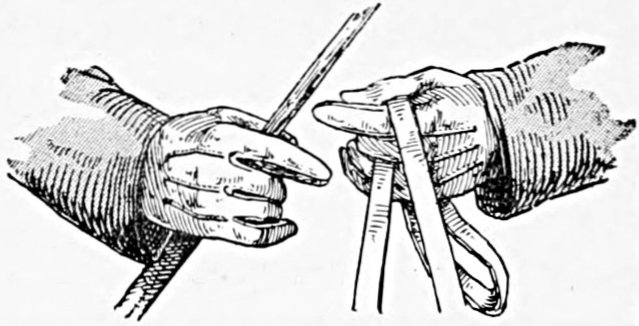
Reins for Single Harness.
There are so many things to be mentioned in speaking of driving that it is difficult to know where to begin, what to leave out, and what to mention. I cannot do better than begin with the start from the front door. There are exceedingly few women who have any idea how to start properly. I remember once noticing a very good whip start. She was ready when the cart came to the door,[Pg 239] for she well knew that nothing is worse for an animal than to be kept waiting. She went and patted the pony, giving a glance at the harness to see that it was all in its proper place. Finding the throat lash too tight she let it out a hole, then unfastening the reins from the off-side terret, she took them in her right hand with the second and third fingers between the two reins, got in and sat down immediately. Putting the rug over her knees, she then transferred the reins to her left hand, the near rein over the first finger and the off rein between the second and third fingers, and took the whip in her right hand. When she was quite ready to start, she dropped her left hand and the pony moved off. My first impression naturally was, "I am sure that girl can drive," and I was quite right.
In driving there are so very many things to be remembered and others to be avoided, that I think a few good rules will be the easiest way of mentioning them:
1. Both the reins should be held in the left hand, on no account should either rein be taken out of that hand.
2. The hand should be kept just above the level of the waist, fairly close to the body, the[Pg 240] wrist being well bent so as to give plenty of spring to the horse's mouth, the nails and thumb turned towards the body and the elbow close to the hip.
3. The reins should be kept close to the knuckles, so as to avoid the possibility of their slipping out of the hand.
4. The right hand should not be kept altogether on the reins, but when on them it should be slightly in front of the left, and the hands should never be far apart.
5. To shorten either or both the reins push them through the left hand from the front, with the right.
6. To lengthen, pull them through the left hand from the front with the right hand, never let a rein slip.
7. Always hold the whip in the right hand when driving.
8. The whip should be held where it balances best, usually just below the collar, and the thong should be kept fairly high so as to avoid the possibility of the lash tickling the horse.
9. Never jerk a horse when starting, and never flap the reins on his back.
10. If a horse does not start when you drop[Pg 241] the hand slightly, draw the whip gently over his withers.
11. When whipping a horse, with the exception of leaders, always hit him in front of the pad.
12. A kicker can often be stopped by a sharp hit on the ears.
13. Always keep a steady, firm, though not heavy hold of a horse's mouth, "feel" his mouth all the time he is going.
14. When driving through a crowded thoroughfare, remember there is traffic behind as well as in front that must not be stopped unnecessarily.
15. Pass all the near-side traffic on its off-side.
16. When turning a corner or pulling up, always indicate your intention, in the former case by swinging the whip in the direction in which the turn is being made, or in the latter by swinging the lash straight above the head.
17. Always go fairly slowly round corners, and keep to the near side.
18. Keep a horse well in hand on greasy wood or asphalt, or when going down hill, and never hurry going up a steep hill.
19. Always look straight ahead, and on no account at the traffic passing or being passed.
20. Never hit a horse when the right hand is on the reins, as otherwise in using the whip the hand necessarily goes forward and relaxes the hold on the rein or reins.
Of course it is quite impossible to lay down rules for everything, and a great deal in driving can only be learnt by long and varied experience. One often hears people talking of self-made whips, but that term generally means people who think they can drive and cannot. For anyone beginning to drive it is essential to start by taking lessons from a really first-class whip. Most of the road coach-drivers give lessons. It is quite as necessary to have good lessons to drive one horse as it is to drive four, as the foundation of pair, team, and tandem driving is to be able to drive one horse perfectly.
A made pair is quite as easy to drive as a single horse, but when it is a case of driving two horses, which have not been previously in harness together, it is quite a different matter. Nothing looks nicer than to see a good pair of cobs in a smart phaeton, going well, driven by a lady who knows what driving means. Women who drive[Pg 243] well, as a rule, have light hands, though many of them do not keep a sufficiently steady hold on a horse's mouth. They so often forget that it is a matter of the greatest importance to feel their horse's mouth the whole time they are going. It is not an easy matter to get any two horses of about the same size to go well together, unless the greatest attention is given to all the lesser details. It is absolutely necessary that the harness should fit well and be properly adjusted. When starting two new horses it is as well to do so with the couplings level and bitted cheek all round. After they have gone a short distance it can easily be seen whether they are going comfortably and well together and each doing his fair share of work. If they are not, the reason can soon be discovered, and the fault rectified. Very often one horse goes a good deal more freely, and takes a stronger hold of the bit, and in that case it will be necessary to see that the other horse has sufficient room in the couplings, and at the same time to put the free horse middle bar if he is inclined to pull. Frequently though, the mistake is made of shifting the reins on the bit when only the couplings require altering. Very few horses carry their heads quite alike, and[Pg 244] consequently will require more or less room in the couplings as the case may he. Many horses too do not carry their heads straight, and need special attention. For instance: it the near side horse carries his head over to the left, the off-side rein will have to be shortened, which means the buckle will have to be taken on the other horse's off-rein. It requires the greatest care and nicety to couple horses correctly, for it makes all the[Pg 245] difference as to the way in which they will go. When putting two horses together it is as well if possible to get them the same size, colour and build. Size is the most important, and many people consider colour the next to be considered, but personally I think colour makes very little difference as long as the horses are the same stamp and go comfortably together. It is most disagreeable to drive two horses together, one having a long swinging stride, and the other taking short "shuffling" steps. It is most trying for the horses too, as the former is sure to do more work than the latter, which to keep up will be continually breaking into a canter.
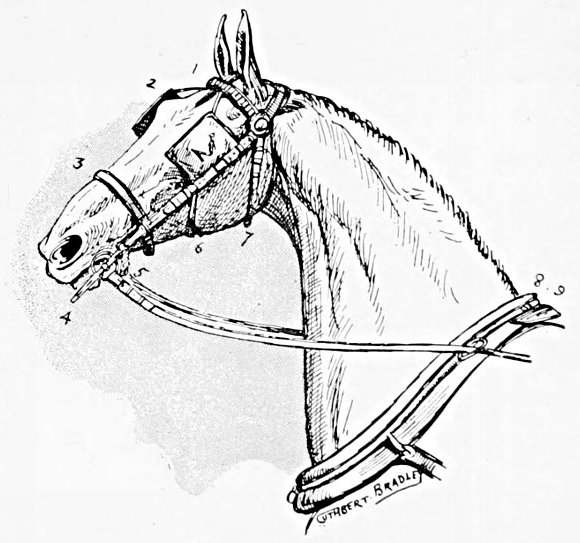
THE HARNESS.
When putting in a young horse for the first time, it is best to put him in a brake with a steady old horse which knows his work. The off-side is best for the youngster just at first, but he should be perpetually changed sides, as otherwise he will be apt to develop numerous bad habits, besides getting a crooked mouth. When starting get somebody to hold his head till ready to go, and then the man should run beside him for a few minutes, without holding him. Be sure to drop the hand to the horses well as they move off, and do not on any account[Pg 246] allow the young horse to be the first to get into his collar, as if you do he will feel the whole weight of the brake and the other horse, and be unable to move, and will in all probability jib. Once a horse has learnt that he can jib, it is a most difficult habit to break him of. Therefore, avoid letting a young horse find out that he can do so. Very often a young horse will go better through the traffic in London than he will round the Park when it is empty, as in the traffic there are so many things to occupy his attention that he will forget to resent he is made to work. If anything frightens him and he refuses to pass it, get him led by and do not hit him, as otherwise he will always associate that particular thing with being hit, and think it is the object of his fright which caused him to be hit, and afterwards either jib when he sees it again, or rush by it. Before a young horse is driven he should be thoroughly accustomed to having the harness on and the bit in his mouth. It is best to have the harness put on with very long reins, so that a man can walk behind him and make him walk as it he were being driven. His first lessons should be short so as not to worry or tire him.
Once a woman can drive any two horses together and make them go well, she will probably be capable of learning to drive a tandem or team. It is very hard to say which is the better of the two to begin with. Personally I think if both are going to be taken up, it is as well to start with a team, but it really makes very little difference. Of course a team requires a great deal more strength, but very often to drive any two horses together makes a large demand on your strength. One of the best ways of learning is to watch a good driver, both going through the traffic and driving in the country, and to pay great attention to his hands as well as the horses, so as to notice how the turns, etc., are done. An easy means of doing this is to take the box seat of a road coach when a professional is driving, and afterwards to take lessons from a road coach driver. A great deal can be learnt at first, simply by watching a person's hands, noting how a loop is made, how when the leaders are turning the wheelers are kept "off" a corner, and how the team is straightened.
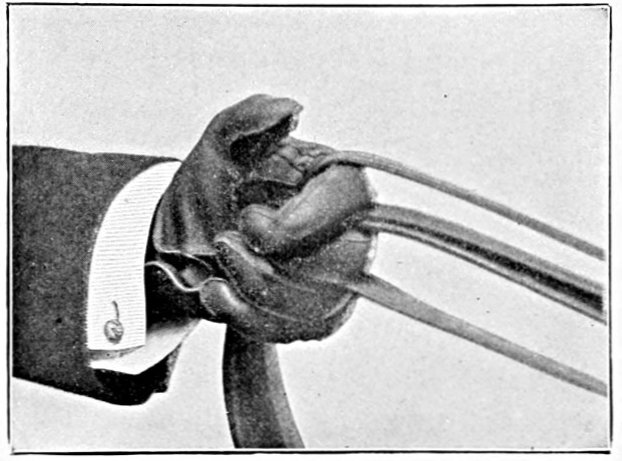
How to take up Reins.
The most difficult thing for a beginner to learn is how to start the horses properly, and how to pull up well. It is absolutely necessary always to see[Pg 248] that the horses and harness are in their proper places, and the horses correctly bitted, as anything being out of place may easily cause a serious accident. Avoid keeping the horses waiting once they are ready to start. Go to the off-side wheeler and take the reins first in the left hand, the first finger between the lead reins and the middle finger between the wheel reins, take them gently so as not to touch the horses' mouths, then pull out a good piece of the off reins, so that the buckles and splicings may be about level when you are seated. Transfer the reins to the right hand, the middle finger between the lead and the third finger between the wheel reins, get on the box, and sit down immediately, so as to avoid being jerked[Pg 249] off should the horses start suddenly. Then transfer the reins back to the left hand. All reins do not have the splicing quite in the same place, but as a rule the buckles and splicing will be about level. Gently feel the wheelers' mouths and then the leaders', the latter should be standing away from the bars. The near wheel rein may be a trifle shorter than the off, as this is the most difficult one to take up in a hurry. Be sure that the leaders have plenty of head room when starting, otherwise they will be likely to jib. Though the wheelers should start the coach, if any one of the horses is inclined to jib he should not be allowed to feel the weight of the coach when moving off. Once started the lead reins can easily be shortened a trifle. Take the whip in the right hand, and drop the left hand well to the horses just as they start, and then bring it back to its proper place. Be careful when dropping the left hand not to bend forward and lean over the reins; nothing looks worse. The proper position of the left hand is about level with the waist,[Pg 250] the elbow close to the side, the wrist well bent, and the fingers and thumb turned towards the body, in fact practically the same as for driving a single horse or pair, but as the driver is higher over the horses and the weight of the reins is greater the hand will probably be a trifle lower.
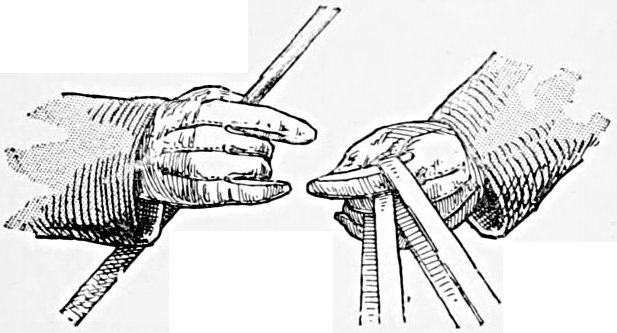
Position of Hands and Reins.
The horses must be continually watched so as to see that each is doing his fair share of the work and that the team is absolutely straight, otherwise it will be quite impossible to get through the traffic or to turn corners properly. It is best always to shorten reins by pushing them through from the front, but at first the beginner will find it very difficult. If the team is not going straight it can generally be put right by either shortening or lengthening the two middle reins—the off lead and the near wheel—these being the two easiest to alter, being together. Of course sometimes only one rein may be wrong, and if that is the case it should immediately be either pulled out or pushed through, or three reins may be too long, and then it is very often found convenient to lengthen the short one, and then put the right hand on the reins some inches in front of the left and slide the left hand up to it. Shortening the reins by this method looks[Pg 251] far more workmanlike than by pulling them through the left hand from behind, and it does not jerk the horses in the mouth.
A team should always be kept well in hand, and a steady though light pressure maintained on their mouths. If a horse is found to be pulling or boring, he should be differently bitted at once, as every horse must be well under control. Before turning a corner be sure that all the mouths are felt, slacken the pace slightly, and then point the leaders in the direction and make the wheelers follow them round. A loop has to be made in the reins as the horses must not turn together, but the wheelers after the leaders. The point or loop is made by placing the right hand on the lead rein of the side to which the turn is being made, some distance in front of the left hand, this depends on the size of the turn and whether the leaders answer quickly, the rein must then be brought back to the left hand and placed under the thumb, which forms a loop and leaves the right hand free either to hit the wheelers or be put on the reins to steady the horses. When the leaders are round the corner the loop can be allowed to slide gradually through the hand, but should never be let go all at once.[Pg 252] In bringing back the loop to the left hand, the leaders must be watched so as to tell exactly how much rein is required to be taken up, to make them turn as desired. Free horses that have been going in the lead for some time, especially if they know the road well, will only require a very small loop. Horses too, that have been in the wheel long are apt to cut the corners very short, as the wheeler on the side on which the turn is being made, recognises the sign of the leaders being about to turn, by feeling the lead rein shortened at the side of his head.
In those cases what is called the opposition point is made use of. For instance, turning to the right the near wheel rein is looped over the thumb, and the off lead is looped under the first finger, to the left the off-wheel rein is looped under the first finger, and the near lead under the thumb. This is by far the easiest way of making the opposition point, as by this means either loop can be let out by itself if necessary. Be careful when taking up a loop never to let the left hand go forward to meet the right. The right hand should always bring the rein back to the left hand. By turning the left hand towards one, the near reins get shortened, and by turning it[Pg 253] outwards, away from one, the off reins get tightened. A great deal can be done by giving the hand. Again a slight curve to either side, not a sharp turn, may be accomplished by placing the right hand on the lead reins and one wheel rein. For instance if an incline to the right were being made, the right hand would take hold of the lead reins and the near wheel. In London, when the wood and asphalt are greasy, it is best to drive slowly, as a coach is fairly heavy and not easy for the horses to stop, in spite of the assistance given by the brake. Going through the traffic the bars should always chatter, which means that the leaders should not be doing their full share of the work, when turning, they should be quite out of draught otherwise the pole would most probably be snapped. Some coaches have a foot brake, and this is very useful, especially in traffic when a lady is driving and has to pull up suddenly, and at the same time it saves the horses' legs greatly, though it does not do to make too frequent use of it. It is best for a lady to have someone sitting on the "brake seat," to put on the brake for going down steep hills, but this person should never touch the brake till he is told to do so, as only[Pg 254] the driver can know the exact moment when it is required.
When coming to the top of a hill, before going down always take a pull at the horses, shorten all the reins, and make sure of feeling all their mouths. The leaders should always be out of draught going down hill, but they should on no account be too far back on the bars as otherwise knocking up against them might cause one of the leaders to kick and get a leg over the trace. Generally when shortening all the reins on the top of a hill, the wheelers come so far back that the leaders are brought right back on the bars, and if anything, the lead reins have to be let out. It is best to begin going down hill fairly slowly, as the pace can always be increased, but it is most difficult to lessen it. When pulling up, run the right hand some way down the reins, and bring it back to the left if possible. It is as well to shorten the reins slightly in the left hand previously. When putting the right hand on the rein to steady the horses, it is a very good plan to place it over three reins only, the third and fourth fingers over the off rein and the first and second fingers over one of the others. The lead reins should never be buckled, and on road[Pg 255] coaches none of the reins have buckles on them as a rule.
One of the great difficulties to be overcome at
the beginning is the management of the whip.
A team whip should not be too heavy, especially
for a lady's use, but at the same time it ought not
to be very light. A whip should always be kept
hung up, and it is a very good plan to keep one
handy and have it down from the wall every day
for five or ten minutes' practice even after you
have learnt to fold it. The common way of
learning to fold or catch is to chalk a big
![]() on
the wall, and beginning at the bottom of this go
upwards towards the right, swinging the lash upwards,
and then allowing it to come back to the
stick. The whip should be held with the first
finger pointing up the stick, and the lash under
the second finger. An expensive whip is by no
means necessary. Schomberg, in the Brompton
Road, has some useful ones at 14s. 6d. In choosing
a whip it is best to get a springy one, with
several knots on the stick near the quill so as to
keep the thong on the stick when folded. It
should balance well when held near the collar.
on
the wall, and beginning at the bottom of this go
upwards towards the right, swinging the lash upwards,
and then allowing it to come back to the
stick. The whip should be held with the first
finger pointing up the stick, and the lash under
the second finger. An expensive whip is by no
means necessary. Schomberg, in the Brompton
Road, has some useful ones at 14s. 6d. In choosing
a whip it is best to get a springy one, with
several knots on the stick near the quill so as to
keep the thong on the stick when folded. It
should balance well when held near the collar.
When on the box the whip should be held in the right hand under the thumb, with the lash[Pg 256] twisted a few times round the stick, which is also held under the thumb. The lash should always be in a big loop, so that there is not more than six inches to spare beyond the hand. The wheelers should always be hit before the pad with the double thong, and the leaders should be hit on the hind legs, by the end of the lash of course. When about to hit the leaders unfold the whip and bring the stick back to the side of the coach, and then by a movement of the wrist send the lash in the required direction under the bars. Afterwards bring the thong back to the stick and fold it up again. When the thong is on the stick, put the left thumb through the loop that is on the stick, pull off the lash and give it one or two turns to the left. In hitting wheelers one must remember that they cannot do their fair share of work if the leaders have too much head room, and it is quite useless hitting them without first shortening the leaders' reins. Above all, when driving a team, keep them well in hand and feel their mouths.
Tandem driving in many respects closely resembles team driving. The reins are held in the same way, and the whip is practically the same though generally rather lighter and the lash a[Pg 257] trifle shorter, but this will depend of course on the size of the horses you are driving. Many people consider a tandem, even apart from the difference in the weight of the reins, more difficult to drive than a coach, but personally I have always considered tandem driving the easier of the two; it is easier to pull up in the traffic and you can turn in a fairly small space, though to make the horses go well they require neat, quick, handling, and exceptionally light hands. Many horses will make good tandem leaders that will not go in any other form of harness; of course, there are many too which make safe leaders, but at the same time could not be called "good." A perfect leader should be quick and free, and always be taking a slight hold of the bit, he should go wherever he is driven and not shy off omnibuses, etc. A slug in the lead is most difficult to drive, and quite takes away from the pleasure of a tandem.
There are two kinds of harness, with and without
bars. With bars is supposed to be the safer
of the two, but, if proper care is taken, there is
practically no danger without bars, as the leader
should never be allowed to get far enough back
to risk his getting a leg over the trace. To
turn, a loop can be taken up just the same as in[Pg 258]
turning a team, but it is necessarily much smaller,
and great care must be taken not to allow the
leader to come completely round. Most corners,
if not sharp ones, can be turned by placing the
right hand over the lead reins and one wheel
rein, but a great deal depends on the give and
take of the left hand. This is a most important
thing, as a tandem turns very easily, a turn of
the wrist being usually sufficient to move the
horses across the road. When the right hand is
kept on the reins, it should be in the same position
as on team reins. When getting into the
cart the reins should also be taken the same way
as team reins, first in the left hand and then passed
to the right, and finally, when seated, transferred
back to the left hand. Before taking the
reins to get into the cart, the whip should always
be neatly folded and placed in the socket ready
for immediate use. Though the wheeler starts
the cart, the leader should have plenty of head
room, or otherwise he will be liable to jib. A
tandem is most useful for going fairly long distances
at a good pace, as the weight is not great
and the leader can do his full share of the work
going up hill. Except when going up hill a
leader should only do a very small share of the
[Pg 259]
[Pg 260]
[Pg 261]work. If proper care is taken, the danger of a
tandem is by no means so great as is generally
supposed, and a good tandem is a most enjoyable
turn-out to drive.
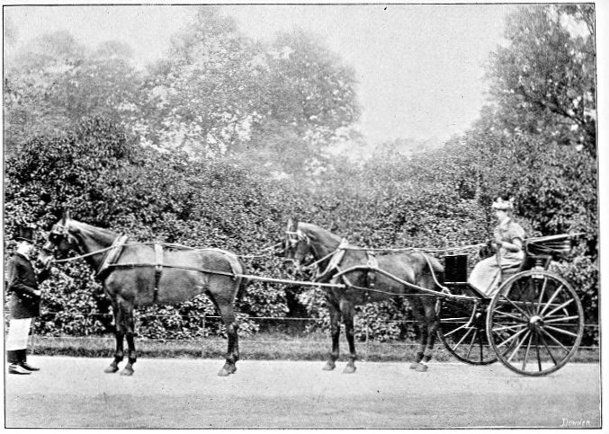
Downer. Watford.
MISS MASSEY-MAINWARING.
I hope the foregoing hints may be of some use to those interested in driving, who wish to become steady and clever whips. The most necessary things to ensure success are plenty of practice in driving different horses, and great care and attention to all the minor details. There is nothing more enjoyable than road coach-driving, in my opinion, except a day with foxhounds. But women should not attempt coaching unless they are fairly strong, and have had plenty of experience.
Before I end I cannot help mentioning one whip whose driving I have always particularly admired, and that is Ernest K. Fownes, of Rocket fame. I have often had the pleasure of seeing him drive, and a useful lesson it has been each time. It is most interesting to watch how he goes through the thickest traffic, never stopping it, and never seeming himself to stop, his horses going as one.
Ada J. C. Massey-Mainwaring.
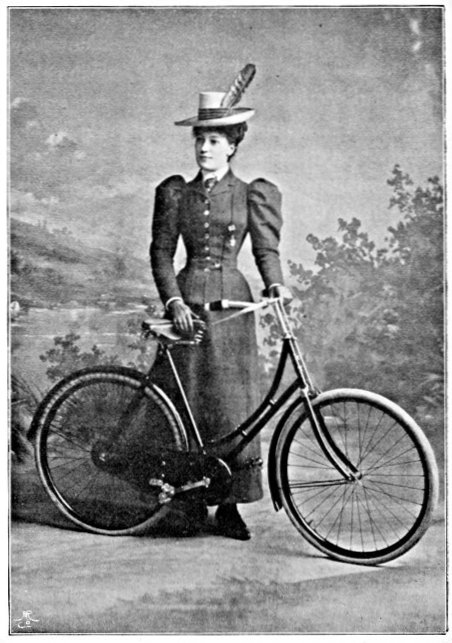
MRS. A. C. HILLS.

The subject of cycling is distinctly a many-sided one. While the same general remarks which apply to the subject of exercise for women, apply also to the use of the cycle, we should remember that though every woman is benefitted by exercise of some kind, there are a few women who are not fitted to ride the cycle at all. This may seem a strong assertion from one who is devoted to cycling, and who so thoroughly believes in its health-giving properties. But though to the practised rider cycling is much easier work than walking, to the novice, or to the unskilled rider, and even to the skilled rider who is out of form, it becomes hard work. Especially in learning, an amount of muscular effort is required which some women are unfitted to undertake. Therefore, we must assume that the would-be cyclist is a person of average health, strength,[Pg 266] and activity, and to such an one, the cycle should be a boon indeed. It is impossible to lay down rules as to who is fit or unfit to take up the pastime, for even doctors are sometimes much at fault on this point. My own view is that any girl, or older woman either, who is used to a fair amount of exercise, should be able to cycle and to cycle well, in time. But those with weak hearts or similar complaints should not attempt to cycle, any more than they should run upstairs quickly or climb steep hills.
Before leaving the health view of cycling, I wish to impress most strongly on all who take up cycling the necessity of "taking it easily" at first. Apart from the fact that actually the hardest work is in the learning, it must be remembered that even after the learner can ride without assistance, the body has to become accustomed to an entirely new form of exercise. If you took a good walker and stopped her from all walking exercise for a few months, how tired she would get when she began again. This fatigue would continue until her muscles had got into good order again, and yet walking comes naturally to everyone. Cycling does not come naturally, except in very rare instances, so how much more necessary is it[Pg 267] to begin carefully, and let the body become gradually accustomed to it. The girl who rides ten or fifteen miles after being on a cycle only once or twice, and who—from not having mastered the art of riding—uses two or three times more exertion over it than she need, would not dream, perhaps, of walking five miles on end at a good pace. Yet she then pronounces the cycle "hard work," and says she finds no pleasure in it. No wonder!
Really to appreciate cycling many conditions are necessary, and that is why I called it a many-sided subject at the outset. First of all it is an active exercise, so those who have not been in the habit of taking enough outdoor exercise in other forms, must not expect to cycle with comfort or enjoyment until they have gradually got their general health, into a state which is known as "fit." Then when the cyclist is fitted in herself to enjoy riding, there are other things to be considered, and these I put as follows:
(a) To ride correctly; (b) to have a good cycle, suited to the particular requirements of the rider, and properly adjusted; and (c) to look well.
First then as to Riding, and here we are met by the reflection, how few women ride really[Pg 268] well. It makes me sad to see how badly three-fourths of the riders one meets are getting along, and when I reflect how much more they would enjoy themselves, and how much better they would look if taken in hand for a time by a good tutor, I feel angry at the so-called "Instructors" one usually has to put up with at the average riding school.
When you are learning, you should if possible select a grass lawn, or failing this a quiet piece of broad road, and practice on this little and often. Short rides, even of a few yards, are valuable, if done frequently. The pupil should not get over-tired, or struggle on after her efforts become worrying. She should take a rest and have another turn a few hours later, and will then find the result very different. To the novice my advice is, do not trouble about mounting and dismounting without assistance, as this will come later as a matter of course.
The object must be to sit quite still in the saddle, and not to rely on the handles. Good riders never move their bodies at all, but ride with their hands just resting lightly on the handles, not pulling at them. In time it will be found the machine can be steered by just slightly[Pg 269] inclining the shoulders in the direction in which it is wished to turn. Above all things when you are learning do not fix your eyes on the front wheel, but look ahead. This is essential.
When the machine goes naturally in a straight line, then the rider will know that she is not only sitting well, but has begun to acquire the art of pedalling. There is a very great deal in pedalling evenly, as this not only lessens the labour but takes away all difficulty of steering. When a rider sits well and pedals well, there is practically no steering to be done, for the machine will go automatically in the direction desired by the rider, or so at least it will appear. The saddle should be so adjusted that when the pedal is at its lowest point, the foot of the rider should be just able to drop on to it naturally, without quite straightening the knee. A good way to test this, is to stretch the toe out as far as it will go (knee quite straight) and if the foot will just go underneath the pedal, no more, the length of reach is correct.
Force should never be exerted in driving the pedals, they must be "coaxed" round, for this in a word is the art of "ankling." When the pedal is at the top of the stroke, the heel should be[Pg 270] downward as in Fig. 1. As the pedal travels forward and down, the foot should follow it, keeping the ankle as still as possible, till at the bottom of the stroke, the toe is pointing downwards, and the heel is highest. The effect of this will be first of all to give power in riding as shown by Fig. 2. If the foot is pressed downward only, it will be in operation for a very small part of the stroke, as the pedal moves in a circle, but by ankling, it will easily be seen (Fig. 3) that power is maintained for a much longer time.
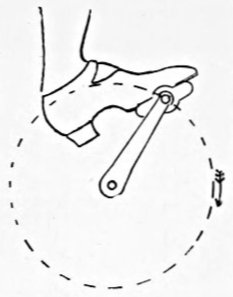
Fig. 1.
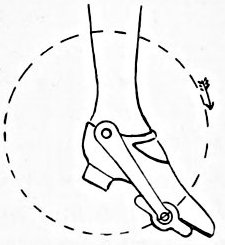
Fig. 2.
From a woman's point of view too the effect of ankling is still more important, as beside the gain in speed, it promotes gracefulness. The rise and fall of the knee in riding, is reduced by one half when the ankles are used properly, and the result to the onlooker[Pg 271] is consequently more pleasing. For the skirt to hang gracefully and the rider to look well, there should be as little movement of the knees as possible. Therefore, if you sit sufficiently high and use your ankles properly, you will not only be using your powers to the very best advantage, and lessening fatigue, but will at the same time be attaining gracefulness, and in every way improving your appearance in the saddle.
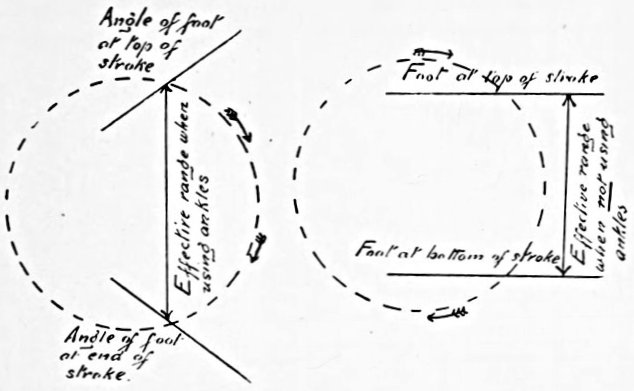
Fig. 3.
Another important point is to keep the legs straight up and down when riding. The knees should not be allowed to go either inwards or outwards on any account, and there should be no "wobbling" in the leg action. The toe and heel should be in a line, at right angles across[Pg 272] the pedal, that is, exactly parallel with the crank all the time. Take care that the heel does not twist at all (Fig. 4) on the stroke.
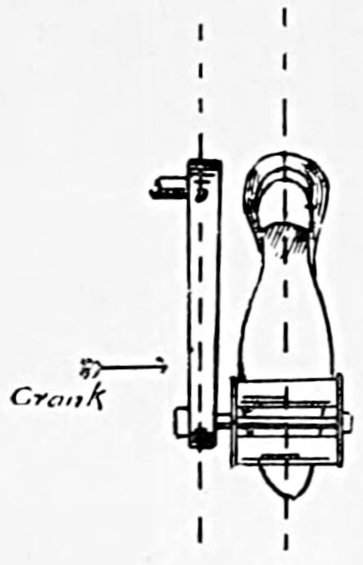
Fig. 4.
Learn to mount from either side of the machine, and to do so lean the machine a little toward you with the outside pedal up, and rather forward, then place your foot on the pedal furthest from you, and as you raise yourself into the saddle, the weight of your body will bear on that pedal, thus sending the opposite one up to meet the other foot.
The dress should be caught in the hand as you put your foot across the machine on to the pedal, and if any further arrangement should be necessary you will, when you are at home in the saddle, find it easy to do this as you go along. A slight pull to the side will be all that is required. When once in the saddle, do not be anxious to find the other pedal, simply keep the machine straight, as it will run a surprising distance of its own accord after the start given to it by the act of mounting, unless, indeed, you should be mounting up hill, which is never desirable for a beginner to attempt. If the foot which was on[Pg 273] the ground is allowed to hang downwards as soon as the rider is seated in the saddle, it will find the pedal quite naturally, in fact the pedal will come round to the foot. In dismounting as in mounting, the rider should learn to do it with equal ease and confidence from either side. When the pedal is coming upward, throw the weight upon it—this stops the momentum of the machine—at the same time rising out of the saddle, then pass the other foot over the cycle and step down in front of the pedal, on which the weight of the body is resting. A firm grasp should be kept on both handles, and the machine inclined towards the rider, on the side she dismounts.
The rule of the road is usually ignored by cycling women, but nothing in connection with the pastime is really more important. To observe it always whether necessary or not, is to reduce the possibility of accident to a minimum. It then becomes a habit, and in an emergency the instinct is to do the right thing immediately, the value of which can scarcely be over-estimated. Always ride then to the left side of the road, whether there are vehicles about or not. Remember, it is the unexpected that always happens,[Pg 274] and should a cart or cycle suddenly appear from a bye road, an accident will almost surely happen if you are on the side that should be free for them. If in spite of your caution an accident happens, you will at least have the chance of being compensated if you can prove that you were on your proper side at the time; you certainly would not, if you were on the wrong side. There are only two occasions on which this rule is deviated from, viz.: when passing a vehicle which is going in the same direction or when passing a led horse going in either direction. When overtaking a vehicle, never pass between it and the pavement or side-walk, for the tendency is for the driver to pull in toward the left when he hears anything behind him. With a led horse the custom is to keep the man in charge always between oneself and the led horse, no matter in which part of the road the latter may be. The reason is obvious, led horses being sometimes playful with their heels.
The most fruitful cause of accidents is the wrong taking of corners. The right way to do it, however, is very simple. Thus if proceeding along a road, and desiring to turn off to the left, make the curve (if possible) in the road you are[Pg 275] in, and thus enter the other road on the left, i.e., safe side. Remember that you cannot see what is in the other road, and the act of turning will make the machine swing out more or less from the proper side (Fig. 5).
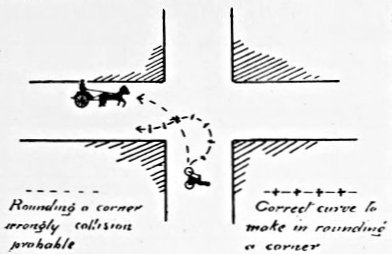
Fig. 5.
The principle is reversed when taking a turn to the right. Never cut across the nearest corner in doing this. Go nearly across the side road so as to turn into it on your proper side thus (Fig. 6).
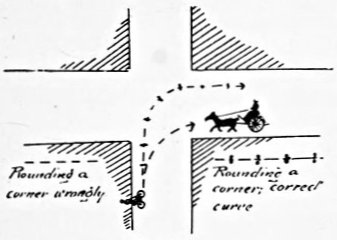
Fig. 6.
If these simple matters are borne in mind, a cyclist may go many years without even the risk of an accident. Another thing to remember, is never on any account to lose control of your machine when descending a hill you do not know,[Pg 276] if the bottom of it cannot be seen. Though to "fly" a hill is the height of enjoyment, safety demands that the end of the spin should be visible, or that you should know your ground thoroughly.
In the choice of a machine, remember it is very essential to have a cycle well suited to the rider. Cyclists of experience get to know their own requirements exactly and can suit their physical peculiarities, but more often than not the beginner is entirely in the hands of the cycle agent. Hence we so often see a slight, frail woman struggling along with a great, heavy unwieldy machine altogether beyond her strength, or on the other hand a heavy woman who is obviously under-mounted. For riders who are of moderate height or even a little over I believe in 26-inch wheels, but tall women should have 28-inch wheels fitted to their machines, to look proportionate to the extra high frame necessary. In the latter case everything else should be also larger. The 26-inch wheels look well for all but very tall or stout riders. The usual height of frame is about 21 inches measured from the top of the frame—the part where the seat pillar is fixed in—to the centre of the bracket axle (Fig. 7). This will[Pg 277] accommodate riders whose length of leg-reach is up to 32 inches or 33 inches. It is better on the whole to have the frame too short than too long. It is more rigid if short, and a little seat pillar standing out will not detract greatly from the appearance. Always ascertain that there is a margin of at least six inches between the height of the seat pillar, when down at the lowest point, and when raised to the fullest height at which it can be safely fixed. Exactly the same should apply to the stem of the handle bars, as, if the saddle is raised the handles should be raised to a corresponding degree, otherwise the rider will be in a stooping position. The exact position of the handles depends a great deal on the length of arm and length of body of the rider, but in the ordinary way the lowest part of the handles should be at least two inches above the saddle (see Fig. 7), as it is above all things necessary that the rider shall not have to stoop forward when riding. On the other hand, the handles must not be higher than is necessary for a comfortable grasp, otherwise the effect will be extremely ungraceful. As the rider sits in the saddle with her arms extended straight downward, she should be able to swing them forward exactly into the riding[Pg 278] position, without bending the elbow in any appreciable degree.
In purchasing a cycle the most important points for the rider to consider are:
1. Rigidity of frame.
2. Weight.
3. Width of tread.
4. Height of pedal from the ground.
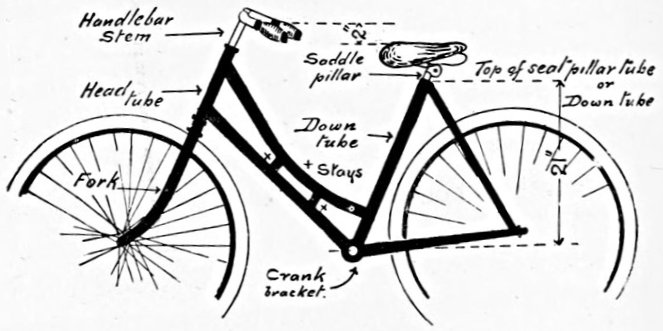
Fig. 7.
Rigidity of frame means speed, i.e., ease of propulsion. If the frame is badly designed it will yield sideways to the rider's pressure, and much of the power which would be otherwise used to send it forward will be wasted. If you grasp the steering head and the down tube of a cycle (see Fig. 7) and endeavour to twist the frame, you[Pg 279] can ascertain whether it is rigid or not. It should not be possible to force these two points towards each other at all, or to pull them sideways out of line with each other. If you can, there will be no chance of riding up a steep incline on that machine! There is another essential matter on which the purchaser can protect herself. This is to see that the cycle is properly stayed in various parts of the frame. These "stays" bind the whole frame firmly together and prevent "give" or yielding, when pressure is applied on the pedals. In addition to the "stays" in the front portion of frame (examples of which are shown in Fig. 7) there should be a stay between the two back legs, just above the back wheel.
If you are purchasing a machine with an acknowledged reputation, and made by a maker of standing, it can safely be assumed that these matters have been provided for, as they would only be omitted on the score of cheapness. Never on any account be persuaded to ride a machine which is not fully guaranteed by a well-known firm. There are so many points on which a cycle may be faulty, and the only safeguard to the rider is that the work shall have been carried out in the most careful and conscientious fashion[Pg 280] throughout. Therefore I would repeat never trust yourself on any but a machine by a good maker. Far better buy even a good second-hand cycle than a "cheap" new one, for the latter may cause constant trouble, to say nothing of the possibility of serious accident.
The weight of an ordinary good-class ladies' machine should not be over 30-lbs. It is possible to obtain them fully equipped at about 28-lbs., but to get them at this or less either the weight of the tyres, etc., have to be very much reduced, or the fittings are not efficient. If the tyres are very thin and light they will be constantly puncturing. The gear case too should be of sufficient stability, and the same remark applies to the dress-guards and mud-guards; in fact it is in the fittings that the weight of a cycle is found, the actual frame not weighing more than 5-lbs. as a rule. This is the reason why American machines are lighter than English, the simple explanation being that the former are fitted with the flimsiest of chain covers, mud-guard, brake work, etc., whilst the English-made cycle is properly equipped for use in all weathers.
The width of "tread" is important, as both for comfort and speed and also on the score of appear[Pg 281]ance, the rider's feet should not be wider apart than is absolutely necessary. A narrow "tread" is the sign of a well designed machine. To measure this, the distance should be ascertained between the inside faces of the two cranks, and this distance should not be above five inches.
The height of the pedals from the ground is a point which is never overlooked by a really good firm of cycle makers. It is desirable to get the pedals as near to the ground as possible for comfort in mounting and for ease of propulsion; but there is a limit, as if too low, the pedal would be likely to catch the ground when the machine leans over on a sharp corner. The consequence of this would be disastrous to the rider. There is also the lesser danger of the pedal striking a stone if too near the ground. The usual distance is about ten or ten-and-a-half inches from the centre of bracket-axle to the ground.
Suitable clothing is as necessary in cycling as in all other forms of exercise. Warmth with lightness are the things to be aimed at, while it is of the first necessity that there should be no pressure anywhere, from the crown of the head to the soles of the feet, to impede free circulation. Having said this, little more[Pg 282] remains to add, as each rider will naturally have her own ideas as to the underclothing she prefers, and provided this is warm enough to guard the wearer against chills and sufficiently light to prevent it adding to her fatigue, I do not think it much signifies what she chooses. Silk or woollen knickerbockers of some dark colour should of course be worn, and these which should be cut fairly full must on no account be made of very heavy material, a warm flannel lining being sufficient in any case to give warmth.
A loosely-fitting bodice, or nicely-cut coat, according to the time of year, will be found suitable, and this brings me to the part of our attire about which there is a real difficulty, namely, a well cut skirt. Of all the many so-called cycling "skirts," there are but few really suitable for the purpose, for not only is it necessary they should be useful, but it is on the way they fall that the graceful or other appearance of the rider will greatly depend. A woman may sit well and pedal to perfection, but if she has a skirt that does not hang evenly and easily on each side of her saddle, and is of the right length, she will not look well in motion.
The great difficulty is of course to get the[Pg 283] "hang" right beside the saddle, and to ensure the fulness keeping it its proper place, I have originated a method for my own skirts which I have found answer well. This is very simple, and consists of a V shaped piece of the material of which the skirt is made being firmly stitched on below the band at the back, to hold the pleats in place. With this, the fulness does not move too easily to one side, when the necessary touch to the skirt is made in mounting.
The skirt should be cut slightly longer behind than in front, as of course when the rider is in the saddle it will hang shorter than where it falls straight down. When the wearer is standing up, the skirt should come to within six inches of the ground in front. As regards width, it should not be too full, as nothing looks more ungraceful than a skirt which flies out on either side with every turn of the foot. At the same time it must be full enough to allow complete freedom of movement. About three-and-a-half yards is generally considered the right width. When having a skirt made from a new pattern, I should always insist on having it fitted when you are seated in the saddle, as only so can you tell how it will really answer.
For keeping the skirt from blowing up, I have[Pg 284] found nothing better than to pass the feet through a strap of ¼-inch elastic, about nine inches in length, laid flat against the inside of the hem. These straps should be placed about ten inches on either side of the middle of front of skirt, so as to enable you to walk without inconvenience.
As a material, a light woollen cloth of dark and unobtrusive colour is in my opinion the most suitable.
For riding you should have a hat that will not catch the wind, and as shade for a part of the year is desirable, you will find nothing better than a "sailor" as a fitting accompaniment to a sensible and workmanlike dress. A common mistake is to have a heavy hat with a great deal of trimming, which cannot be comfortable during rapid motion through any but the stillest of atmospheres.
As to foot-gear, a low-heeled flexible waisted shoe is to be recommended, with gaiters for winter wear.
An important matter for all and especially for the delicate in health, who may so often derive benefit from cycling, is to guard against a chill after riding. No time should be lost after reaching home, before putting on a complete set of[Pg 285] dry underclothing. It is by standing about, perhaps out of doors or in a draught, till the warm glow which was upon you when you stepped off your machine has given place to a shivery feeling, that you will get harm instead of good from your pleasant spin, whereas a warm bath and a fresh set of clothing, and not even the most delicate need suffer from her exertions. If you should for any reason not find this possible without a certain delay, then put on a warm coat or other wrap immediately, and this will generally prevent you from suffering any ill effects.
You should always have your cycle dusted over and any mud carefully wiped off, directly you return from a ride. To prevent damage to the enamel, the mud should be wiped very gently with a soft wet cloth, and if this is carefully done it does not matter whether the mud has dried or not. The bright parts should be rubbed with a soft leather or "selvyt," and then a Holland cover be thrown over the machine, to keep it free from dust or any slight damp. With the exception of a rub with the "selvyt" the cycle will then be ready for use. If a slight application of a good furniture cream is made to the enamelled parts, it will brighten them considerably. When[Pg 286] it is known that the machine will not be required for any length of time, all the bright parts should be smeared with Vaseline, and the machine itself should be stood in a dry place. It is best to rest it on a small stand, which is also very useful for cleaning purposes. After a long rest all the bearings should be well oiled, the lamp refilled, and the machine generally overhauled. The tyres should be kept hard. Some people let the air out when their machine is not in use, under the idea that it is good for the tyres, but this is a mistake. If the tyres are allowed to go flat, the weight of the machine will be likely to "nip" the inner tube. Above all, oil should be kept from the tyres, and if any should by chance drop on them while the machine is being oiled, it should be carefully wiped off. A tyre should not need blowing up, more than once in two or three weeks, if the valves are in good order. If, therefore, it should require inflating every day, as sometimes happens, either there is a small puncture, or the valve is out of order. If the trouble is caused by a puncture, it will generally mean a visit to the repairers, but first examine the valves in case these should be at fault, for very often a little attention to them will put[Pg 287] matters right. As there are so many kinds of valves a technical illustration would be of little use, but as a rule all valves can be unscrewed and examined easily. In the valve most in use, viz.: that of the Dunlop tyre, if the end is unscrewed—after the dust cap is taken off—the whole mechanism of the valve can be taken out, and this will be found to consist only of a small cylinder covered by a little indiarubber tube. This piece of rubber covers the valve hole in the cylinder, and it is the rubber which generally wants replacing. The dust cap is the small cap, attached by a little chain to the spokes, and which is screwed over the end of the valve to keep the dirt out, after the tyre has been inflated.
If the rider does not object to a little trouble, a puncture can be repaired at home, though the chief objection to the operation is the dirty state in which it is apt to get the operator, unless indeed the tyres are thoroughly cleaned first. When you buy a machine, the exact details are given with each particular class of tyre, and general instructions for repairing will be found included in the repair-outfit, which can be purchased for about sixpence. This tyre-outfit consists of a small quantity of solution—which be[Pg 288] careful not to get on the fingers—some rubber patches, and French chalk. When the inner tube has been taken off, the valve should be refitted to it, and the tubes inflated. Then pass the tube through water, using a shallow bowl for the purpose. From each spot where there is a puncture, little air bubbles will come out whilst the tube is under water. Mark these with a pencil, let the air out—by the valve—and dry the tube. Then with a piece of glass paper, clean the tube from sulphur—till the natural dark colour of the rubber appears—where the puncture is, say for a space as large as a sixpence. Put some solution thinly on the rubber patch, let it nearly dry, and then press it down on the tube, on the spot cleaned from sulphur, and hold it there for a minute or two. The puncture of course will be in the centre of this spot if you have managed properly. A little French chalk dusted over the patch will prevent any solution there may be round the patch, from sticking to the outer cover when the tyre is put together again.
With regard to the general adjustment of a cycle, it is most essential that all the bearing parts should be in proper order, as any one of[Pg 289] them will make a very great difference in labour to the rider. A few brief notes on the principal parts will enable the rider to ascertain if her mount is in proper condition to do justice to her own riding powers. First the chain. This should be oiled occasionally in its whole length, so that each joint is properly lubricated. When it has been oiled along the top half, the wheels should be revolved sufficiently to bring the other half on top for oiling. The chain must not be too tight, or the machine will be hard to drive, neither must it be too loose, or accidents will occur. The state of the chain can be ascertained by taking hold of one pedal, whilst the machine is at rest with its weight on the ground. The pedal and crank should just show the slightest perceptible movement, without moving the machine, if the chain is in good order. The pedals should revolve twenty or thirty times at least, when given a good sharp spin with the hand, and there should be no perceptible shake in them. The steering is a very important point, as if this is stiff it will increase the labour in riding. If the front wheel is lifted from the ground, its own weight should make it drop over to one side or the other, which ever way the[Pg 290] machine lies, else the steering is too stiff for easy riding. There should be no shake whatever in the steering, the front wheel, when tested, should be immoveable from the rest of the machine, either backwards or forwards. All the bearings require a moderate oiling for about every fifty miles you ride. Olive or other clear oil is used for lubricating the bearings, and on no account must paraffin or a similar oil be used, except for cleaning the bearings out. Most cycle depôts supply a suitable oil for lubricating. Once or twice in the year it is advisable to run paraffin through the bearings, but care must be taken to drain it all out afterwards, and the bearings should then be oiled with proper lubricant. Sperm or colza oil is good for burning in the lamp. Add a small piece of camphor to this to give a clearer light. A little paraffin may be put on the top of the wick at the burner, to make the lamp light easily, but if this is added to the burning oil, the lamp will smoke, and be liable to jolt out over rough places. If the machine is properly adjusted and well oiled, the wheels should—after being revolved—swing back and forth once or twice with their own weight. At the same time, no "shake" should be discernible sideways, but[Pg 291] the wheels should appear to be a rigid part of the machine.
Lillian J. Hills.
A very useful aid to wheel-women is the Cyclists' Pocket Book. Most portable and well printed, it contains all kinds of useful information as to the obligations of cyclists, the care of the machine, and some most excellent and practical hints to those about to take a tour. A list of reliable cycle repairers, of hotels which cater for cyclists, besides an almanack and other items usually found in pocket books, are contained within its covers. As there are books which no gentleman's library should be without, so this is one of which no cyclist's pocket should be empty.
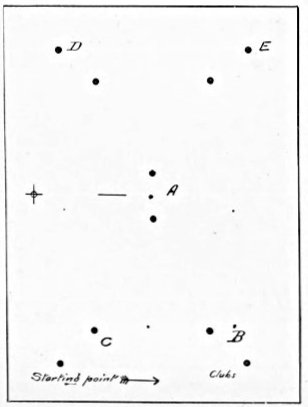
Fig. I
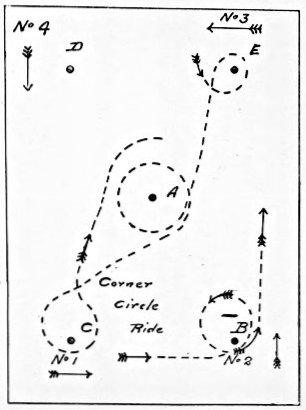
Fig. II

The branch of Cycling familiarly known as "figure riding" is open to all, and there is no doubt that the short turns and rapid curves required are not only fascinating, but at the same time excellent practice. The control over the machine given by them will enable the rider to pick his or her way very exactly through the most difficult pathway. Some may laugh at the idea of "riding to music," but having once tried it you will find they are generally glad to do it again. The figures, varied as they are, and presenting almost endless possibilities, are intricate enough to give a beginner in this branch of the art, absorbing work, and even afterwards, when perfection has been attained, there will be found a charm in winding in and out in the execution of the figures, so long as everyone engaged in the ride[Pg 296] keeps time. For it must not be forgotten that it is in the neatness and precision with which they are done that the fascination exists.
It was while staying at an hotel in the country that a rainy day drove me to the nearest Gymnasium to try Cycling for the first time. As it happened, the instructors were accustomed to put up clubs and teach their pupils to circle round them so as to ensure balance and absolute control over their machines. I believe it was by accident that they first tried riding to music, but once tried it was never abandoned, as it was found an enormous help in keeping a regular pace, and in enabling the leader to guide the ride more accurately. Nothing but a waltz, however, will be found suitable. In the summer, shortly after this, I first turned figure riding to account, as a means of amusing my guests, and I found it so popular that eventually I procured the services of an instructor, and we used to ride every afternoon.
It is surprising how many miles one goes, simply turning and twisting, and going over the same ground. With tea spread near by, and comfortably seated in easy chairs, placed so as to command a view of the riding, even the onlookers, I found, were well amused, and for those who[Pg 297] wish to spend a delightful summer's afternoon in an exercise, combining sociability and amusement, I know of no better pastime than this.
There are a few simple rules to be attended to, which it may not be amiss for me to state, and then by the aid of some diagrams I hope to give the key to what may look difficult, though, in reality, it is easy enough.
1. In the first place either a Gymnasium or smooth lawn must be selected to ride on. In the latter case it will not hurt the grass, no matter what your gardener may say to the contrary, and if he will only water it and roll it daily, or even twice a day, you will have a delightful ground, and in the following year an even better grass crop than if it had not been so treated.
2. The lawn should be the size that is usually allotted to a full size Croquet lawn. However, there is no rule as to size, though with a greater number of riders, you will have to go over a larger space. I, therefore, recommend a fairly large ground, especially as after rain the grass is apt to become slippery, and even in those rides which are done by only four riders you will have to make larger circles to avoid accidents.
3. Never attempt to do the rides too quickly.[Pg 298] Sacrifice speed to exactitude when necessary, and pay great attention to making all your turns simultaneously.
4. If a mistake is made in a figure, dismount and begin again. In some of the rides if one person makes an error, she can ride to the side and dismount, while the others continue, but in most cases this will put the ride out, and it is better for all to stop. In any case no one should ever try to cut in and resume her original place or join in a ride after it has begun.
When possible, it is best to have someone on foot who will give the word of command, for this is a great help, not only to the leaders but to all who are riding.
Before mounting or dismounting, have the order given to do so very distinctly, and make it a never-failing rule never to let the riders be taken by surprise. I think too, at a garden party, it is always a good plan to let all who are going to take part in the ride join in the first figure, as it will make them feel more interest in the proceedings, and give everyone time to become at ease on their bicycles. For this purpose I would suggest the "double snake" through clubs. (See Fig. 1.)
For this you will begin with "single snake," by riding once round the lawn. Be sure that everybody is in line when the word to mount is given; it creates confusion and leads to unnecessary collisions when several mount in a group. Of course the pace must be regulated by the leader. Starting at the corner below clubs C, this rider will go round outside the clubs, and having reached the point marked (*) will turn in and ride straight between clubs A, then going to the right between those marked B, and afterwards through C. At the same place the turn was made the first time it should be repeated, and having passed between A turn to the left through E and D. After repeating some four or five times begin the "double snake."
Up to this point all have followed one leader, now two will be required. Continue as before, but when leader No. 1, after passing through clubs A turns to the right to clubs C, leader No. 2 will turn to the left between E and D. The third rider will then follow No. 1 and the fourth No. 2, each keeping her original distance, for when leader No. 1, having passed clubs C turns through A again, No. 2 will fall in behind, and the same with all the others, each resuming her[Pg 300] original place. The next time No. 1 will turn to the left, No. 2 to the right, each leader being followed by half the riders, dividing alternately. To finish the ride all will follow leader No. 1, and having again been the round of the lawn should dismount together. To add to the effect it is most important that this should be done in line and simultaneously. Although exceedingly easy, when done with care and in time with the music, this is a very pretty ride.
The next ride is commonly called "Centre Circles." This cannot be done by more than four. Each rider will start from her own corner, and while riding separately should remember that No. 1 always regulates the pace, and the others must keep in time with her. The proper distances should be kept in the ride round the ground, and then No. 1 having come abreast of club E, No. 2 abreast of club D, No. 3 with club C, and No. 4 with club B, at the word "circle" all will circle to the left, making a semi-circle, and when abreast of club A circling that fully, and branching off when No. 1 is again beside club C, which she encircles. Thus: As No. 1 goes round her club (E) the others will circle theirs, and as all are doing the same figure at the[Pg 301] same time the four will meet in the centre circle (A), and when No. 1 turns off to circle club C, No. 4, who began by circling club B, will go to club D, and circle that, and No. 3 who began at Club C will go to club E (for her second circle), etc. This can be continued as long as desired,[Pg 302] the riders No. 1 and No. 3 alternating between clubs C and E, and the other two taking clubs B and D. Each one, from her own starting point, does exactly the figure as drawn in Figure 2.
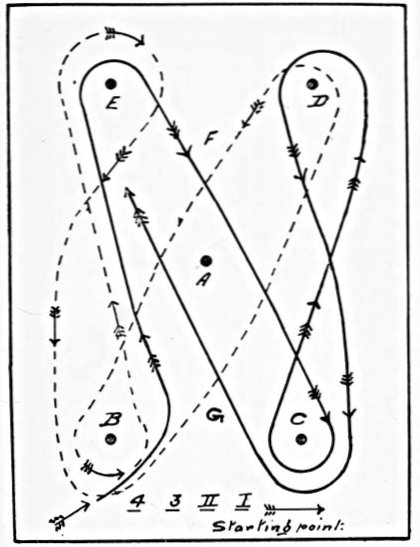
Fig. III
Cross bows.
Another ride, but requiring more accuracy in time-keeping, is that known as "cross bows," and this is one of the prettiest of all, for the whole of the lawn is occupied, and when done by practised riders and rather quickly, it is charming to watch and most fascinating to do. Again four riders are required, and they mount in line. The five clubs are in the same position as for Centre Circles. In this ride, however, there are two leaders, No. 1 being followed by rider No. 3, and No. 2 by rider No. 4. As in Figure 3, leader No. 1 will follow the dotted lines, while leader No. 2 will go over the heavy lines indicated; rider No. 3 following leader No. 1, and rider No. 4 following leader No. 2. It is imperative that the original distances be kept exactly, or in crossing at points F and G there will surely be a collision otherwise. This being a complicated ride to do well, it will require practice, but I think that by following the lines of the diagram there will be no difficulty in learning[Pg 303] it. Leader No. 1 (having led the ride all round the lawn) on reaching club B will ride straight across to club D, keeping to the right of centre club A, and turning round club D will then ride straight back to club B again, followed by rider 3. At the same time leader 2, in starting the ride, will turn short to her left, going outside club E, where she begins the "cross bow," by riding straight across the lawn to club C. Leaders 1 and 2 should reach clubs D and E simultaneously and turn them together, and leader No. 1 making her curve closer to the club than No. 2, should pass the point F on the diagram just as No. 2 reaches it on her way to club C. In this way rider 3 will pass point F immediately after No. 2, and rider 4, following No. 2 will pass F a second after No. 3. Reaching B, leader 1 will now make the double curve round clubs B and E, as shown, and leader 2 will do the same between C and D, and on reaching B and C again, they will do once more the "cross bow" as described, only this time leader 1 will pass over point G first, and leader 2 will follow, as was done before in passing F. The greatest exactitude should be kept in crossing each other, for not only does safety demand it, but when[Pg 304] done with indecision and over zig-zag lines, the figure loses its beauty, and like all the other rides, becomes difficult to follow. It is fatal to any ride to do it in a wavering way, which will impress people with the idea that you are not sure of it yourself. The best riders I have ever seen doing these figures, have always emphasized the straight lines, thus making their curves seem more sweeping by contrast, and adding greatly to the effect.
Another thing figure riders invariably advocate, is to ride very high, and certainly once any one has ridden with both handle-bars and seat well up, they never can go back to the lower saddle. Some people indeed say it is more difficult to ride high, but I do not think when you have become used to it, that you will find it so. Of all things to be avoided I would mention the mistake of putting up the handle bars, without heightening the saddle. I heard this position once described as that of "begging," and it has always seemed to me irresistibly ludicrous ever since. If you will watch the ankle play of two riders, one with the saddle high and the other with it low, you will not hesitate an instant as to which position is preferable.
There is no limit to the number of rides you can do. Almost any book of army drills, especially for cavalry, will give you ideas for a hundred new figures, and you can vary these, not the least amusing part being in creating, adapting and arranging figures to add to the old repertoire.
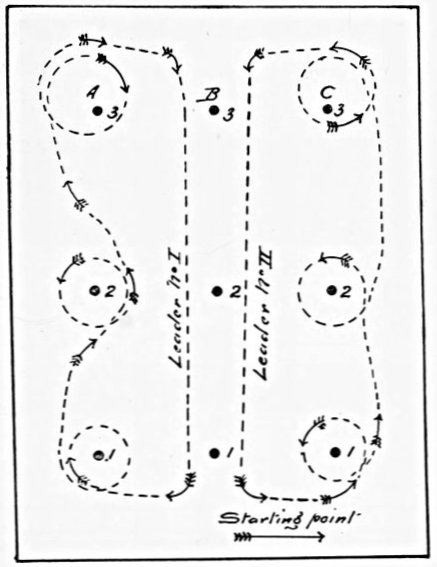
Fig. IV
American Circle ride.
But to go back to the well-known figures, with[Pg 306] which one is never tired, and which always hold their own as to prettiness.
Let us continue with the "American Circle Ride." This can be ridden by any number and is a great favourite when introduced at garden-parties. With eight riders, three rows of three clubs each are needed, and these rows should be about three bicycle lengths from each other, while two bicycle lengths should separate the clubs in the rows. All the riders start in a line. On reaching line B, leader 1 goes to the left of Club 3, and No. 2 will keep to its right so that they ride side by side, divided by the clubs. The others divide in the same way and at the bottom they will turn to their respective sides, leader No. 1 following line A, and leader No. 2 line C. To begin with, they will both do the circles to the left as drawn down line C, and meeting at the top they again come down the centre on either side of Clubs B, side by side. The second time they both do the ride as shewn through line A, doing the middle club the reverse way to the first and last, and for the third round, reverting to the ride as shown through Clubs C, only of course, where those following leader 2 turn to the left, those following No. 1 will turn and[Pg 307] circle to the right. In coming down the centre the leaders can join hands, and the others naturally will do the same, but this is generally called by another name, and is often worked as another figure.
Speaking of circling to left and right brings up another very pretty figure for a number of riders. Set your Clubs as for "Centre Circles" and begin (all following one leader) by circling Club B, going right round it as shown in Figure 2, and going on to E, then D, and finally to C, then describe the double curve as shown in 'cross bows' (between Clubs B and E of Figure 3) only ride straight round Club D—Figure 2. The Club marked E in the former, is D in Figure 2. Having gone round Club D, go on to Club E, and circle that to the right, and then on to B, and so circle every club as you come to it. Having circled D again, to finish the ride, go to Club C passing outside it, and then straight round the lawn. This can be done by two parties at the same time, one starting from Club B, the other from Club D, and each doing the same thing at opposite corner Clubs throughout the ride. I have seen as many as twenty riding in this figure together.
The "Maypole" is of course very pretty and when care is taken to ensure the riders having ribbons to match the colour they wear, or in which they have decked their bicycles, it is lovely. It is simple to execute, too, and can be done by almost any number, though I think eight or ten quite enough. Half the riders will go to the left, the other half to the right. Supposing the pole to be in the centre of the lawn, the four who are going to the right will mount at the four points of the compass, holding their ribbons high above them, in their right hands. The other four will mount, a little farther from the pole, as they will make a larger circle to begin with, and hold their ribbons in their left hands as they go to the left. In order to weave a regular pattern, those going to the left and right must pass each other in and out, as they meet. It is easier to learn the ride if Clubs are put up, where the riders should meet and pass each other, as they go in and out. There should be an even number of riders and a club for each. If eight were riding, four would pass the first club on the left and the next on their right, and so on, while the other half would pass their first Club on the right and the second club to the left. It will be[Pg 309] found easier to keep your balance if you hold your arm high, and there is no doubt that it looks better.
The idea of passing clubs first on the right and then on the left alternately has been the foundation of a number of rides. A pretty sight is to have a circle of clubs, with a rider to each. One rider will begin by going outside the circle, from inside, and passing between the clubs at the same time that the next rider will pass from outside into the circle, and so picking their way to the left of one club and the right of the next, all the way round the ring. However, all depends on the riders passing the clubs at the same moment on their several ways, and as this requires no little practice to do well, one rarely sees this figure to advantage.
Fancy Figure Riding may sound tame to those who have never tried it, but I venture to think that those who once take to it will very quickly become fascinated, and my own belief is, that as figures become better known, and more hostesses introduce them at their gatherings, this branch of cycling will increase in popularity.
Evelyn Van Wart.
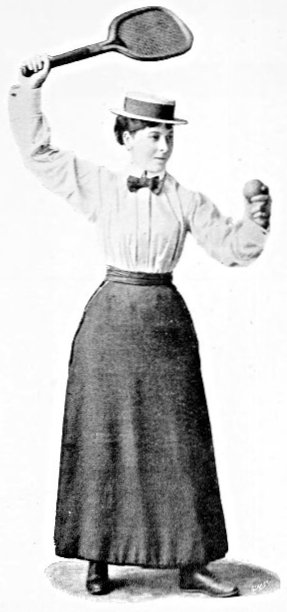
J. Weston and Son Folkestone.
MISS MAUD MARSHALL.
(Figure B. Overhand Service.)
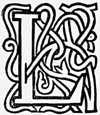
Lawn-tennis, though still in its youth, may with some justice lay claim through its prototypes, Longue paume, Pallone, Tennis, etc., to an illustrious ancestry; the connection between the modern and the older games being sufficient to establish a relationship. It is not necessary here to trace this connection step by step, beginning perchance with the game which Louis X. of France played in the forest of Vincennes to the championship fought out on the Wimbledon Club grounds in 1897. The greater part of such a history would of necessity belong to tennis proper, which, as we know, has been a popular English game for many ages. So in the 15th century we hear of a tennis court at Windsor Castle, and the present one at Hampton Court was originally built by Henry VIII., in whose reign it was that Sir Thomas More, in his "Utopia," stigmatised tennis along[Pg 314] with "dice, cards, tables, bowls and quoits" as "a naughty and unlawful game."
The first authentic record we have of lawn-tennis as we know it dates back no further than 1874, when Major Wingfield patented a certain pastime by him named "Sphairistike." It was not I believe claimed to be an invention, but merely an adaptation of a sport almost as old as the world itself. A sub-committee of the Marylebone Cricket Club was asked in 1875 to bring order into chaos, everyone for the twelve months of its existence having chosen to play "Sphairistike," or lawn-tennis, as it was now called, as it best pleased them. A code was drawn up, issued and quickly superseded, but at least there was a recognised length and breadth of court and height of net, which prior to this, as I have said, depended entirely upon the taste of the players. In 1875 lawn-tennis took up its headquarters at Wimbledon, being admitted to form part of the "All England Croquet Club" there. The game was introduced at Prince's Club in the same year. In 1876 tennis scoring was adopted, and it was the general opinion that lawn-tennis had come to stay. In the following year the "All England Croquet Club" determined to include the name[Pg 315] of the new game in its title, and it became known as the "All England Croquet and Lawn-Tennis Club." In another twelve or eighteen months the visitor had pushed the host out of house and home, the club becoming henceforth headquarters of lawn-tennis alone.
It was in the July of 1877 that the first lawn-tennis championship meeting was held at Wimbledon, a silver challenge cup being offered for competition by the proprietors of The Field. There were twenty-two entries, Mr. Spencer-Gore carrying off the championship and the all-comers prizes. The principal results of the first tournament was to show up a serious defect, viz.: the great preponderance of games won by the server against those gained by the striker-out; the proportion being about five to three. This defect was remedied in 1878 by bringing the service line four feet nearer the net, from twenty-six feet to twenty-two feet. The net at the same time was lowered from five feet at the posts to four feet nine inches, and from three feet three inches at the centre to three feet. In 1879 two more championships were instituted, those of the Oxford University Lawn-Tennis Club, and of Ireland. The latter meeting was of particular importance to lady[Pg 316] players, owing to the fact that it was their first competition ground. This pioneer of women's lawn-tennis championships was carried off by Miss M. Langrishe, who was also successful in securing the Irish prize in 1883 and 1886. The first occasion on which ladies competed at Wimbledon was in the year 1884, when Miss M. Watson secured the All England Championship, to which she joined the double victory of Ireland, where she defeated Miss M. Langrishe.
In 1885 the manager of the Buxton Tournament instituted a ladies' double championship, carried off by Mrs. Watts and Miss Bracewell. The championship of England and Ireland was again held by Miss M. Watson. It was during this year that Miss L. Dod first began to be known in the front ranks of lady players, though it was not until 1887 that she held the championship of England and Ireland, since when she has held the English Championship four times. In 1886 Miss Bingley, now Mrs. Hillyard, shot to the fore, defeating Miss Watson at Wimbledon. Her victory, though coming as something of a surprise, was magnificently earned, her extreme accuracy and power creating a good deal of enthusiasm.
The next epoch of importance in ladies' tennis—and the last possible variation of the game—was the institution, in 1888, of the "All England Mixed Doubles Championship," won by Mr. E. Renshaw and Mrs. Hillyard. During the same year the "Lawn-Tennis Association" came into existence, the want having for long been felt of one recognised authority, under whose rules all championship matches should be played. In 1890, the Association made important alterations in some of the previously recognised laws. The change of sides under the new regime was fixed at the end of the first, third and every alternate game of the set, instead of at the end of each game. Bisques were abolished, and the quarter system of receiving odds was instituted, more of which hereafter. Subsequently the distance of the service line from the net was fixed at 21-ft., and the height of the net at 3-ft. 6-in. at the posts, and 3-ft. at the centre.
The strides made in lawn-tennis since its first institution as a game are remarkable indeed, when we consider that the first and only tournament in the land was held in 1877, and that in 1897, the list of tournament dates issued by the Lawn-Tennis Association comprised sixty-two[Pg 318] fixtures in the United Kingdom, and seven on the Continent. I must not forget to add that in 1885, the first Covered Court Championship was held, Mr. Lawford carrying off the prize. The Ladies' Covered Court Championship was not inaugurated till 1890, when Miss Jacks secured the coveted title, Miss Austin being the holder in 1897.
The Ladies' Championship of 1897, was very closely contested, Mrs. Hillyard playing Miss C. Cooper (the holder). The first set was won by the latter lady, but owing to the severity of Mrs. Hillyard's returns, Miss Cooper was unable to maintain her advantage and was finally beaten, the sets standing at 5-7, 7-5, 6-2. Mrs. Hillyard also carried off the Ladies' Singles, defeating Mrs. Pickering by two sets to love—6-2, 7-5. The Irish Championship was also gained by the Wimbledon victor, who beat the Irish candidate, Miss Dyas, by two sets to one—7-5, 2-6, 6-3,—thus proving herself the best lady player of the year.
With many lawn-tennis players the choice of a court is unfortunately apt to exemplify the old saying that "the coat must be cut according to the cloth," though in these days of plenty when every town in the United Kingdom possesses at[Pg 319] least one lawn-tennis club, it should not be so difficult to secure the best advantages for practice. It is a different matter of course with a private court, the formation of which may, for many reasons be a difficult task; though the advantages of a ground upon the premises is too obvious to need demonstration. In the first place the court should be chosen lengthways from N. to S., to provide for obtaining the best possible light; secondly, if the process of levelling cannot be indulged in, let the ground chosen be at least as level as possible; and thirdly, let my foregoing remark apply equally to drainage. The absence of any obstacles such as overhanging branches, or the too close proximity of shrubs, is also to be carefully thought of, and avoided. An ample margin all round being allowed for, according to the first "recommendation" in the handbook of the Lawn-Tennis Association. "There should be, if possible, a clear margin of at least 12-ft. on each side, and 21-ft. at each end of the court."
The preparation of the court should be, as far as possible, the player's individual care. Even when the turf is coarse or weed grown to begin with, the careful application of a mowing ma[Pg 320]chine, a roller and a knife, will soon work wonders. Should plantains prevail, cut them off close to the soil, whenever they appear—I have known a promising court spoilt by an attempt to dig these weeds out, root and all, with the result that when play commenced, the balls shot at obtuse and unexpected angles. The mowing machine and the roller must be kept in constant use, the former should do its work every day if necessary, after the grass has finished growing, during the process once a week will be sufficient—this, perhaps, is more applicable when grass has been sown. Old turf should never be allowed to look even slightly ragged. The energetic use of a roller helps the grass roots to spread out and obtain the mastery over the decapitated weeds.
I quote from the Lawn-Tennis Association handbook for the dimensions of the court.
Law 1. "For the single-handed game, the court is 27-ft. in width, and 78-ft. in length. It is divided across the middle with a net, the ends of which are attached to two posts, which stand 3-ft. outside the court on each side. The height of the net is 3-ft. 6-in. at the posts, and 3-ft. at the centre. At each end of the court, parallel with the net, and at a distance of 39-ft.[Pg 321] from it, are drawn the base-lines, the extremities of which are connected by the side-lines. Half-way between the side-lines and parallel with them, is drawn the half-court-line, dividing the space on each side of the net into two equal parts, and called the right and left courts. On each side of the net, at a distance of 21-ft. from it, and parallel with it, are drawn the service-lines."
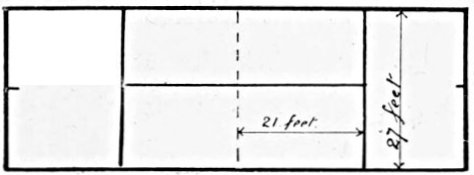
Single Court.
78 feet.
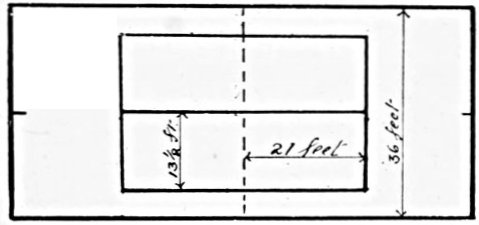
Double Court.
When a double court is required, the base-lines must be prolonged 4-ft. 6-in. in each direc[Pg 322]tion, when by joining the four new points, the side-lines of a double court are obtained; it will not now be necessary to prolong the inner side-lines further than the service lines.
The measuring of a court is always apt to be tedious work, but with a little method, a measuring tape, a reel of stout string, some small wooden pegs and a fair supply of patience, the difficulties are soon overcome. The first necessity is to fix the posts in position—I have always found it simplified matters to represent the net by a piece of string from post to post—then measure off a distance of 3-ft. from each, inwards of course. From the point now obtained, measure the side-lines, 78-ft. which gives us 39-ft. each way from the posts. From the side-lines now measure 4½-ft. inwards, and 21-ft. each way from the net string for the service-lines. It now only remains for these lines to be joined along their base by four others running parallel with the net, two on each side of it, respectively termed the base-lines and the service-lines. Half-way between the service-lines and parallel with the side-lines, a line is next drawn to form the half-court-line, which accomplishes the task. Each point as it is measured should be marked off with a[Pg 323] peg; then when all the dimensions are taken, a piece of string should be pulled taut from peg to peg, serving as guide to the marker. As a last word on the subject, I may say that I have never heard a low price in markers, nets, posts, or indeed in any implement of the game, recommended as being really economical.
As to balls they can be obtained in many makes, but "Ayre's Championship" stand first in the list of excellence. By the laws of the Lawn Tennis Association the weight of a ball shall be not less than 1-1/8-oz., or more than 2-oz. In 1877, the year of the first Championship, the minimum weight was 1¼-oz., and the maximum 1½-oz.
The Racket. On the fortunate choice of a racket, depends literally at least half the success or failure of any battle fought with it. Writing of rackets, Mr. C. A. Heathcote says: "The essential points are—a good hoop, free from knots, with a well-marked and continuous grain, plain wooden handle, round or slightly octagonal, fitting the hand of the player, attached to the middle piece without any perceptible interval, and good strong gut."[7] It is an essential point[Pg 324] that the racket should not be too heavy; on the other hand an over-light racket is far from desirable, except perhaps for a volleying game. From 12 to 13-oz. is usually considered a good weight range for a lady's racket, though I have frequently met with ladies who never touched anything under 14-oz. Indeed, in a matter of this sort, the choice must rest very much with the player herself, who will soon find from experience what weight suits her best. And so long as she confines her selection to the first makes, she cannot go very far wrong.
Scoring. The only satisfactory manner in which lawn-tennis scoring can be dealt with on paper, is by quoting once more from the laws of the Lawn-Tennis Association, thus:
Law 21. On either player winning his first stroke, the score is called 15 for that player, on either player winning his second stroke, the score is called 30 for that player; on either player winning his third stroke, the score is called 40 for that player; and the fourth stroke won by either player is scored game for that player, except as below:
If both players have won three strokes, the score is called deuce, and the next stroke won[Pg 325] by either player is called advantage for that player. If the same player win the next stroke, he wins the game; if he lose the next stroke the score is again called deuce, and so on until either player win the two strokes immediately following the score at deuce, when the game is scored for that player.
Law 22. The player who first wins six games wins a set, except as below:
If both players win five games, the score is called games-all, and the next game won by either player is scored advantage-game for that player. If the same player win the next game, he wins the set; if he lose the next game, the score is again called games-all; and so on until either player wins the two games immediately following the score of games-all, when he wins the set.
Note. Players may agree not to play advantage sets, but to decide the set by one game after arriving at the score of games-all.
Odds. In the year 1888, bisques—which had been borrowed from tennis—were abolished. A bisque is one stroke which may be claimed at any time during a set. The principal disadvantage of this system lay in the difficulty of[Pg 326] employing it judiciously, thereby causing a certain mental strain, possibly injurious to the player's form. The bisque gave place to the "quarter" and the "perfect" systems, which in their turn were superseded by the "sixth system" in 1894, now in universal use. Roughly, the sixth system of handicapping is to receive odds of one, two, three, four, or five strokes in every six games of a set; each given stroke being respectively described as one-sixth, two-sixths, three-sixths, four-sixths, five-sixths, fifteen. For complete and detailed tables of the system of handicapping, the reader is referred to the handbook of the Lawn-Tennis Association.
On the subject of suitable clothing much might be
written. For any form of outdoor exercise, the
two chief requisites of costume are warmth and
lightness. A thin flannel shirt is more useful
than anything, worn with a short light skirt. I
have seen such terrible and distressing results
arise from the wearing of skirts which, though
short in front, dropped at the back that I cannot
too strongly emphasise the need for all-round
shortness; loss of temper and dignity being among
the lesser evils accruing from neglect of this particular.
The shoes worn should be strong and
[Pg 327]
[Pg 328]
[Pg 329]serviceable, usefulness never being allowed to give
way to the merely ornamental; but now-a-days
it is an easy matter to combine the two qualities.
For play in damp weather it is permissible to
wear shoes with a leather sole into which short
nails, known as steel points, are fitted. These
are allowed on all grounds. In the matter of
hats a straw sailor with a widish brim is the most
workmanlike form of head gear possible. It is
perhaps scarcely necessary to add that perfect
looseness of every garment is a sine quâ non for
the freedom of movement necessary in lawn-tennis.
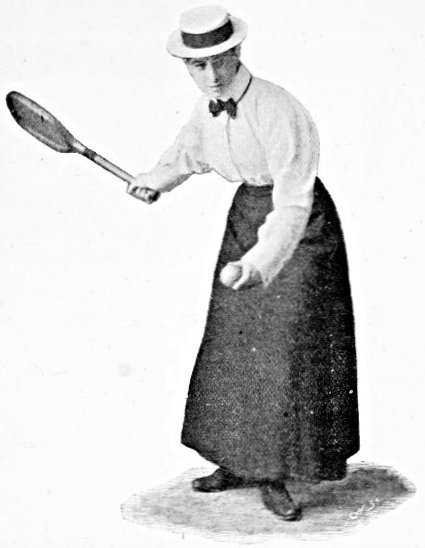
Figure A.
UNDER-HAND SERVICE.
Good form is as much an essential in the pursuit of any sport or pastime as it is in the manners and usages of polite society, and the cultivation of style is not an achievement purely confined to the wayfarer in the paths of literature. In lawn-tennis, as in everything else, a good beginning makes a good noontide; and really, when one comes to think about it, it is as easy to learn well as badly. Therefore it is never advisable for a beginner to be content with another beginner as her opponent. No doubt a certain diffidence may be felt by the inexperienced player in throwing down the gauntlet to a more practised hand, because of the lack of interest and excitement for[Pg 330] the latter in the game. But this consideration should never be allowed to deter the seizing of an opportunity of playing against an opponent from whom something may be learnt. There are plenty of good-natured people in the world, and an ounce of practical demonstration, is worth a ton's weight of written explanation as to the different actions necessary for playing the varied strokes, which go to compose the game of lawn-tennis.
Service. Like everything else worth having, a good service is extremely difficult to acquire. It is always best to ascertain by experiment and observation what particular style of service would seem most within one's power of attainment, and this style should be kept to. There is nothing more detrimental to good play than indecision or constant change of form. Experiments, though doubtless necessary at first, should be discontinued as soon as possible.
The majority of ladies, for a variety of reasons, prefer to serve underhand. Miss L. Dod, in her able contribution in the Badminton Library, is of the opinion that unless in exceptional cases, overhand service tends merely to a waste of strength without making the stroke more difficult to take[Pg 331] than the ordinary underhand service.[8] In the face of such competent authority it would be fatuous to advance a contrary opinion; but if any special aptitude is felt for the overhand service, it will probably be found easier to practice with success than the underhand.
The server should stand either in the middle of the base-line, or a few feet to the right or left of it, though she is at liberty to take up any position on the base-line that she chooses. According to Law 7 of the game: "The server should stand with one foot beyond—i.e., further from the net than—the base-line, and with the other foot upon the base-line, and shall deliver the service from the right and left courts alternately, beginning from the right. This law is of great importance and should never, even in the most ordinary play, be disregarded. For the underhand service, the body should be slightly bent and the racket swung well up. I have seen the swing carried high above the right shoulder, the ball being dropped in front of the racket as it arrives near the middle of the downward stroke (Fig. A). In the overhand service, the body should be inclined somewhat backward, and the racket brought well[Pg 332] above the head (as in Fig. B) to obtain the utmost possible reach. The ball is held somewhat below the level of the left shoulder, and thrown gently in front of the descending racket. Before a great degree of swiftness is attempted in either of these two services, accuracy should be ensured. In fact a well-known saying might be profitably adapted for the use of lawn-tennis players, both proficient and non-proficient: "Take care of accuracy, and brilliancy will take care of itself."
For the purpose of training the eye, it is no bad device to place a ball on the spot where the service is intended to drop and take aim at it. The satisfaction of hitting the mark will not be frequent, but the practice will at least impart some idea of locality. In service when one fault has already been made, it is wonderfully easy to drop into the bad habit of sending an easy catch to represent the second stroke; neither is this reprehensible custom entirely confined to beginners who might, perhaps, be excused for exercising a certain amount of caution over their last chance. Over and over again I have seen ladies, who did not by any means count themselves tyros, indulging in this defective style of play. They appear to think that one ball either[Pg 333] "smashed" into the net, or sent a dozen yards out of court absolves them from further effort; their second stroke being as harmfully innocuous as their first was mistakenly vicious. And in this case again, nothing but practice will give equality. To obtain a twist the ball should be struck first with the left side of the racket—which will be held in a more horizontal position than for the regular forward stroke—and as it were run across its face, or in other words the racket is twisted round the ball from right to left.
To receive a service the striker-out should, generally speaking, stand near the base-line, opposite the centre of the service court, a position which commands either a fore or back-handed stroke. Of course her position must naturally depend upon the style of service given, and here again, nothing but experience will impart the intuitive consciousness of the exact spot on which the ball is likely to drop. Through excess of zeal and over anxiety to make a correct return, the non-proficient player will nearly always commit the error of rushing at her stroke and hitting the ball while it is yet rising, instead of waiting to catch it in the fall and lift it with a nearly[Pg 334] vertical racket over the net. The ball should so to speak be allowed to meet the player half way for an ordinary stroke. Of course in the case of a cut or a screw, which may bound backwards instead of forwards, it is advisable to approach the stroke more closely, but even in such a case it is better to wait and see the angle of rising before striking. Any undue hurry will cause the ball to perform the feat known as "going through the racket." For the fore-handed stroke, the racket should be held in a firm grasp (as in Fig. C), great care being taken that the position of the fingers is correct from the first, the ball being struck with a full racket. For the back-handed stroke, the grip is changed (see Fig. D). This change may at first appear a serious difficulty, but after a little practice at fore and back-handed strokes alternately, the change will become both unconscious and mechanical.
The back-handed stroke is a weak point with
many players, for which reason extra attention
should be bestowed upon its cultivation. Any
attempt to run round the ball, or to take it "with
both hands," should from the first be severely
discouraged. Practising for the back-handed
stroke against a blank wall is advised by many
[Pg 335]
[Pg 336]
[Pg 337]competent authorities as a useful means of overcoming
preliminary awkwardness.
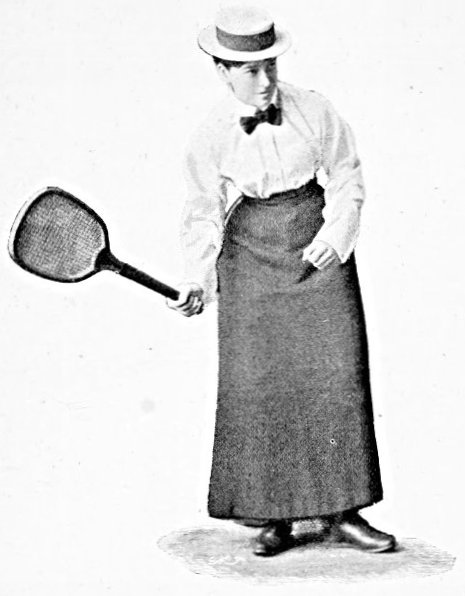
Figure C.
FORE-HANDED STROKE.
The position of the feet and body in lawn-tennis is of the utmost importance. The player should await her stroke standing facing the net with the feet a little apart, and the weight of the body resting on the toes. In the case of a fore-hand stroke the left foot should be brought quickly across the right, by way of turning the body sideways, while the racket is swung back in readiness to receive the stroke. When the ball is struck, the weight of the body is shifted from the right foot to the left. For a back-handed stroke the right foot is brought across the left, and whilst striking the weight is shifted from the left foot to the right. The Volley has ever been a subject of controversy in lawn-tennis annals. We all know what an instrument of defence the stroke became off the rackets of the Messrs. Renshaw; but at present we are considering lawn-tennis from a woman's point of view, which is a very different thing. The ordinary variety of the volley is employed to save change of position necessary in taking a ball off the ground. This stroke resembles a "lob," and should be so placed as to obviate the chance of punishment. The volley from the net is an over[Pg 338]hand stroke and may be played with either a bent or extended arm, according to the force employed. The latter variety, known as the "smash," is given with an uncontrolled swing of the racket. In the former stroke, where the force used is not so great, an excellent effect may be obtained by a quick turn of the wrist, either to right or left, at the moment of striking the ball, causing it to drop near the base of the side line. The volley from the service line is played with a horizontal racket, which may be held either below the bend of the shoulder, or almost close to the ground, when the player is obliged to stoop for the purpose of "lifting" the ball over the net.
The half volley is a stroke as difficult to attain
as to describe. Briefly it consists in blocking the
ball—roughly speaking—within the first half-foot
of its rise from the drop. The difficulty of
the stroke lies in estimating correctly the exact
spot on which the ball will drop, and in having
the racket ready just behind that spot. The stroke
is chiefly used in cases where retreat is impossible,
or at least likely to be attended with ill-success,
and when the reach is too short for a volley;
but it is a stroke which should be indulged in
with caution, as, unless in the case of exception[Pg 339]
[Pg 340]
[Pg 341]ally
good players, it is likely to prove a dismal
failure. That it can generally be dispensed with
by either a step forward, or a few steps back is
consoling to the medium performer.
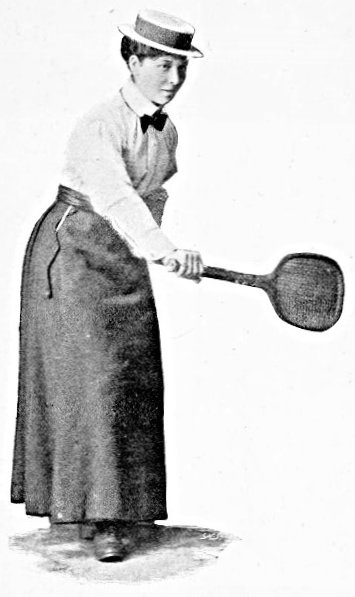
Figure D.
BACK-HANDED STROKE.
The "Lob" claims Mr. Haslow as its discoverer. This gentleman, chiefly owing to the agency of the stroke, succeeded in defeating the champion, Mr. Spencer-Gore, who first practised volleying tactics, in 1878. The "lob" is a useful invention against net play, being merely a stroke lifted high over the opponent's head, thus preventing a volleying return. The counter tactics to this stroke are technically known as the "smash," to which reference has already been made, and the "lob volley." The former of these two strokes consists in getting the racket—either by reach or springing into the air—above the ball and smashing it with all the strength at the player's command, to the confusion of the opponent, and the alarm and consternation of the bye-standers. The "lob" volley consists in catching the dropping ball with a vertical drive similar to the ordinary forward drive played off the ground.
Lady players will, as a general rule, find the back game quite as effective, and a good deal more graceful than forward or volleying tactics,[Pg 342] which owing to various circumstances, such as the necessity for extra reach and freedom of movement—are more suited to a man's play than a woman's. The back game with the aid of judicious "placing" will always prove hard to beat, a few well-worn maxims for its successful issue being: to hit as hard, and to keep the ball as low as possible. Neither to court nor to avoid volleying, but to take it as it comes. To thoroughly master the art of "placing." Never to relax good style by slovenly play, and finally to follow in all cases the advice of a well-known authority, "To start at once, to arrive in time, and never to be in a hurry."
M. Marshall.
[7] Lawn-Tennis, Chap. VII. Badminton Library. C. E. Heathcote.
[8] Lawn-tennis, Chap. XVI., Badminton Library.
Abeam: Said of an object that is in a line at right angles from the centre of a vessel's side.
About: The act of a vessel going from one tack to the other, when working to windward.
Abreast: Beam and beam; abeam. Two ships are said to be abreast when alongside of each other.
A-lee: The situation of the tiller or helm when it is put down or to leeward, when going about, or luffing.
All in the wind: When a vessel's sails are shaking from sailing too near the wind.
A-weather: The opposite of a-lee. The helm is a-weather when "put up" in the direction of the wind to bear away for "gybing," "wearing," or merely to alter course and keep a point or so more off the wind.
To back a sail: To bring the sail round so that the wind comes on its other side.
Backstays: Large ropes used to support the masts. They come aft either side of the ship from the masthead.
Balloon foresail or fore staysail: An enormous sail set on the forestay of cutters and schooners, and used for close-hauled sailing in light weather.
Balloon-jib: An enormous jib made of light canvas carried by fore-and-aft rigged craft; the foot extends[Pg 346] from the bowsprit end to the fore-rigging. It is used when sailing from one to eight or nine points free.
Balloon-Topsail: A square-headed gaff topsail of very large proportions, set with a yard and a jack-yard at clew; to the latter the sheet is bent.
Battens: Strips of wood let into the mast to prevent its wearing. Strips of wood put round hatches over tarpaulins to keep the latter down. A batten of wood is also used for several purposes on a vessel's rigging. A thin splint of wood used by naval architects for making curved lines.
Beam: The breadth of a ship. The midship side of a ship. Abaft the beam is behind the centre of the ship's side, and forward of the beam is in front of that centre. See also "Abeam."
Bear away: To put the helm up and cause the vessel's head to go off the wind.
Beating to windward: Making for a point to windward by short tacks.
Belay: To make a rope fast to a pin or cavel, without hitching or seizing. "Belay there!" Stop hauling, and make fast.
Bend: To attach a sail to a yard. To bend a cable is to attach it to an anchor. A knot by which two ropes are fastened together.
Bight: The loop of a rope when doubled.
Bilge-pieces: Placed on a vessel's side to support her when grounding.
Blanketing: A slang term, used when one vessel covers or becalms another with her sails.
Board: The distance a vessel traverses before tacking[Pg 347] when working to windward. To make a "sternboard" is to make way by the stern, as a vessel will often do in a tideway or when in irons. To go "by the board" is said of a mast when it is carried away.
Bobstay: A rope or chair with tackle and double blocks attached to the bowsprit end and stem of a vessel, and used to keep the bowsprit down when the jib is set.
Boom: The spar that extends the foot of fore-and-aft sails.
Bowline: A rope used to stretch taut the after leech of a sail when on a wind. A vessel is said to be on a bowline when close hauled.
Bowsprit: A spar that extends from the bows of a vessel. A "running" bowsprit is such as a cutter has, and is horizontal, and can be reefed at pleasure.
Brace: A rope by which a yard is worked.
Break off: A vessel when close-hauled is said to break off when the wind comes more ahead.
Bridle: Two or more ropes extending from the leech of a sail to which the bowline is attached.
Cable length: 100 fathoms, or 200 yards. A cable length denoted on a chart is 607·5 feet.
To Check-sheets: To ease them off.
Claw: To beat to windward off a lee-shore, or generally to beat to windward when such is difficult on account of heavy weather.
Cleat: A piece of wood used to belay ropes to.
Clew: The after lower corner of a fore-and-aft sail.
Clew-line: A line used to hoist up the lower corners of a sail.
Close-hauled: When a vessel's sheets are hauled so flat that she sails as near the wind as possible. A schooner yacht will sail 4½ points off the wind, and a cutter about 4¼.
Coamings: Pieces of timber forming a frame on the deck round a hatchway or skylight.
Crank: Said of a vessel when she will not stand up well to her canvas. A narrow and deep vessel is sure to be "crank."
Cross sea: A sea or swell caused by a wind different from that blowing at the time the cross sea is running.
Cross-trees: Pieces of timber supported by the trestle-trees, used to spread the topmast rigging.
Crutch: Forked pieces of timber or iron fixed into a socket of the taffrail, and used to support the boom when the mainsail is stowed.
Cuddy: A cabin under the deck, put in the fore-part of small boats.
Davits: Iron stanchions or pieces of timber fixed on a vessel's side or stern, to carry boats, they being hoisted to the davits by tackles.
Earings: Small ropes used to fasten the upper corners of sails to the yards.
Ease off, or Ease away: To slacken out the fall of a tackle, sheet, or any rope that is belayed.
Ease the helm: To put the helm down when close-hauled, so that a vessel's head may enter a sea fairly. Generally to put the helm more amidships when it has been put either to port or starboard.
Eyelet-hole: Holes in a sail through which a lacing is passed or reef nettles rove.
Fair: Said of a wind which a vessel has when she can lay her course a point or any number of points free.
Fetch: To arrive at a point when sailing to windward by weathering it.
Fly up in the wind: Said of a vessel when she comes up suddenly head to wind, by reason of her griping or through the bad steering of the helmsman.
Foot: The lower part of a sail or mast.
Fore-and-aft sails: Sails that are set on gaffs and stays, and not on yards.
Fore-reach: When close-hauled to sail ahead of another vessel. To fore-reach to windward is to sail ahead of a vessel and yet to windward of her at the same time.
Free-wind: When a vessel has the wind so as not to be close-hauled. When the wind comes abeam or on the quarter, a vessel is said to be going large. A fair wind may mean free, large, or any wind that blows between 1-2 points of the compass from the point on which the vessel would be close-hauled.
Gaskets: Ropes used to secure sails to their yards or booms when furled or stowed.
Goose-winged: Said of a schooner whose mainsail and foresail are extended on opposite sides as she runs before the wind.
Guy: A rope used to prevent a boom swinging aboard either fore or aft. In running before the wind a guy is often attached to the main boom of a schooner to prevent a sudden gybe.
Gybe: When running before the wind, to bring the wind on the other side by putting up the helm, and thereby cause the sails to fall over.
Halyards: The ropes used to hoist sails, yards, etc.
Hatches: Openings in the decks.
Haul aft a sheet: To haul a sail flatter or at a less angle to the wind.
Haul her wind: Said of a vessel going free, when she comes up closer to the wind and flattens her sheets.
Helm: Generally applied to the tiller, but properly it means the whole apparatus for steering.
Housed: The situation of a topmast that has been lowered.
In irons: A vessel is said to be in irons when in going about she comes up head to wind, and will not fill off one way or the other.
Jack-stay: A stay along a mast or yard to which a sail is bent.
Jack-yard: A small yard used to extend the foot of a fore-and-aft balloon topsail that extends beyond the end of the gaff.
Jaws: The part of a gaff or boom which encircles the mast.
Jib: A triangular sail set on a stay in square-rigged ships, and then called a standing jib.
Jib-boom: A spar that extends beyond the bowsprit. A flying jib-boom is another spar that extends beyond the jib-boom.
Jib-foresail: The fore-staysail of fore-and-aft schooners.
Jib-purchase: A tackle used for setting up a jib.
Jib-topsail: A triangular sail set on the fore-topmast stay of fore-and-aft vessels.
Jib-traveller: The travelling ring that encircles the[Pg 351] bowsprit to which the tack of a jib is secured and hauled out on the bowsprit or jib-boom, as the case may be.
Larboard: Port. (Obsolete.)
Large: A vessel is said to be going large when she has the wind three or four points free.
Leech: The outer edge of a sail.
Luff: To sail closer to the wind.
Lug-sail: A sail set on a yard, as generally used in small boats.
Main-boom: The spar that extends the foot of the mainsail of a fore-and-aft craft.
Mainsheet: The sheet of a mainsail.
Martingale: A short spar under the bowsprit, used to give more spread to the stays that set the bowsprit or jib-boom down.
Nautical mile: 2025·2 yards: thus 13 knots or nautical miles are nearly equal to 15 statute miles.
Nautical day: From noon till noon, 24 hours.
Nothing off: Said to a helmsman when he has to keep a vessel as close to wind as practicable.
Off-and-on: Working along a shore by standing off, and then on, by short boards.
Painter: A rope attached to the bows of a boat, used to make her fast to a landing-place, etc.
Preventer stays: Additional ropes set up taut to prevent spars carrying away when a vessel is under a press of canvas.
Reef-points: Short pieces of rope by which the foot of a sail is secured when a reef is rolled up, or, as the nautical term has it, hauled down.
Reef-tackles: The tackles by which the reef-pendants are hauled down.
Schooner: A fore-and-aft rigged craft with two masts. Sometimes schooners carry square topsails, and then are distinguished by being called "square-topsail schooners."
Spinnaker: A modern adaptation of a jib-shaped sail, often seen set from the top masthead and boomed out from the mast. It is made of light canvas, and hoists to the topmast-head, and is boomed out from the mast. Some cutters carry enormous spinnakers, containing in one sail nearly as much canvas as is spread in mainsail and topsail. A spinnaker is a very handy sail, and preferable to a squaresail in light weather.
Steady!: An order after the helm has been put to port or starboard, to put it no farther in either direction, but bring it back amidships. When the wind is fair, an order given to a steersman to "Steady!" is to keep the helm as it is.
Tack: The lower weather corner of a sail.
To tack: To go about from one tack to the other.
Tackle: A purchase composed of blocks and a rope, for multiplying power.
Tail block: A tackle consisting of two blocks, to one of which is attached a length of rope for fastening to any object at pleasure.
Taunt: Tall.
Taut: Tight.
Thwart: Athwart; across. The seat of a boat.
Tiller: The bar of wood or iron by which the rudder is worked.
Toggle: A pin placed through the bight or eye of a rope to secure it round a stay, mast, etc.
Top a boom: To raise one end of it by hoisting on the topping-lifts.
Topmast: The next mast to the lower mast; in ships, the topmast is succeeded by top-gallant mast and royal mast.
Wear: To come round with the wind until it blows on the opposite side. In tacking, a vessel is turned round against the wind.
Yaw: A vessel is said to yaw when in running she flies off her course.
Yawl: A vessel rigged like a cutter, with the addition of a short mizzen-mast.
1.—For the single-handed game, the Court is 27 ft. in width and 78 ft. in length. It is divided across the middle by a net, the ends of which are attached to the tops of two posts, which stand 3 ft. outside the Court on each side. The height of the net is 3 ft. 6 in. at the posts, and 3 ft. at the centre. At each end of the Court, parallel with the net, and at a distance of 39 ft. from it, are drawn the Base-lines, the extremities of which are connected by the side-lines. Half-way between the side-lines, and parallel with them, is drawn the half-court-line, dividing the space on each side of the net into two equal parts, called the right and left courts. On each side of the net, at a distance of 21 ft. from it, and parallel with it, are drawn the service-lines.
2.—The balls shall not be less than 2½ in., nor more than 2-9/16 in. in diameter; and not less than 1-7/8 oz., nor more than 2 oz. in weight.
3.—In matches where Umpires are appointed, their decision shall be final; but where a Referee is appointed, an appeal shall lie to him from the decision of an Umpire on a question of law.
4.—The choice of sides and the right of serving during the first games shall be decided by toss; provided that, if the winner of the toss choose the right to serve, the other player shall have the choice of sides, and vice-versâ; and provided that the winner of the toss may, if he prefer it, require the other player to make the first choice.
5.—The players shall stand on opposite sides of the net; the player who first delivers the ball shall be called the Server, the other the Striker-out.
6.—At the end of the first game the Striker-out shall become Server, and the Server shall become Striker-out; and so on alternately in the subsequent games of the set.
7.—The Server shall stand with one foot beyond (i.e., further from the net than) the base line, and with the other foot upon the base line, and shall deliver the service from the right and left Courts alternately, beginning from the right.
8.—The ball served must drop within the service-line, half-court-line, and side-line of the Court which is diagonally opposite to that from which it was served, or upon any such line.
9.—It is a fault if the service be delivered from the wrong Court, or if the Server do not stand as directed in Law 7, or if the ball served drop in the net or beyond the service-line, or if it drop out of Court or in the wrong Court; it is not a fault if the Server's foot, which is beyond the base-line, do not touch the ground at the moment at which the service is delivered.
10.—A fault may not be taken.
11.—After a fault, the Server shall serve again from the same Court from which he served that fault, unless it was a fault because served from the wrong Court.
12.—A fault may not be claimed after the next service has been delivered.
13.—The service may not be volleyed, i.e., taken before it touches the ground.
14.—The Server shall not serve until the Striker-out is ready. If the latter attempt to return the service, he shall be deemed to be ready.
15.—A ball is in-play from the moment at which it is delivered in service (unless a fault) until it has been volleyed by the Striker-out in his first stroke, or has dropped in the net or out of Court, or has touched either of the players or anything that he wears or carries, except his racket in the act of striking, or has been struck by either of the players with his racket more than once consecutively, or has been volleyed before it has passed over the net, or has failed to pass over the net before its first bound (except as provided in Law 17), or has touched the ground twice consecutively on either side of the net, though the second time may be out of Court.
16.—It is a let if the ball served touch the net, provided the service be otherwise good; or if a service or fault be delivered when the Striker-out is not ready; or if either player be prevented by an accident beyond his control from serving or returning the ball in play. In case of a let, the service or stroke counts for nothing, and the server shall serve again.
17.—It is a good return although the ball touch the net, or, having passed outside either post, drop on or within any of the lines which bound the Court into which it is returned.
18.—The Server wins a stroke if the Striker-out volley the service, or fail to return the service or the ball in-play (except in the case of a let), or return the service or ball in play so that it drop outside any of the lines which bound his opponent's Court, or otherwise lose a stroke, as provided by Law 20.
19.—The Striker-out wins a stroke if the Server serve two consecutive faults, or fail to return the ball in-play (except in the case of a let), or return the ball in-play so that it drop outside any of the lines which bound his opponent's Court, or otherwise lose a stroke, as provided by Law 20.
20.—Either player loses a stroke if the ball in-play touch him or anything that he wears or carries, except his racket in the act of striking; or it he touch or strike the ball in-play with his racket more than once consecutively; or if he touch the net or any of its supports while the ball is in-play; or if he volley the ball before it has passed the net.
21.—On either player winning his first stroke, the score is called 15 for that player; on either player winning his second stroke, the score is called 30 for that player; on either player winning his third stroke, the score is called 40 for that player; and the fourth stroke won by either player is scored game for that player; except as below:—
If both players have won three strokes, the score is called deuce; and the next stroke won by either player is scored advantage for that player. If the same player win the next stroke, he wins the game; if he lose the next stroke, the score is again called deuce; and so on until either player win the two strokes immediately following the score at deuce, when the game is scored for that player.
22.—The player who first wins six games wins a set; except as below:—
If both players win five games, the score is called games-all; and the next game won by either player is scored advantage-game for that player. If the same player win the next game, he wins the set; if he lose the next game, the score is again called games-all; and so on until either player win the two games immediately following the score of games-all, when he wins the set.
Note.—Players may agree not to play advantage-sets, but to decide the set by one game after arriving at the score of games-all.
23.—The players shall change sides at the end of every set, but the Umpire, on appeal from either party, before the toss for choice, shall direct the players to change sides at the end of the first, third, and every subsequent alternate game of each set, provided that in such event the players shall not change sides at the end of a set if the number of games in such set be even; but if the appeal be made after a match has been begun, the Umpire shall only direct the players to change sides at the end of the first, third, and every subsequent alternate game of the odd and concluding set.
24.—When a series of sets is played, the player who was Server in the last game of one set, shall be Striker-out in the first game of the next.
25.—In the case of received odds:—
a. One sixth of fifteen is one stroke given in every six games of a set in the position shown by the annexed table.
b. Similarly, two-sixths, three-sixths, four-sixths, and five-sixths of fifteen are respectively two, three, four, and five strokes given in every six games of a set in the position shown by the table.
| 1st Game. | 2nd Game. | 3rd Game. | 4th Game. | 5th Game. | 6th Game. | |
|---|---|---|---|---|---|---|
| 1/6 of 15. | 0 | 15 | 0 | 0 | 0 | 0 |
| 2/6 of 15. | 0 | 15 | 0 | 15 | 0 | 0 |
| 3/6 of 15. | 0 | 15 | 0 | 15 | 0 | 15 |
| 4/6 of 15. | 0 | 15 | 0 | 15 | 15 | 15 |
| 5/6 of 15. | 0 | 15 | 15 | 15 | 15 | 15 |
Example.—A player receiving four-sixths of fifteen receives nothing in the first and third games, and fifteen in the second, fourth, fifth and sixth games of a set.
Note.—The table is not carried beyond the sixth game, as in the next and every succeeding six games the odds recur in the same positions.
c. The above odds may be given in augmentation of other receiving odds.
d. Fifteen is one stroke given at the beginning of every game of a set.
e. Thirty is two strokes given at the beginning of every game of a set.
f. Forty is three strokes given at the beginning of every game of a set.
26.—In the case of owed odds:
a. One-sixth of fifteen is one stroke owed in every six games of a set in the position shown by the annexed table.
b. Similarly, two-sixths, three-sixths, four-sixths, and five-sixths of fifteen are respectively two, three, four, and five strokes owed in every six games of a set in the position shown by the following table:
| 1st Game. | 2nd Game. | 3rd Game. | 4th Game. | 5th Game. | 6th Game. | |
|---|---|---|---|---|---|---|
| 1/6 of 15. | 15 | 0 | 0 | 0 | 0 | 0 |
| 2/6 of 15. | 15 | 0 | 15 | 0 | 0 | 0 |
| 3/6 of 15. | 15 | 0 | 15 | 0 | 15 | 0 |
| 4/6 of 15. | 15 | 0 | 15 | 0 | 15 | 15 |
| 5/6 of 15. | 15 | 0 | 15 | 15 | 15 | 15 |
Example.—A player owing two-sixths of fifteen would owe fifteen in the first and third games, and nothing in the second, fourth, fifth, and sixth games.
Note.—The table is not carried beyond the sixth game, as in the next and every succeeding six games the odds recur in the same positions.
c. The above odds may be owed in augmentation of other owed odds.
d. Fifteen is one stroke owed at the beginning of every game of a set.
e. Thirty is two strokes owed at the beginning of every game of a set.
f. Forty is three strokes owed at the beginning of every game of a set.
27.—The above laws shall apply to the three-handed and four-handed games, except as below.
28.—For the three-handed and four-handed games, the Court is 36 ft. in width. Within the side-lines, at a distance of 4½ ft. from them, and parallel with them, are drawn the service-side-lines. In other respects the Court is similar to that which is described in Law 1.
29.—In the three-handed game, the single player shall serve in every alternate game.
30.—In the four-handed game, the pair who have the right to serve in the first game may decide which partner shall do so, and the opposing pair may decide similarly for the second game. The partner of the player who served in the first game shall serve in the third; and the partner of the player who served in the second game shall serve in the fourth, and so on in the same order in all the subsequent games of a set.
31.—The players shall take the service alternately throughout each game; no player shall receive or return a service delivered to his partner; and the order of service and of striking out, once arranged, shall not be altered, nor shall the Striker-out change Courts to receive the service before the end of the set.
32.—The ball served must drop within the service-line, half-court-line, and service-side-line of the Court, which is diagonally opposite to that from which it was served, or upon any such line.
33.—It is a fault if the ball do not drop as provided in Law 32, or if it touch the Server's partner, or anything that he wears or carries.
34.—If a player serve out of his turn, the Umpire, as soon as the mistake is discovered by himself or by one of the players, shall direct the player to serve who ought to have served; but all strokes scored, and any fault served before such discovery, shall be reckoned. If a game shall have been completed before such discovery, then the[Pg 360] service in the next alternate game shall be delivered by the partner of the player who served out of his turn; and so on in regular rotation.
(Revised and approved by the Council of the Lawn-Tennis Association.)
1.—In no case may the Striker-out volley the service, not even if the ball is clearly outside the service court.
2.—A player who is struck by, or strikes a ball in play (unless he thereby makes a good return) loses the stroke, no matter whether he is standing within the limits of the court or outside them. (For definition of "in play" see Law 15.)
3.—If the service is delivered before the Striker-out is ready, and he tries to return it, but fails, he loses the stroke.
4.—If the Striker-out cries "not ready" after the service has been delivered, but before the ball touches the ground, he may not claim a fault because the ball ultimately drops outside the service Court.
5.—If the Server, in attempting to serve, misses the ball altogether, it does not count as a fault, but it the ball is touched, no matter how slightly, by the racket, a service is thereby delivered and the rules governing the service at once apply.
6.—If a ball, served or returned, drops into the proper Court and screws or is blown back over the net, the player whose turn it is to strike may reach over the net and play the ball, provided that neither he nor any part of his clothes or racket touch the net. If he fails to play the ball, the stroke of course scores to his opponent, notwithstanding that the ball has gone back over the net.
7.—If a player throws his racket at the ball and so returns the ball into the proper Court, he loses the stroke.
8.—If a player catches the balls on his racket, walks with it to the net, and, reaching over, drops it into Court, he loses the stroke, as such a proceeding cannot be defined as an "act of striking" (vide law 15).
9.—If a player's racket passes over the net after he has returned the ball, he does not lose, providing the ball has passed over the net before being played, and has been properly returned.
10.—If a player or his racket touches the posts or supports of the net or posts while the ball is in-play, he loses the stroke. (For definition of "in-play" see law 15.)
II.—If a player's racket slips out of his hand and touches the net while the ball is in-play, he loses the stroke.
12.—If a player to avoid touching the net, jumps over it while the ball is in play, he loses the stroke.
13.—If a ball is returned outside the posts, either above or below the level of the top of the net, and drops into Court, it is a good return.
14.—If a player succeeds in returning a ball served or in-play which strikes a ball lying in the Court, it is a good return.
15.—If a spectator impedes, or in any way interferes with, a player, a "let" may be allowed under Law 16.
16.—A "let" does not annul a previous fault.
17.—The service always commences from the right-hand Court, even though odds are given or owed, and the service always continues alternately from the right and left Courts.
18.—If an Umpire erroneously calls "fault" and at once corrects himself and cries "play," and the striker-out tails to return the ball, a "let" must be allowed.
19.—If the ball in play (other than a service) strikes any part of the net or its supports, or the centre stay, no matter how low down (provided it does not touch the ground), and eventually goes over into the proper Court, it is a good return.
20.—If in a double game the Server's service strikes either of his opponents, he wins the stroke.
21.—If a match is postponed on account of rain or darkness coming on, or for any similar reason, and is continued on the subsequent day, the match shall be resumed from the point where it was discontinued on the previous day. An entirely new commencement may only be made with the consent of the Referee.
22.—If two players in a handicap play at the wrong odds, the match stands, unless they have been wrongly instructed by the referee, or any person or persons acting under his instructions, in which case the loser may claim to have the match replayed, unless the mistake in the odds has been in his favour. Such claim must be made within a reasonable time.
23.—A similar decision must be given if two players neglect to play advantage sets when one of the conditions of the event in which they are competing is that advantage sets should be played.
When two players, both in receipt of odds, meet, the player receiving the smaller odds is put back to scratch. The following Table shows the point at which the other should then start. The number at the left of the horizontal columns denotes the player who goes back to scratch, those at the head of the vertical columns the player who still receives odds; and the numbers within the columns show the odds to be received by the player whose number stands at the head of the column:
| 1 | 2 | 3 | 4 | 5 | 6 | 7 | 8 | 9 | 10 | 11 | 12 | 13 | 14 | 15 | 16 | 17 | 18 |
|---|---|---|---|---|---|---|---|---|---|---|---|---|---|---|---|---|---|
| 1/6 of 15 | 2/6 of 15 | 3/6 of 15 | 4/6 of 15 | 5/6 of 15 | 15· | 15·1 | 15·2 | 15·3 | 15·4 | 15·5 | 30· | 30·1 | 30·2 | 30·3 | 30·4 | 30·5 | 40· |
| 1 | 1/6 of 15 | 2/6 of 15 | 2/6 of 15 | 4/6 of 15 | 5/6 of 15 | 15· | 15·1 | 15·2 | 15·3 | 15·4 | 15·5 | 30· | 30·1 | 30·2 | 30·3 | 30·5 | 40· |
| 2 | 1/6 of 15 | 1/6 of 15 | 3/6 of 15 | 5/6 of 15 | 15· | 15· | 15·1 | 15·2 | 15·4 | 15·5 | 30· | 30·1 | 30·2 | 30·3 | 30·4 | 30·5 | |
| 3 | 1/6 of 15 | 2/6 of 15 | 4/6 of 15 | 5/6 of 15 | 15· | 15·1 | 15·1 | 15·3 | 15·4 | 30· | 30· | 30·1 | 30·2 | 30·4 | 30·5 | ||
| 4 | 1/6 of 15 | 3/6 of 15 | 4/6 of 15 | 5/6 of 15 | 15· | 15·1 | 15·2 | 15·4 | 15·5 | 30· | 30·1 | 30·2 | 30·3 | 30·5 | |||
| 5 | 1/6 of 15 | 3/6 of 15 | 4/6 of 15 | 5/6 of 15 | 15· | 15·1 | 15·3 | 15·5 | 15·5 | 30· | 30·1 | 30·2 | 30·4 | ||||
| 6 | 1/6 of 15 | 3/6 of 15 | 4/6 of 15 | 5/6 of 15 | 15· | 15·1 | 15·3 | 15·5 | 15·5 | 30· | 30·1 | 30·4 | |||||
| 7 | 1/6 of 15 | 2/6 of 15 | 4/6 of 15 | 5/6 of 15 | 15· | 15·2 | 15·4 | 15·5 | 30· | 30·1 | 30·3 | ||||||
| 8 | 1/6 of 15 | 2/6 of 15 | 4/6 of 15 | 15· | 15·1 | 15·2 | 15·4 | 15·5 | 30· | 30·2 | |||||||
| 9 | 1/6 of 15 | 3/6 of 15 | 5/6 of 15 | 15· | 15·2 | 15·3 | 15·4 | 30· | 30·1 | ||||||||
| 10 | 1/6 of 15 | 4/6 of 15 | 15· | 15·1 | 15·2 | 15·3 | 15·5 | 30·1 | |||||||||
| 11 | 2/6 of 15 | 4/6 of 15 | 15· | 15·1 | 15·2 | 15·4 | 30· | ||||||||||
| 12 | 2/6 of 15 | 4/6 of 15 | 5/6 of 15 | 15· | 15·2 | 15·5 | |||||||||||
| 13 | 2/6 of 15 | 3/6 of 15 | 5/6 of 15 | 15·1 | 15·3 | ||||||||||||
| 14 | 1/6 of 15 | 3/6 of 15 | 5/6 of 15 | 15·2 | |||||||||||||
| 15 | 1/6 of 15 | 4/6 of 15 | 15·1 | ||||||||||||||
| 16 | 2/6 of 15 | 15· | |||||||||||||||
| 17 | 5/6 of 15 | ||||||||||||||||
This table has been calculated upon the following data:—
| In the case of received odds | ||
|---|---|---|
| The average | value of | 1/6 is ·2048. |
| " | " | 2/6 is ·3552. |
| " | " | 3/6 is ·4811. |
| " | " | 4/6 is ·6069. |
| " | " | 5/6 is ·7841. |
| " | length of a game is 4·6250 strokes. | |
| 15·1 means 15 and one-sixth of 15, and so on. | ||
When two players meet who are handicapped to owe odds, the player owing the lesser odds is placed at scratch. This Table shows the odds the other will still owe:
| 1 | 2 | 3 | 4 | 5 | 6 | 7 | 8 | 9 | 10 | 11 | 12 | 13 | 14 | 15 | 16 | 17 | 18 |
|---|---|---|---|---|---|---|---|---|---|---|---|---|---|---|---|---|---|
| 1/6 of 15 | 2/6 of 15 | 3/6 of 15 | 4/6 of 15 | 5/6 of 15 | 15· | 15·1 | 15·2 | 15·3 | 15·4 | 15·5 | 30· | 30·1 | 30·2 | 30·3 | 30·4 | 30·5 | 40· |
| 1 | 1/6 of 15 | 1/6 of 15 | 3/6 of 15 | 3/6 of 15 | 5/6 of 15 | 15· | 15·1 | 15·1 | 15·2 | 15·3 | 15·4 | 30· | 30· | 30·1 | 30·2 | 30·3 | 30·4 |
| 2 | 1/6 of 15 | 1/6 of 15 | 4/6 of 15 | 3/6 of 15 | 5/6 of 15 | 15· | 15· | 15·1 | 15·2 | 15·3 | 15·4 | 15·5 | 30· | 30· | 30·1 | 30·2 | |
| 3 | 1/6 of 15 | 2/6 of 15 | 2/6 of 15 | 4/6 of 15 | 5/6 of 15 | 15· | 15· | 15·1 | 15·2 | 15·3 | 15·4 | 15·5 | 30· | 30· | 30·1 | ||
| 4 | 1/6 of 15 | 2/6 of 15 | 3/6 of 15 | 4/6 of 15 | 5/6 of 15 | 5/6 of 15 | 15· | 15·1 | 15·2 | 15·3 | 15·4 | 15·5 | 15·5 | 30· | |||
| 5 | 1/6 of 15 | 2/6 of 15 | 3/6 of 15 | 4/6 of 15 | 5/6 of 15 | 5/6 of 15 | 15· | 15·1 | 15·2 | 15·3 | 15·3 | 15·4 | 15·5 | ||||
| 6 | 1/6 of 15 | 2/6 of 15 | 2/6 of 15 | 3/6 of 15 | 4/6 of 15 | 5/6 of 15 | 15· | 15·1 | 15·1 | 15·2 | 15·3 | 15·4 | |||||
| 7 | 1/6 of 15 | 1/6 of 15 | 2/6 of 15 | 3/6 of 15 | 4/6 of 15 | 5/6 of 15 | 15· | 15· | 15·1 | 15·1 | 15·2 | ||||||
| 8 | 0 | 1/6 of 15 | 2/6 of 15 | 3/6 of 15 | 4/6 of 15 | 5/6 of 15 | 5/6 of 15 | 15· | 15· | 15·1 | |||||||
| 9 | 0 | 1/6 of 15 | 2/6 of 15 | 3/6 of 15 | 4/6 of 15 | 5/6 of 15 | 5/6 of 15 | 15· | 15·1 | ||||||||
| 10 | 1/6 of 15 | 1/6 of 15 | 2/6 of 15 | 3/6 of 15 | 4/6 of 15 | 5/6 of 15 | 5/6 of 15 | 15· | |||||||||
| 11 | 1/6 of 15 | 1/6 of 15 | 2/6 of 15 | 3/6 of 15 | 4/6 of 15 | 4/6 of 15 | 5/6 of 15 | ||||||||||
| 12 | 1/6 of 15 | 1/6 of 15 | 2/6 of 15 | 3/6 of 15 | 3/6 of 15 | 4/6 of 15 | |||||||||||
| 13 | 1/6 of 15 | 1/6 of 15 | 1/6 of 15 | 2/6 of 15 | 3/6 of 15 | ||||||||||||
| 14 | 0 | 1/6 of 15 | 1/6 of 15 | 2/6 of 15 | |||||||||||||
| 15 | 0 | 1/6 of 15 | 2/6 of 15 | ||||||||||||||
| 16 | 0 | 1/6 of 15 | |||||||||||||||
| 17 | 1/6 of 15 | ||||||||||||||||
This table has been calculated upon the following data:—
| In the case of owed odds | ||
|---|---|---|
| The average | value of | 1/6 is ·2158 |
| " | " | 2/6 is ·3929 |
| " | " | 3/6 is ·5188 |
| " | " | 4/6 is ·6448 |
| " | " | 5/6 is ·7975 |
| " | length of a game is 4·6250 strokes. | |
In using this table, supply throughout the word "owe" before the odds specified.
1.—At Prize Meetings promoted by associations or clubs affiliated to the Lawn-Tennis Association, the laws of lawn-tennis for the time being sanctioned by the Lawn-Tennis Association, and the regulations hereinafter contained, shall be observed.
2.—All details connected with any Prize Meeting shall be settled by the Committee of the club holding the meeting, or by a Committee specially appointed for the purpose, of whom two, or such larger number as the Committee may determine, shall form a quorum.
3.—A circular shall be issued by the Committee specifying the conditions of the competition (see Recommendation 5).
4.—No cheques, orders for money, or cash payments in any form shall be given as prizes, and the amount actually paid for each prize shall in no case be below the advertised value of the same.
5.—The Committee shall elect a Referee, with power to appoint a substitute to be approved by them.
6.—The Referee, or such other member or members of the Committee as may be selected for the purpose, shall have power to appoint Umpires, and the Referee shall decide any point of law which an Umpire may profess himself unable to decide, or which may be referred to him on appeal from the decision of an Umpire.
7.—The Referee shall, during the Meeting, be ex-officio a member of the Committee.
8.—The Courts shall be allotted to the Competitors, and the Competitors shall be called upon to play, by a member or members of the Committee, to be selected for the purpose, and in case of disagreement the Committee shall decide.
9.—The Committee shall help to keep order on the ground, and shall consult and decide upon any question arising out of the competition, if summoned for that purpose by the Referee or by any two of their number; and they shall have power, when so convened, the misconduct of a Competitor having been reported to them by a member of the Committee or an Umpire, to disqualify the offender, and further to order him off the ground, should his misconduct appear to them to justify such action, but before such action shall be taken, an opportunity of offering an explanation shall be afforded to the Competitor whose misconduct has been reported to them.
10.—It is the duty of an Umpire—
a. To ascertain that the net is at the right height before the commencement of play, and to measure and adjust the net during play, if asked to do so, or if, in his opinion, its height has altered;
b. To call the faults (subject to Regulation 11);
c. To call the strokes when won, or when he is asked to call them, and to record them on the Umpire's second sheet;[9]
d. To call the games and the sets at the end of each, or when asked to call them, and to record them on the Umpire's scoring sheet;
NOTE.—At the end of each game the games should be called with the name of the player who is in advance, thus: "2 games to 1, B. wins," or "B. leads." If the games are level the score should be called thus, "3 games all," or as the case may be. At the end of each set the sets should be called in like manner.
e. To direct the competitors to change sides, in accordance with Law 23;
f. When appealed to, during a rest, whether a doubtful ball is "in-play" or not, to call "Play it out," and at the conclusion of the rest, to give his decision (subject to[Pg 367] Regulation 11) or direct the Competitors to play the stroke again;
g. To decide all doubtful or disputed strokes, and all points of law (subject to Regulations 11 and 12);
h. In handicap matches to call the odds at the commencement of each set;
i. To sign the Umpire's scoring sheets, and to deliver them at the conclusion of the match to such person as the Committee may authorize to receive them;
Provided, that no omission of any of the foregoing duties on the part of an Umpire shall of itself invalidate a game or match.
11.—It is the duty of a Line-Umpire to call faults and to decide strokes relating to the line for which he is appointed Umpire, and to such line only.
12.—The decision of an Umpire shall be final upon every question of fact, and no Competitor may appeal from it; but if an Umpire be in doubt as to a point of law, or if a Competitor appeal against his decision on such a point, the Umpire shall submit to it the Referee, whose decision shall be final.
13.—The Referee shall not bet on a match, nor shall an Umpire on a match in which he is acting, and if an objection for this or any other reason be made to a Referee or Umpire, either before or during the match, by a member of the Committee or a Competitor, the match, if begun, shall, if necessary, be at once stopped by the Referee or two members of the Committee, who shall take the opinion of the Committee on the objection, and the Committee shall have power to remove or suspend the Referee or Umpire so objected to; provided that the decision of the majority of the Committee present shall be final, and that the Referee or Umpire so objected to (if a member of the Committee) shall not be at liberty to vote on the question.
14.—No competitor may transfer his entry to another player.
15.—Competitors shall have a right, by themselves or their deputies, to be present at the draw.
16.—The draw shall be conducted in the following manner:—Each Competitor's name shall be written on a separate card or paper, and these shall be placed in bowl or hat, drawn out one by by one at random, and copied on a list in the order in which they have been drawn.
17.—When the number of Competitors is 4, 8, 16, 32, 64, or any higher power of 2, they shall meet in pairs, in accordance with the system shown by the following diagram:
| 1st Round. | ||||||
|---|---|---|---|---|---|---|
| A | } | 2nd Round. | ||||
| } | ——————B | } | ||||
| B | } | } | 3rd Round. | |||
| } | ——————D | } | ||||
| C | } | } | } | |||
| } | ——————D | } | } | |||
| D | } | } | ||||
| } | ——————D | |||||
| E | } | } | ||||
| } | ——————F | } | } | |||
| F | } | } | } | |||
| } | ——————F | } | ||||
| G | } | } | ||||
| } | ——————H | } | ||||
| H | } | |||||
18.—When the number of Competitors is not a power of 2, there shall be byes in the first round. The number of byes shall be equal to the difference between the number of competitors and the next higher power of 2; and the number of pairs that shall meet in the first round shall be equal to the difference between the number of Competitors and the next lower power of 2. The byes, if even in number, shall be divided, as the names are drawn, in equal proportions at the top and bottom of the list, above and below the pairs; if uneven in number, there shall be one more bye at the bottom than at the top. Thus, in
From 5 to 8 Competitors.
With 5, there will be 1 bye at the top, and 2 byes at the bottom of the list, thus:
| 1st Round. | 2nd Round. | 3rd Round. | ||||
|---|---|---|---|---|---|---|
| A | (a bye) | ..................A | } | |||
| } | ||||||
| B | } | } | ——————A | } | ||
| } | ——————B | } | } | |||
| C | } | } | ||||
| } | ——————A | |||||
| D | (a bye) | ..................D | } | } | ||
| } | ——————E | } | ||||
| E | (a bye) | ..................E | } | |||
With 6, there will be 1 bye at the top, and 1 bye at the bottom.
With 7, 1 bye at the bottom.
With 8, no byes.
From 9 to 16 Competitors.
| 1st Round. | 2nd Round. | 3rd Round. | 4th Round. | ||||||
|---|---|---|---|---|---|---|---|---|---|
| A | (a bye) | ..................A | } | ||||||
| } | ——————B | } | |||||||
| B | (a bye) | ..................B | } | } | |||||
| } | ——————E | } | |||||||
| C | (a bye) | ..................C | } | } | } | ||||
| } | ——————E | } | } | ||||||
| D | } | } | } | ||||||
| } | ——————E | } | } | ||||||
| E | } | } | ——————G | ||||||
| } | |||||||||
| F | (a bye) | ..................F | } | } | |||||
| } | ——————G | } | } | ||||||
| G | (a bye) | ..................G | } | } | } | ||||
| } | ——————G | } | |||||||
| H | (a bye) | ..................H | } | } | |||||
| } | ——————H | } | |||||||
| I | (a bye) | ..................I | } | ||||||
With 10, 3 byes at the top, and 3 byes at the bottom.
With 11, 2 byes at the top, and 3 byes at the bottom.
With 12, 2 byes at the top, and 2 byes at the bottom.
With 13, 1 bye at the top, and 2 byes at the bottom.
With 14, 1 bye at the top, and 1 bye at the bottom.
With 15, 1 bye at the bottom.
With 16, no byes.
From 17 to 32 Competitors.
With 17, 7 byes at the top, and 8 byes at the bottom, thus:
| 1st Round. | 2nd Round. | 3rd Round. | 4th Round. | 5th Round | |||||||
|---|---|---|---|---|---|---|---|---|---|---|---|
| A | (a bye) | ............A | } | ||||||||
| } | ————A | } | |||||||||
| B | (a bye) | ............B | } | } | |||||||
| } | ————D | } | |||||||||
| C | (a bye) | ............C | } | } | } | ||||||
| } | ————D | } | } | ||||||||
| D | (a bye) | ............D | } | } | |||||||
| } | ————D | } | |||||||||
| E | (a bye) | ............E | } | } | } | ||||||
| } | ————F | } | } | } | |||||||
| F | (a bye) | ............F | } | } | } | } | |||||
| } | ————H | } | } | ||||||||
| G | (a bye) | ............G | } | } | } | ||||||
| } | ————H | } | } | ||||||||
| H | } | } | } | ||||||||
| } | ————H | } | } | ||||||||
| I | } | } | ————D | ||||||||
| } | |||||||||||
| J | (a bye) | ............J | } | } | |||||||
| } | ————K | } | } | ||||||||
| K | (a bye) | ............K | } | } | } | ||||||
| } | ————K | } | } | ||||||||
| L | (a bye) | ............L | } | } | } | } | |||||
| } | ————M | } | } | } | |||||||
| M | (a bye) | ............M | } | } | } | ||||||
| } | ————O | } | |||||||||
| N | (a bye) | ............N | } | } | |||||||
| } | ————O | } | } | ||||||||
| O | (a bye) | ............O | } | } | } | ||||||
| } | ————O | } | |||||||||
| P | (a bye) | ............P | } | } | |||||||
| } | ————Q | } | |||||||||
| Q | (a bye) | ............Q | } | ||||||||
With 18, 7 byes at the top, and 7 byes at the bottom.
With 19, 6 byes at the top, and 7 byes at the bottom.
With 20, 6 byes at the top, and 6 byes at the bottom.
With 21, 5 byes at the top, and 6 byes at the bottom.
With 22, 5 byes at the top, and 5 byes at the bottom.
With 23, 4 byes at the top, and 5 byes at the bottom.
With 24, 4 byes at the top, and 4 byes at the bottom.
With 25, 3 byes at the top, and 4 byes at the bottom.
With 26, 3 byes at the top, and 3 byes at the bottom.
With 27, 2 byes at the top, and 3 byes at the bottom.
With 28, 2 byes at the top, and 2 byes at the bottom.
With 29, 1 bye at the top, and 2 byes at the bottom.
With 30, 1 bye at the top, and 1 bye at the bottom.
With 31, 1 bye at the bottom.
With 32, no byes.
And so on, with larger numbers, in like manner.
19.—If a Competitor be absent when called on to play, or shall refuse to play, or shall have given previous notice to the Referee, or a member of the Committee that he cannot play in his next round, his adversary shall win in that round.
20.—In handicap-matches the Competitors shall be handicapped by the Committee, or by a Handicapper appointed by the Committee.
21.—Unless any other principle of handicapping be adopted, the handicap shall be by classes, as below:
| Class | 1 | receives | 1-sixth of 15. |
| " | 2 | " | 2-sixths of 15. |
| " | 3 | " | 3-sixths of 15. |
| " | 4 | " | 4-sixths of 15. |
| " | 5 | " | 5-sixths of 15. |
| " | 6 | " | 15. |
| " | 7 | " | 15 and 1-sixth of 15. |
| " | 8 | " | 15 and 2-sixths of 15. |
| " | 9 | " | 15 and 3-sixths of 15. |
| " | 10 | " | 15 and 4-sixths of 15. |
| " | 11 | " | 15 and 5-sixths of 15. |
| " | 12 | " | 30. |
| " | 13 | " | 30 and 1-sixth of 15. |
| " | 14 | " | 30 and 2-sixths of 15. |
| " | 15 | " | 30 and 3-sixths of 15. |
| " | 16 | " | 30 and 4-sixths of 15. |
| " | 17 | " | 30 and 5-sixths of 15. |
| " | 18 | " | 40. |
When two players in different classes below scratch meet, the superior player shall start from scratch, and the odds received by the inferior player are as shown by the annexed table, No. 1. To use the table, find in the diagonal line of figures the number representing the class of the superior player, then travel along the corresponding horizontal column until the vertical column is reached, which bears at the top the number of the class of the inferior player. The odds specified at the intersection of the two columns are the odds required.
Example.—If Class 3 has to meet Class 9, start from the figure 3 in the diagonal line of figures, and look horizontally until the vertical column is reached headed by the figure 6. The odds given at the point of intersection of the two columns (viz., 15 and 1-sixth of 15) are the odds required.
When the difference between the best and worst players entered is great (say more than 30), it is desirable to handicap the best players at owed odds. The players above scratch (i.e., owing odds) should be classified as follows:
| Class 1 owes 1-sixth of 15. | |||
| " | 2 | " | 2-sixths of 15. |
| " | 3 | " | 3-sixths of 15. |
| " | 4 | " | 4-sixths of 15. |
| " | 5 | " | 5-sixths of 15. |
| " | 6 | " | 15. |
| " | 7 | " | 15 and 1-sixth of 15. |
| " | 8 | " | 15 and 2-sixths of 15. |
| " | 9 | " | 15 and 3-sixths of 15. |
| " | 10 | " | 15 and 4-sixths of 15, |
| " | 11 | " | 15 and 5-sixths of 15. |
| " | 12 | " | 30. |
| " | 13 | " | 30 and 1-sixth of 15. |
| " | 14 | " | 30 and 2-sixths of 15. |
| " | 15 | " | 30 and 3-sixths of 15. |
| " | 16 | " | 30 and 4-sixths of 15. |
| " | 17 | " | 30 and 5-sixths of 15. |
| " | 18 | " | 40. |
When the two players in different classes above scratch meet, the inferior player shall start from scratch, and the odds owed by the superior player are as shown by the annexed table, No. II.
This table is to be used in the same way as the former, the class of the superior player being looked for in the horizontal line of figures at the top, and the class of the inferior player in the diagonal line of figures.
Example.—If Class 12 (owe 30) meet Class 7 (owe 15 and one-sixth of 15), the former must owe the latter the odds of four-sixths of 15.
22.—In championship matches and handicaps by classes, as above, advantage sets shall be played throughout the ties.
23.—The Committee may, whether appealed to by any Competitor or not, postpone the meeting or any match or part of a match if, in their opinion, the state of the weather, or of the light, or the condition of the ground, or other circumstances, render it advisable to do so.
| 1884. | Miss Maud Watson |
| 1885. | Miss Maud Watson |
| 1886. | Miss Bingley |
| 1887. | Miss L. Dod |
| 1888. | Miss L. Dod |
| 1889. | Mrs. Hillyard |
| 1890. | Miss Rice |
| 1891. | Miss Dod |
| 1892. | Miss Dod |
| 1893. | Miss Dod |
| 1894. | Mrs. Hillyard |
| 1895. | Miss C. Cooper |
| 1896. | Miss C. Cooper |
| 1897. | Mrs. Hillyard |
| 1879. | Miss M. Langrishe |
| 1880. | Miss Meldon |
| 1881. | No competition |
| 1882. | Miss Abercrombie |
| 1883. | Miss M. Langrishe |
| 1884. | Miss M. Watson |
| 1885. | Miss M. Watson |
| 1886. | Miss M. Langrishe |
| 1887. | Miss L. Dod |
| 1888. | Mrs. Hillyard |
| 1889. | Miss Martin |
| 1890. | Miss Martin |
| 1891. | Miss Martin |
| 1892. | Miss Martin |
| 1893. | Miss Stanuell |
| 1894. | Mrs. Hillyard |
| 1895. | Miss C. Cooper |
| 1896. | Miss Martin |
| 1897. |
| 1886. | Miss Boulton |
| 1887. | Miss Butler |
| 1888. | Miss Butler |
| 1889. | Miss Butler |
| 1890. | Miss Jackson |
| 1891. | Miss Jackson |
| 1892. | Miss Jackson |
| 1893. | Miss Corder |
| 1894. | Miss L. Paterson |
| 1895. | Miss L. Paterson |
| 1896. | Miss L. Paterson |
| 1897. |
| 1887. | Miss M. Watson |
| 1888. | Mrs. Hillyard |
| 1889. | Miss Pope |
| 1890. | No competition |
| 1891. | Miss Pope |
| 1892. | Miss M. Sweet-Escott |
| 1893. | Miss Cochrane |
| 1894. | Miss Jackson |
| 1895. | Miss Corder |
| 1896. | No competition |
| 1897. |
| 1890. | Miss Jacks |
| 1891. | Miss M. Shackle |
| 1892. | Miss M. Shackle |
| 1893. | Miss M. Shackle |
| 1894. | Miss Austin |
| 1895. | Miss C. Cooper |
| 1896. | Miss Austin |
| 1897. | Miss Austin |
| 1896. | Mrs. Pickering |
| 1897. |
[9] Example:
The strokes are scored by means of pencil-marks in the spaces beneath the words "Strokes," thus:
| Game. | Initials of Players. | STROKES. | Game won by. | |||||||||||||||||||||
|---|---|---|---|---|---|---|---|---|---|---|---|---|---|---|---|---|---|---|---|---|---|---|---|---|
| 1 | A.B. | 1 | 1 | 1 | 1 | A.B. | ||||||||||||||||||
| C.D. | 1 | 1 | ||||||||||||||||||||||
| 2 | C.D. | 1 | 1 | 1 | 1 | 1 | 1 | 1 | 1 | C.D. | ||||||||||||||
| A.B. | 1 | 1 | 1 | 1 | ||||||||||||||||||||
The Scoring Shows that in the first Game the score ran, and would have been called thus: "15—love, 30—love, 30—15, 40—15, 40—30, game (A.B.);" in the second Game: "Love—15, 15 all, 15—30, 30 all, 40—30, deuce, advantage (C.D.), deuce, advantage (A.B.), deuce, advantage (C.D.), game (C.D.)"
The score of the Server should be called first.
In scoring handicap matches, the odds received should be marked by crosses on the right of the first perpendicular thick line before the commencement of each game, thus:
| Game. | Initials of Players. | STROKES. | Game won by. | |||||||||||
|---|---|---|---|---|---|---|---|---|---|---|---|---|---|---|
| 1 | A.B. | + | ||||||||||||
| C.D. | ||||||||||||||
| 2 | A.B. | |||||||||||||
| C.D. | + | + | ||||||||||||
| 3 | A.B. | + | ||||||||||||
| C.D. | ||||||||||||||
| 4 | C.D. | |||||||||||||
| A.B. | + | + | ||||||||||||
| 5 | A.B. | + | ||||||||||||
| C.D. | ||||||||||||||
| 6 | C.D. | |||||||||||||
| A.B. | + | + | ||||||||||||
Here A.B. is receiving fifteen and three-sixths of 15.
When odds are owed, they should be marked on the left on the first perpendicular thick line, before the commencement of each game, thus:
| Game. | Initials of Players. | STROKES. | Game won by. | |||||||||||||
|---|---|---|---|---|---|---|---|---|---|---|---|---|---|---|---|---|
| 1 | A.B. | I | I | |||||||||||||
| C.D. | ||||||||||||||||
| 2 | C.D. | |||||||||||||||
| A.B. | I | |||||||||||||||
| 3 | A.B. | I | I | |||||||||||||
| C.D. | ||||||||||||||||
| 4 | C.D. | |||||||||||||||
| A.B. | I | |||||||||||||||
| 5 | A.B. | I | ||||||||||||||
| C.D. | ||||||||||||||||
| 6 | C.D. | |||||||||||||||
| A.B. | I | |||||||||||||||
and crossed off one by one when the player owing wins a stroke, thus:
| Game. | Initials of Players. | STROKES. | Game won by. | |||||||||||||
|---|---|---|---|---|---|---|---|---|---|---|---|---|---|---|---|---|
| 1 | A.B. | + | + | |||||||||||||
| C.D. | ||||||||||||||||
| 2 | C.D. | |||||||||||||||
| A.B. | + | |||||||||||||||
| 3 | A.B. | + | + | |||||||||||||
| C.D. | ||||||||||||||||
| 4 | C.D. | |||||||||||||||
| A.B. | + | |||||||||||||||
| 5 | A.B. | + | ||||||||||||||
| C.D. | ||||||||||||||||
| 6 | C.D. | |||||||||||||||
| A.B. | + | |||||||||||||||
Here A.B. owes fifteen and two-sixths of 15.
A.
Alwida, 37;
prizes, 39
Amory, Ian, hunts Tiverton Staghounds, 118
Amory, Sir John Heathcoat, Staghounds, 118, 119
Asphodel, owned by Prince Henry of Battenberg, 64
Austin, Miss, Covered Court Champion (lawn-tennis), 318
B.
Babe, champion of two-and-a-half-raters, 37
Baker, Punts built in Gillingham by, 72
Barbel, dull to catch, 216
Battenberg, Prince Henry of, at Torquay and Dartmouth Regattas, 64
Batthyany, Prince, owner of Stratmann, 54
Bébé, Captain Morency's punt, 90
Bembridge Sailing Club, 40, 64
Bingley, Miss, lawn-tennis victories, 316
Bird o' Freedom, reputation of, 27
Bisset, Fenwick, revived stag-hunting on Exmoor, 118
Black Bess punt, 72
Bodagh race with Tartar, 58
Bosham Fishermen pleasant to deal with, 14
Boulay, Major du, starts Bembridge Sailing Club, 43
Bracewell, Miss and Mrs. Watts, double (lawn-tennis) champions, 316
Bream, dull to catch, 216
Brixham Fishermen pleasant to deal with, 14
Bucknill, Colonel, starts one-design class, 59
Bucknill, Colonel, yacht-racing, 31
Bucknill, Miss, experience in yacht-racing, 31
Bucknill, Miss, steering Cosette, 36
[Pg 380]Bull-trout common in some rivers—migratory, 191
C.
Carp, shy—prefer muddy, weedy ponds, 216
CHASE OF THE CARTED' DEER, by the Editor, 125
Canteen, for, 140
Coming into field with hounds recommended, 135
Deer closes mouth when beaten, 136
Desirable to drive or train to and from the chase, 131
Equipment for, 139
Hunter, Essentials for, 140
In Surrey and Kent—Vales of Ashford or Aylesbury—With Wards in Ireland, 141
Objections urged against, 126
Qualities necessary for riding with good deer, 136
Quarry, state of, 127
Short day with Staghounds boon for busy women, 129
Stag-hunting, advantages of, 143
Three courses open at meet, 132
CHUB:
Flies used for, 226, 233
Game up to certain point, 227
Shy and difficult to catch, 217
Clarke, Mrs. Culpeper, suggestions for article on "Chase of the Carted Deer", 125
Clarke, Mrs. Culpeper, portrait, 124
Clayton, designs Dolphin, 37
Cloutsham, sure find of good stag at, 111
COARSE FISH:
Flies recommended for, 232
Kinds included under, 211
Not to be despised either for sport or table, 212
Cock-a-whoop, two-and-a-half-rater, 37
Colinette and Fairy, Race between, 30
Colville, Major, starts one-design class, 59
Cooper, Miss C., in Ladies' Championship (lawn-tennis) 1897, 318
Coquette, half-rater, Nicholson's design, 49
Corolla, bought by Mrs. Schenley, 56
Cosette and Queen Mab, Ladies' match between, 36
Coventry, Lady Dorothy, on Sixpenny, 133
Coventry, Lord, hunting carted deer, 127
Cox, Fred, reception of Editor, 144
Cox, Miss, successes in 1896, 55
Cox, Misses, sailing Colinette, 30
[Pg 381]Cresta, owned by Mrs. Schenley, 59
Cruising and small yacht-racing on Solent, by Miss Barbara Hills, 1
Cruising and yacht-racing contrasted, 3
Crystabel punt, 68;
racing Nelson, 69
Curzon, Lady Georgiana, hunting carted deer, 127
Cyane (Lord Dunraven's), First Prizes, 44
CYCLING, by Mrs. A. C. Hills, 265
Ankling, 260
Bearings, oiling, 290
Chain, the, 289
Choice of machine, 276;
points to consider, 278
Cleaning cycle, 285
Clothing suitable for, 281
Corners, taking, 274
Dismounting, 273
Health, view of, 265
Height of pedals from ground, 281
How to learn, 268
Learning fatiguing, 266
Leg action, 271
Mounting, 272
Oil for lubricating bearings and for lamp, 290
Pedalling, 269
Precautions against chills, 284
Puncture, directions for repairing, 287
Rigidity of frame, 278
Rule of the road, 273
"Skirts", 282
Steering, 289
Valves, 287
Weight of Machine, 280
Width of "tread", 280
CYCLING, Fancy Figures and Musical Rides, by Miss Van Wart, 295
"American Circle Ride," figure iv., 305
"Centre Circles," 300; figure ii., 294
"Cross bows," 302; figure iii., 301
"Double Snake" through clubs, 298; figure i., 294
"Figure riding", 295
"Maypole", 307
Popular entertainment, 296
Rules for, 297
Waltz, only suitable Music for, 296
[Pg 382]Cyclists' Pocket Book, recommended, 291
D.
Dace, fly-fishing for, 223;
flies liked by, 233
Dace take a fly readily and give good sport, 216
Dacia, designed by Charles Nicholson, 39, 44
Daphne and Lil, 7
Dartmouth Regatta, 63
Deer dying in water, 101
Deer's scent on moor, 98
Devis', Charlie, reputation as skipper, 32
Dhulough, co. Mayo, Bull and Sea-Trout in, 191
Dod, Miss L., Lawn-Tennis Champion of England and Ireland, 316
On underhand service in Badminton Library, 330
Dolphin, over-hang of, 37
Downshire, Lady, hunting carted deer, 127
DRIVING, by Miss Massey-Mainwaring, 237
Bearing-rein, 238
Coupling horses, care and nicety required in, 244
Habits and characteristics of each horse should be studied, 237
Jibbing difficult to cure, 246
Lessons from first-class whip essential, 242
Pair, Advice on driving, 243
Position and use of each piece of harness should be known, 237
Rules for, 239
Start described, 238
Tandem driving, 256;
Harness for, 257
Team, best way of learning to drive, 247
Team, going down hill with, 254
Team, turning corners with, 251;
opposition point, 252
Team whip, management of, 255
Young horse, 245
Dry-fly fishing suitable for women, 211
Dudley, Lord, buys Dacia, 44
Dudley, Lord, owned twenty-rater, 54
Dunraven, Lord, début on Solent, 35
Dunraven, Lord, persuades friends to join twenty-rater class, 54
[Pg 383]Dyas, Miss, in Irish championship (lawn-tennis), 1897, 318
E.
EDITOR (Frances E. Slaughter).
Chase of the Carted Deer, 125
Hunters, 149
Trout and other fly-fishing, 221
Visits Lord Rothschild's kennels; reception by Fred Cox, 144
Elf, 49
Erriff, number of salmon and sea-trout caught during gale in, 193
Exford as centre for stag-hunting, 109
Exmoor-crossings, 97
F.
Fairy, owned by Miss Lord, 59
Capabilities of, 24
Steered by Miss Lord, 61
Fairy and Colinette, race between, 30
Fiera, Miss Cox's two-and-a-half-rater, 39
Flat Fish (Mrs. Schenley's), 51;
account of, 49
Fleur-de-Lys, owned by Major Montgomery, 50
Florence in ladies' race, 58
Florence—prizes, 56
Follett, Lady Julia, hunting carted deer, 127
Forella, five-rater, 60
Fownes, Ernest K., driving of, 261
Fox, 40-ton yawl, 12
Fusee, one-rater, Mr. and Miss B. S. Hughes sailing, 54
G.
Gareth (Mr. Henderson's), champion of three seasons, 44
Gareth—prizes, 48
Gladwyn rescuing ladies, 40
Glycera, 36
Goddess, 15;
trawling in, 12
Grayling move in shoals—lie in middle of river, 210
Greek pilot, Miss B. S. Hughes' experience of, 15
Guest, Lady Theodora, on Pembroke, 148
H.
Hallows, Miss, member of Bembridge Sailing Club, 43
Hammersley, Misses, in Colinette, 30
[Pg 384]Hampshire Stour, hours for salmon rising in, 194
Harbourer's business, 94
Harrington, Lord, got up ladies' race in one-raters, 58
Harvey, E., yacht-racing, 36
Harvey, Miss, steering Queen Mab, 36
Haslow, discoverer of "lob" (lawn-tennis), defeated Spencer Gore, 341
Heads at Watermouth Castle, 115
Heathcote, C. A., on essential points of lawn-tennis racket, 323
Hill, Lord (late), hunted otter for ten hours, 180
Hills, Mrs. A. C., article on cycling, 265
Hills, Mrs. A. C., portrait, 264
Hillyard, Mrs., and E. Renshaw, win All-England mixed doubles championship, 317
Hillyard, Mrs., lawn-tennis victories, 316, 318
Hounds of Devon and Somerset Pack, 99
Hounds tailing on moor, 98
Howcutt, Mark, in Vale of Aylesbury, 137
HUGHES, Miss Barbara S.
Article on Cruising and Small Yacht Racing on Solent, 1
Commencement of racing career, 24
Sailing Meneen, 56
Sailing White Rose, 54
Hummer carries off honours, 35
Hummer, end of prosperous career, 37
Hummingbird, account of, 32
HUNTERS, Article on, by the Editor, 149
Consummate horsewoman rare, 150
Double bridle recommended, 166
Each hunter should have its own saddle and bridle, 165
Essential points in woman's hunter, 150
Good carriage of head and neck, 152
Good manners, 153
Well-laid shoulders, 151
Height desirable, 157
Horsewomen should be able to open gates, 154
Price of good hunter, 158
Price of small hunter, 161
Saddles should be fitted to each hunter, 165
Women's "hands", 158
I.
Iernia—prizes, 39
[Pg 385]Isolde, owned by Baron von Zeduwitz, 54
J.
Jackson, Mrs. Hardie, in Meneen, 47
Jessop, owner of Molly and Coquette, 49
K.
Kismet, Miss Cox's two-and-a-half rater, 48
L.
L'Espérance, G. C. Kerr's punt, 90
La Cigale (property of Gordon Canning), 155
La Fontaine—Autrefois, carpillon fretin, etc., 185
Lady Nan, 35
Langrishe, Miss M., pioneer of Women's Lawn-tennis Championships, 316
Langrishe, owner of Iernia, 39
Las Casas act as whippers-in to Ian Amory, 118
LAWN-TENNIS, by Miss Maud Marshall.
"All England Croquet and Lawn-Tennis Club", 315
"All England Mixed Doubles Championship", 317
Back-handed stroke, 334; figure D, 339
Balls, weight of, 323
Bisques abolished, 317, 325
Clothing suitable for, 326
Championships, 315, 375
Courts—Dimensions, 320
Margin, 319
Plans of single and double, 321
Covered Court Championships, 318
First authentic record of, 314
First championship meeting at Wimbledon (1877), 315
Fore-handed stroke, 334; figure C, 335
Good style in, 329
Half volley, 338
Handicapping, 326, 363
Ladies' championship (1897), 318
"Lawn-tennis Association", 317
"Lob", 341
Measuring court, 322
Net, Height fixed, 317
[Pg 386]Overhand service, figure A, 327; figure B, 312
"Placing," Art of, 342
Position of feet and body, 337
Prototypes, 313
Racket, C. A. Heathcote on essential points of, 323
Scoring: Lawn-tennis Association's laws, 324
Scorer's position, 331
Service, difficult to acquire good, 330
Service-line, distance from net, 317
Tennis scoring adopted, 314
Volley, 337
Women champion, 316
Lawn-tennis Rules, 353
Lil, description of, 29
Loch Arkaig, great lake trout in, 191
Lollypop, 35
Lonsdale, Lord, owned twenty-rater, 54
Lord, Miss, steering Tatters, 57
Lord, Miss, winning prizes with one-raters, 53
LOTUS.
On Solent, 87
Race with Sea Maiden, 82
Sailed by Mr. Hope, 82
Louis X. playing tennis at Vincennes, 313
M.
Mackerel giving good sport, 190
Madcap, built by Miss Cox, at Payne's, 31
Malmesbury, Susan, Countess of. Article on Salmon Fishing, with Notes on Trout and Coarse Fishing, 185
Malmesbury, Susan, Countess of, portrait, 184
MARSHALL, Miss Maud, Article on Lawn-tennis, 313
Portrait (overhand service), 312, 327
" (fore-handed stroke), 335
" (back-handed stroke), 339
MASSEY-MAINWARING, Miss, Article on Driving, 237
Portrait, 236, 259
Mavis, Miss Cox's one-rater, 55
Mayo, hours for salmon rising in lakes in, 194
Mem Sahib in Ladies' Race, 58
Meneen in ladies' race, 58
Meneen, successes and construction, 47
Miles, knowledge of habits of deer, 95
[Pg 387]Mliss, Miss Cox's two-and-a-half rater, 38
Molly, twenty-rater, 49
Montgomery, Lady Sophia, in Fleur-de-Lys, 50
Morwena, Champion of class, 48
Morwena, steered by Miss Sutton, 45
More, Sir Thomas, opinion of tennis, 313
Moreton, Colonel, starts Bembridge Sailing Club, 43
Moreton, Miss, member of Bembridge Sailing Club, 43
N.
Nadador, 41
Nautical terms, Glossary of, 345
Nelson punt, 68
Nevill, Henry, story of deer, 128
Nicholson, Charles, designed Dacia, 39, 44
Normania, steam yacht, 15
O.
Oliphant, Hon. Mrs., steering Rosmary, 53
One-raters at Cowes, 21
OTTER-HUNTING, article by Mrs. Wardell, 171
Cross-bred hounds, 171
Distribution of dead otter, 179
Drawing up stream described, 174
Followed on foot, 173
Foxhounds used for hunting otter, 171
Management of hounds in kennel, 173
Mixed pack preferred, 172
Otterhound described, 172
Otterhounds, eighteen recognised packs of, 171
Otters' "chains", 177
Season for, 180
Thick boots and short skirt necessary for, 181
Time of meet, 173
P.
Payne, Arthur, Yachts built by, 31, 37
Penn-Curzon, Mrs., article on stag-hunting, 93
Penn-Curzon, Mrs., portrait, 92
Percival, Philip, yacht-racing record, 35
Perch caught in Hampshire Stour, 214
[Pg 388]Perch, habits of, 214
PIKE:
Favourite trick of, 195, 213
Gimp line required for, 200, 213
Jaws like a tiger's, 213
Pike-fishing in Hampshire Stour, 212
Pike-fishing, Trolling-rod for, 213
Porlock as centre for stag-hunting, 109
Portsmouth Corinthians Y. C. matches for small craft, 27
Powerful punt, 89
Princess, Irish mare (property of Mrs. Lewis Mackenzie), 107
PUNT-RACING, by Mrs. W. L. Wyllie, 67
Cost of punts, 68
First punts on Medway, 67
Races for working class, 68
Punts Racing, 79;
Crystabel—Nelson, 69
Q.
Queen Mab, 35
R.
Ready for the start (Mynah, Hoopoo, Stark, and Molly), 25
Red Deer Land, article on stag-hunting by Mrs. Penn-Curzon, 93
Renshaw, E., and Mrs. Hillyard, win All England Mixed Doubles Championship, 317
Ribblesdale, Lord, hunting carted deer, 127
ROACH:
Croaking, 215
Hanging itself in a tree, 225
Like flies tied small, 233
Rosmary steered by Hon. Mrs. Oliphant, 53
Rosscommon Staghounds unrivalled, 144
Rothschild, Lord, run with staghounds described, 130
Rothschild, Lord, staghounds' manner of working, 136
Royal Southampton Y. C. matches for small craft, 27
S.
Sailing and Steaming—comparative advantages and expense, 5
Salmo Ferox, or Great Lake Trout, method of fishing, 191
SALMON:
[Pg 389]Born in shallow reaches of rivers, 186
Clean or "fresh run" fish, 188
"Crimped" salmon, 189
Grilse, weight of, 187
Habits of, 186
Haunts of fish should be known, 195
Journey up stream in shoals, then separate to different pools, 188
"Kelts", 188
Length of incubation, 186
Less clever than trout, 197
Migration to sea, 186
Number caught during gale in Errif, 193
Parr, 187
Proboscis, use of, 188 n.
Rank of salmon attained on second migration, 188
Rise at certain fixed hours, 193
Shoal in Killery Bay, 187
Smolts, 187
Sometimes stranded in small streams, 190
Sporting qualities, 186
SALMON FISHING, with Notes on Trout and Coarse Fishing, by Susan, Countess of Malmesbury, 185
Casting line hard work, 196
Casting should be practised on lawns, 203
Casting. That fish lie with heads up-stream should be noted, 204
Casts, Length of, 203, 204
Casts should be stained and tested, 206
Conditions of weather and water desirable for, 192
Costume suitable for, 196, 197
Especially adapted to women, 186
Flies should be tested, 207
Flies, size of, important, 208
Flies, tail, dropper, 202
Flogging river at wrong time, worse than useless, 195
Fly-making, tedious, 206
"Foul-hooked" salmon, 198 and note
Gaff, "over" and "under", 209
Gut, method of tying, 201
Heavy reels and coarse tackle unsuitable for women, 200
Hemp or dressed silk line preferable for, 200
Landing-net, 209
Line and cast to be wet before using, 201
[Pg 390]Rods, length of, 202
Rods recommended, 198 and note;
care in keeping them necessary, 199
"Spey" cast, 203
Samæna sold by Langrishe, 39
Scarlet Runner punt, 71
Schenley, Mrs., owner of Thief and Valentine, 36
Schooners out of fashion, 4
Sea Maiden, punt, 75, 83
At Burnham-on-Crouch, 88
Building of, 72
Imitations of, 90
On Solent, 87
Prizes, 86, 89
Race with Lotus, 81, 82
Sail plan, 77
Sea-trout in Dhulough, Co. Mayo, 191
Silver Doctor (property of Mrs. T. E. Harrison), 159
Skyscraper (property of Lady Gerard), 163
Small boat racing, 27
Snowflake, mud punt, 68
Solent List of yacht-racing clubs of, 64
Soper, Mr. Paget's one-rater, 55
Speedwell, Miss Cox's one-rater, 56, 59
Spencer-Gore, first Lawn-tennis Champion, 315
Spencer-Gore, volleying tactics, 341
Stag at bay, 102
STAG-HUNTING, Article on, by Mrs. Penn-Curzon, 93
Best time for, 110
Centres for, 109
Deer damage fund, Farmers paid for damage to crops from, 118
Different aspects of country in hind hunting and stag hunting seasons, 112
Hind hunting finer, wilder sport than stag hunting, 117
Hind hunting in December, 113
Hind run over Dunkerry described, 111
Horses suffering from sore backs, 96
Horses suitable for Exmoor, 104
Hunting from July to April, strain on hounds, horses, and men, 117
Meet at Culbone stables in August described, 112
Methods of stag-hunting, 93
Story of tripper and 'scarlet bounders', 117
[Pg 391]Stags, distribution of dead, 103
Stags' passion for ash shoots, 95
Steaming and Sailing, comparative advantages and expense of, 5
Sutton, Miss, half-rater Wee-Winn, 43
T.
Tandem driving, 256
Tarter race with Bodagh, 58
Tatters competition with Florence, 56
Tatters First prize in ladies' race, 57
Team driving, 247
Tench, shy—prefer muddy, weedy ponds, 216
Tennis-courts at Hampton Court and Windsor Castle, 313
Terrible, punt, 89
Thalassa, champion yacht, 31
Thief, owned by Mrs. Schenley, 32, 33
Tiverton, advantages as sporting centre, 121
Tiverton staghounds, 118;
Sport shown by, 121
Torquay Regatta, 63
Trawling outside the Eddystone, 12
Troublesome, Mrs. Rudston Reid's two-and-a-half-rater, 38
TROUT.
Brown trout, wary and difficult to catch, 192
"First", 229
Fishing, flies for, 208
Fishing, great art in, not to be seen, 204
Game and fighting qualities, 190
Migratory, 190
Require greatest care and delicacy in handling, 197
TROUT AND OTHER FLY FISHING, by the Editor, 221
"First trout", 229
Flies recommended, 232
Habits of fish should be studied, 231
Not an expensive sport, 222
Outfit needed for, 233
Practice from boat desirable, 234
Qualities needed for, 221
Rod recommended, 233
Suited to powers of women, 221
Trout-flies, Natural forms of favourite, 220
[Pg 392]Tufting, business of, 96
U.
Undaunted, Lord Charles Beresford's punt, 89
Undine, Miss Harvey's two-and-a-half-rater, 39;
Collision with Windfall, 40
Usk, Pool Persyn, hours for salmon rising in, 194
Usk, Salmon gaffed on, 209
V.
Valeria I., owned by Lord Albemarle—sailed by Miss Hughes, 57
Valeria II., 57
Van Wart, Miss, article on Cycling, Fancy Figures and Musical Rides, 295
Vanguard, 60-tonner, 24
Verena and Lil, race between, 30
Viva, half-rater, Miss Hughes' record with, 59
W.
Ward, Mrs. Dudley, member of Bembridge Sailing Club, 43
Wardell, Mr. and Mrs. with Hawkstone otter hounds, 170
Wardell, Mrs., article on otter-hunting, 171
Wards in Ireland, staghounds unrivalled, 143
Watson, G. L., design in five-raters, 36
Watson, Miss N., gained Lawn-tennis All-England's Championship, 316
Wayfarer trawling in between Torquay and Dartmouth, 14
Wee Winn (Miss Sutton's), 43, 47, 49
White Rose, built for Duke of York, 28
White Rose, sailed by Hon. Derek Keppel, 54
Whyte Melville on hunter at end of long run, 157
Windfall (Mrs. Schenley's) collision with Undine, 40
Windfall (Mrs. Schenley's), qualifications and successes, 38
Wingfield, Major, patented "Sphairistike", 314
Wrangham, Mrs., on The Dude, 167
Wyllie, Mrs. W. L., Article on Punt Racing, 67
Wyllie, Mrs. W. L., portrait, 66
Y.
YACHT-RACING, Article on, by Miss Barbara Hughes, 1
Amateur described, 28
American boats heading classes, 47
[Pg 393]Association Rules, should be known by heart, 19
Chief characteristic, 1
Clubs of Solent, List of, 64
Difference between cruising and, 3
Dresses suitable for, 15
Expense of, 60
Fashionable in, 1895, 53
First race sailed by women, 30
Ideal model of, 60
Ladies' race, 1896, 58
Needs study, 18
One-design class, 59, 63
One-raters in, 1896, 55
Pleasures of, 1 Seq.
Prizes barely cover expenses, 2
Qualities necessary for, 23
Races in, 1893, 48
Rivalry between North and South, 44
Secret of, 19
Single-handed matches in one-raters, 20
Suited to women, 18, 24
YACHTS.
"After cabin," "ladies' cabin", 9
Each one requires different handling, 20
Discomfort not necessary on, 6
Steering becoming more difficult, 20
York, Duke of, interest in White Rose, 54
Z.
Zedtwitz, Baron von, drowned off Isolde, 54
Zephyr, Itchen ferry boat, accommodation on, 10
Zivolo, Hon. Mrs. Oliphant's yacht, 53
BIRMINGHAM:
PRINTED AT THE GUILD PRESS, 45, GREAT CHARLES STREET.
Simple spelling, grammar, and typographical errors were silently corrected.
Punctuation normalized.